Learning
Explorers Brighton East: A Bush Kinder Program Like No Other
At Explorers Early Learning, the beach isn’t a break from the classroom – it is the classroom. The Explorers Brighton East Bush Kinder Program is redefining how children learn, encouraging exploration and ownership.
At Explorers Early Learning Brighton East, Educators are redefining what early education looks like. You won’t find them sitting behind desks or confined by classroom walls. Instead, they’re often found with sand between their fingers, the ocean breeze in their hair, and eyes wide with wonder as they explore the tide’s secrets.
This is what Bush Kinder at Explorers Early Learning Brighton East is all about. An immersive outdoor education experience that provides children with the chance to examine different environments, learn more about nature and explore.
While Bush Kindergarten programs are an emerging practice in early childhood across Australia, what makes our Brighton East centre stand out is its unique access to the beach. It’s not just nature play – it’s deep, inquiry-driven learning in one of the most dynamic environments natures has to offer.
A Bush Kinder Program Like No Other
At its core, the Bush Kinder program offered at Explorers centres is about taking learning outdoors and serves as a crucial part of our Kindergarten cirriculum. Funded by the Victorian Government, the initiative enables children to explore natural settings in a structured yet flexible way, moving beyond classroom walls to ignite curiosity and deepen understanding of the world around them.
At Brighton East, the concept has evolved into a truly special part of the Explorers experience. Their proximity to the coast allows them to take the program to the next level – literally bringing the classroom to the beach.
“The beach offers a dynamic environment that is constantly changing,” explains Lauren Brookes, an Educator at the centre.
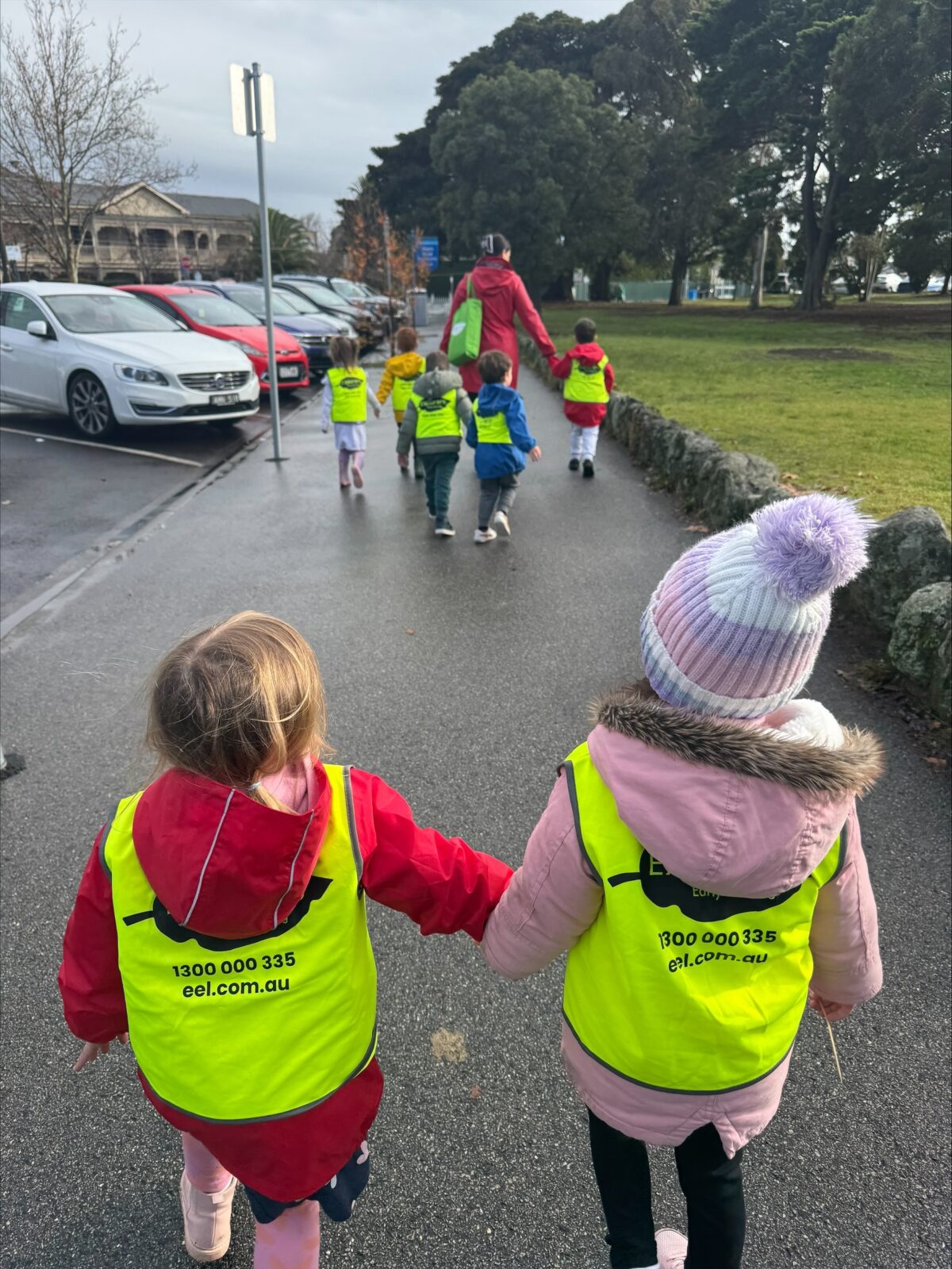
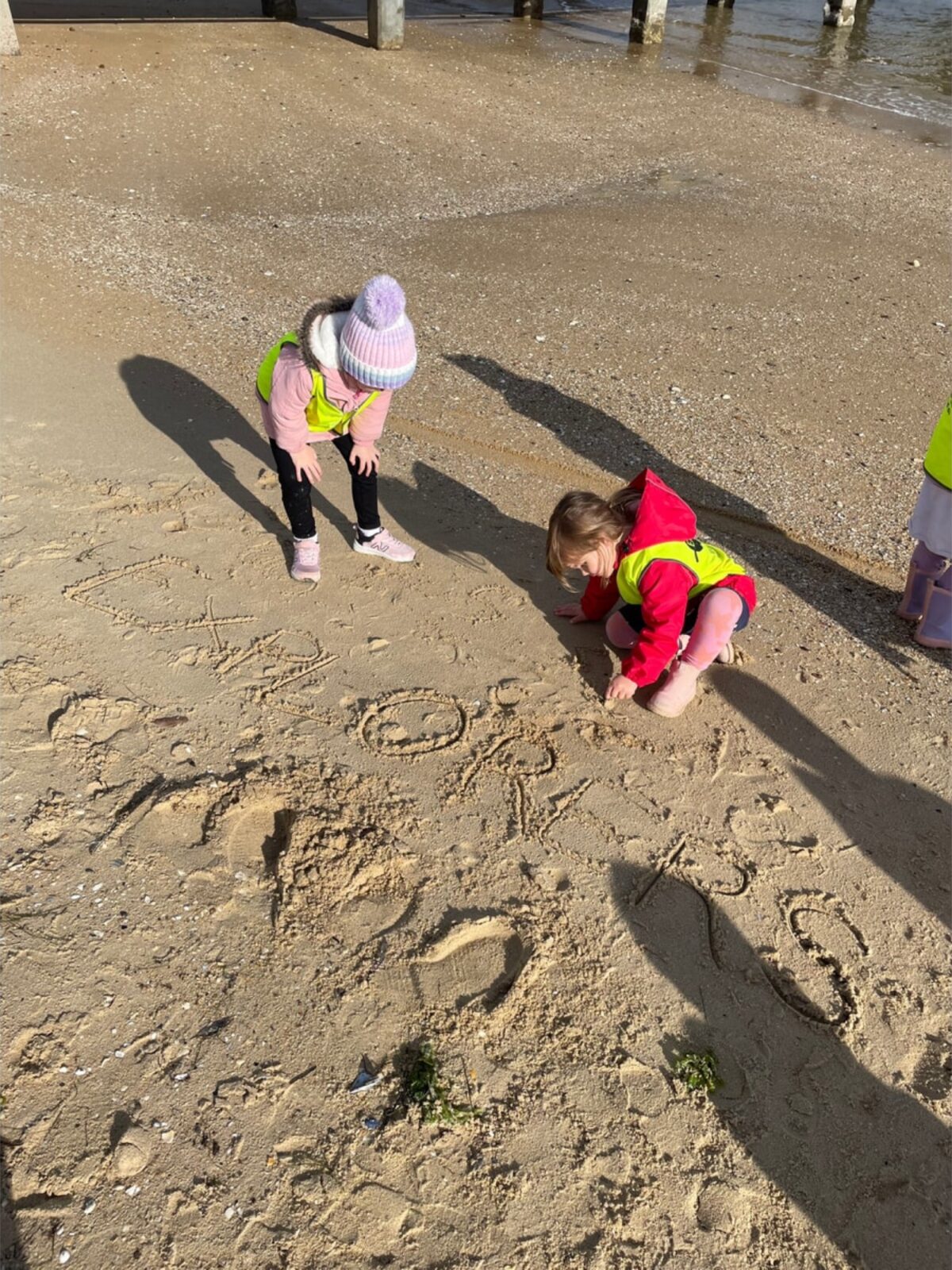
“Each week we notice something new. Whether it’s the tide changing the landscape, different shells washing up, or changes in the texture of the sand.”
Lauren has been a part of the Brighton East team since early 2023 and has seen firsthand how these outdoor excursions bring a whole new dimension to learning.
“Our Bush Kinder program has become a purposeful extension of our inquiry-based project and conceptual framework. It aligns seamlessly with our research focus on our imprint on ocean ecosystems.”
From the Centre to the Sea: A Day in Bush Kinder
For the children, a day of Bush Kinder is a big adventure – one that’s carefully planned and intentionally executed. What’s more, the learning doesn’t start at the beach; it begins long before the sand.
“The children are involved from the beginning,” says Edwina, Educational Leader at the centre. “We start in the classroom, asking what they’re curious about. We talk about road safety, how to catch the bus, and how to be respectful of the environment and each other.”
With safety gear in hand and high-visibility vests on, the children and Educators walk to the local bus stop to begin their journey. A short bus ride takes them to Middle Brighton, followed by a walk to the beach. Once there, the group gathers for an Acknowledgment of Country, grounding the experience in respect and connection to land and culture.
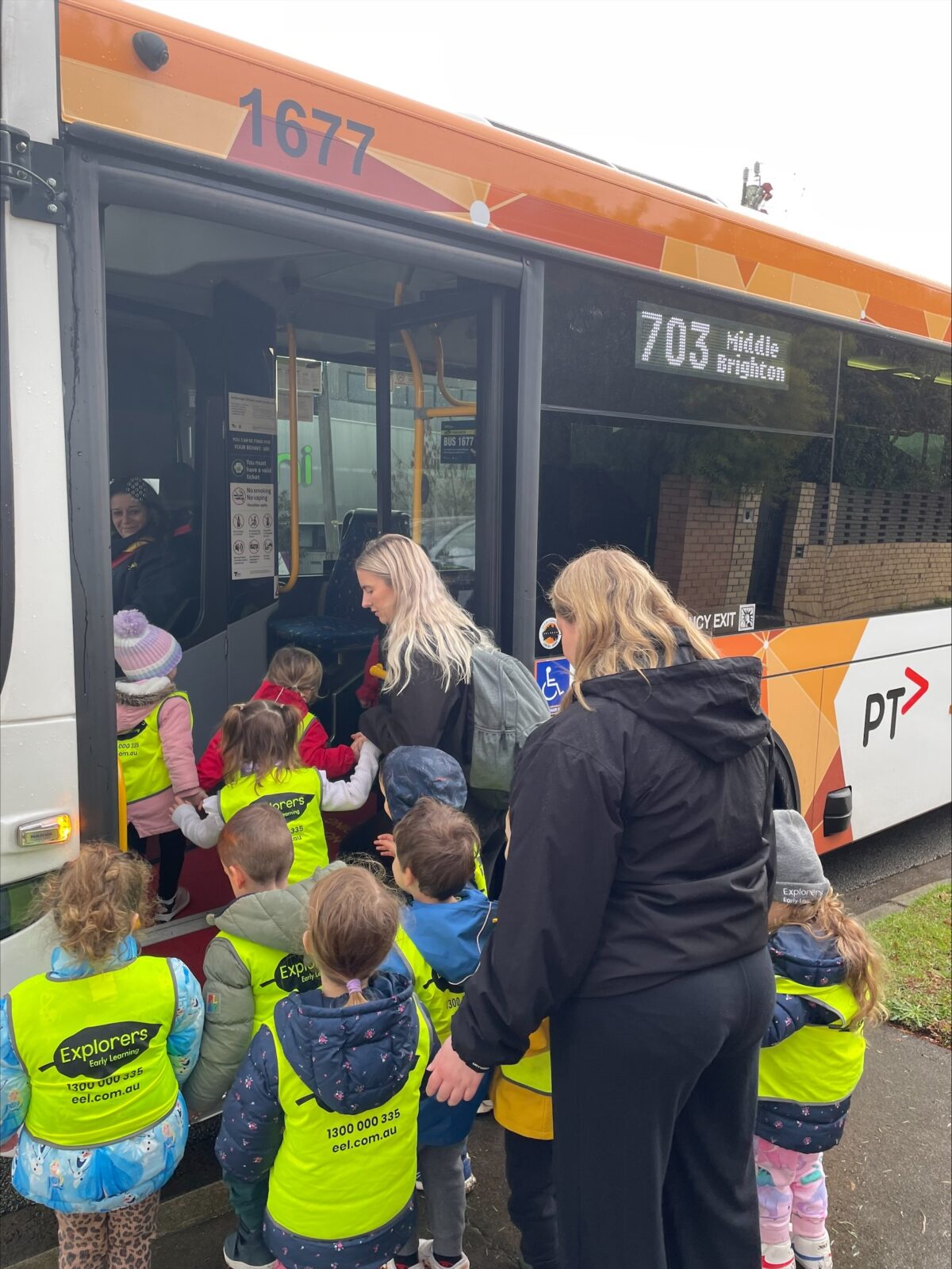
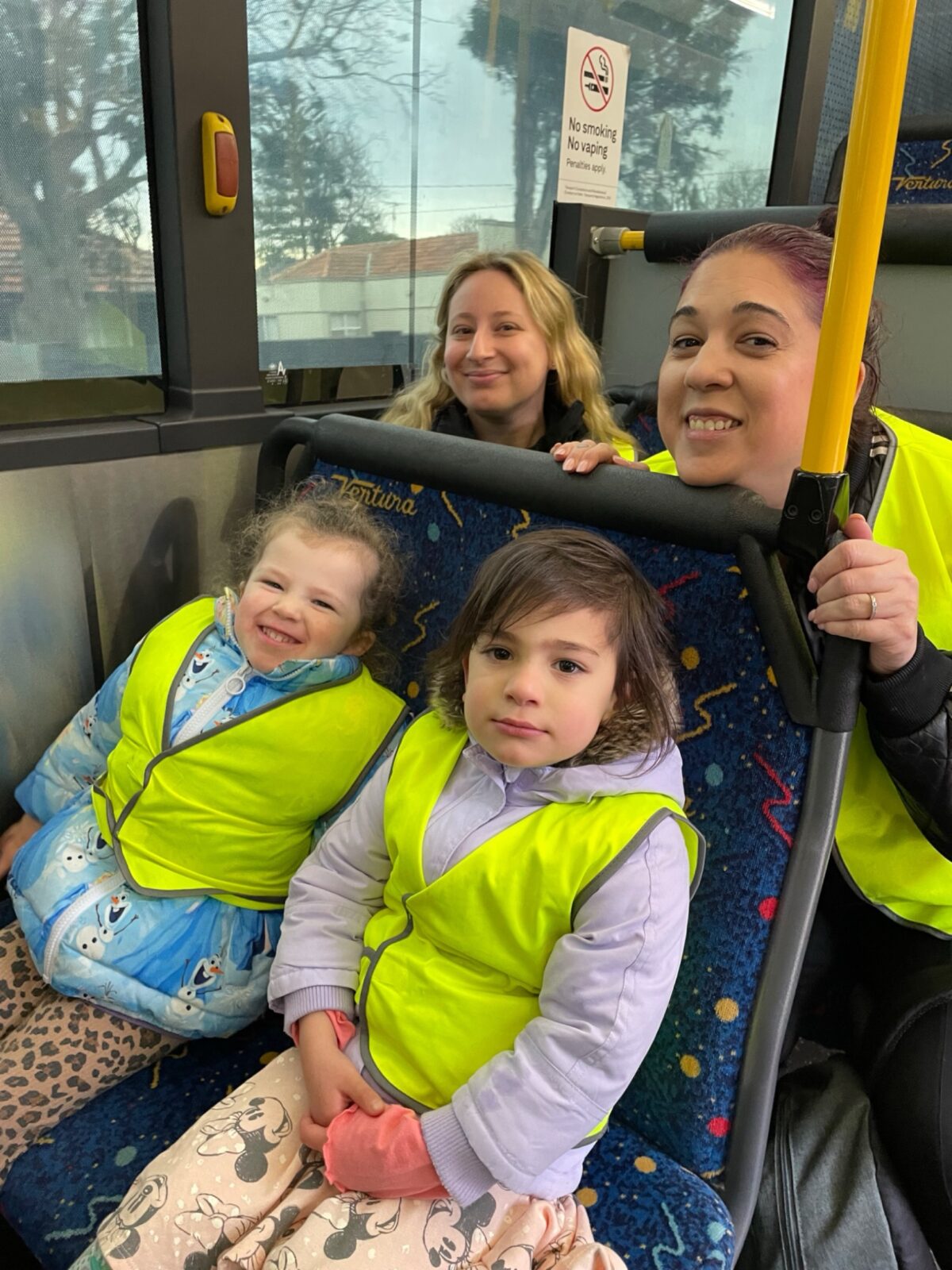
“There’s usually a pre-planned lesson,” Edwina explains. “It might be nature bingo, sketching the landscape in their workbooks, or counting the boats on the horizon. The learning is purposeful but flexible, it evolves with the children’s interests.”
After 45 minutes to an hour of learning, reflection, and snack time, the children begin their walk back. As they make their way back to the centre, the children often collect natural materials to investigate further once they return.
“Our journeys are just as meaningful as our time at the beach,” Lauren adds. “The children connect with community members, practice real-world skills like catching public transport, and learn how to navigate their environment with independence.”
A Shared Commitment to Joy and Inquiry
The beach excursions also reflect the centre’s deep commitment to joyful learning, a pillar of the Explorers Learning for Life curriculum.
“Bush Kinder ties into the ‘joy aesthetics’ of our approach,” Edwina explains. “There’s beauty in learning outside, in the way light reflects on water, in the laughter as children splash at the shore. It’s about engaging the senses and the soul.”
This joy is evident in the children’s faces. Whether they’re sketching shells, gathering seaweed for science experiments, or simply running barefoot through the surf, the images tell a compelling story of education at its most vibrant.
Lauren adds: “There’s a sense of magic when we arrive at the beach. The children are fully immersed, without distraction. It’s a space where learning feels natural, not forced.”
Learning Through Nature & Nurture
Bush Kinder at Brighton East is about more than exploration. It’s a powerful tool for holistic development. Whether it’s climbing a tree or using natural materials in creative play, the program supports physical, emotional, and cognitive growth.
“Children engage in risky play, which helps build resilience and confidence,” says Lauren. “They’re free to explore, collaborate, problem-solve, and express themselves in a variety of ways.”
This aligns strongly with the Reggio Emilia Approach, a foundational philosophy of the Explorers Early Learning curriculum. Reggio sees children as competent, capable learners who deserve agency in their own education. It places equal value on the child, the educator, and the environment, known as the ‘third teacher’.
“Bush Kinder really reflects that,” Edwina notes. “Children lead their own learning through inquiry. The beach becomes a giant, living classroom where their curiosities are taken seriously.”
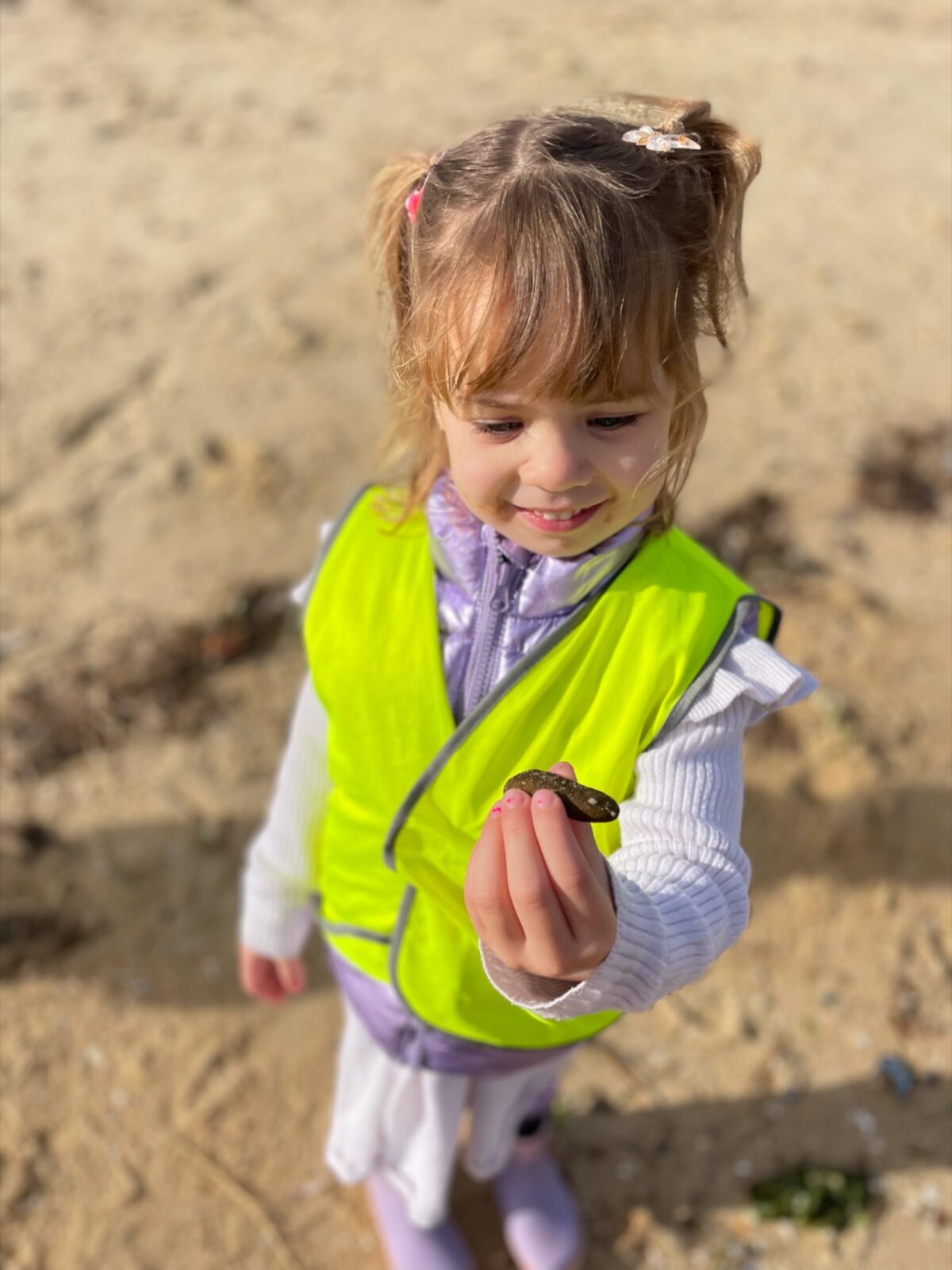
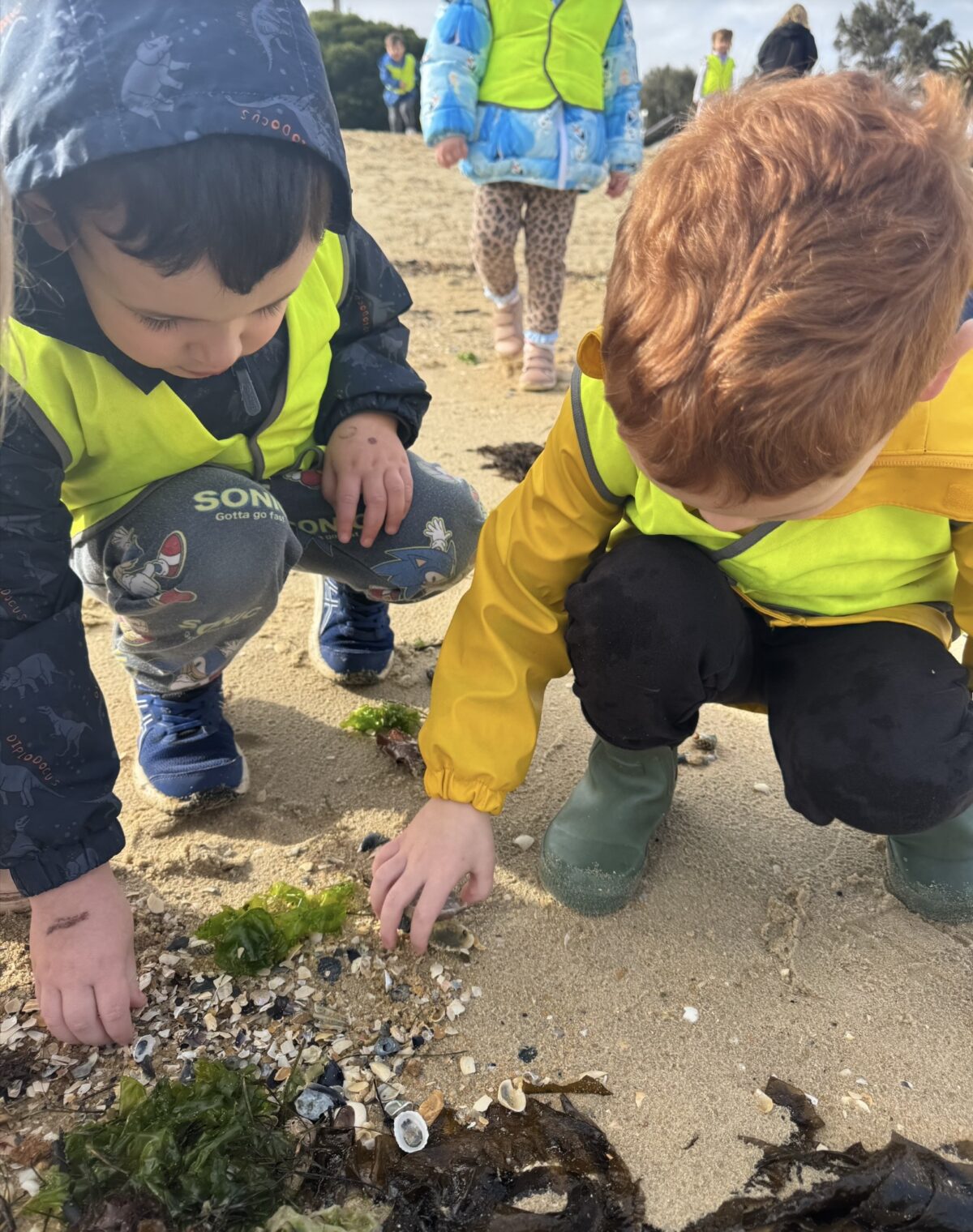
Indeed, many of the centre’s projects stem directly from questions raised during Bush Kinder. One group might begin an investigation into marine pollution after spotting plastic waste; another might launch a research project into tides or sea creatures. It’s education that’s relevant, responsive, and richly contextual.
Preparing for Life – Not Just for School
Another key advantage of the Bush Kinder program is how well it supports school readiness. Rather than relying on rote learning, the focus is on developing transferable life skills.
“Resilience, independence, self-regulation, and problem-solving are all fundamental to school readiness,” says Lauren. “At Bush Kinder, children develop these skills in real-world settings.”
From learning how to stay safe on public transport to confidently navigating a new environment, the experiences offered at Brighton East go far beyond traditional kindergarten preparation.
“The children are empowered,” Lauren adds. “They’re not just being told what to do, they’re making decisions, taking initiative, and building real confidence that will support them far beyond their early years.”
Connection, Community & Care
What also makes the program so impactful is how it nurtures a sense of connection. Connection to the land, the community, and each other. Every outing reinforces the idea that learning doesn’t happen in isolation. It’s relational, collective, and grounded in care.
“The children are learning to be citizens,” Edwina says. “They’re connecting with their local environment and understanding their place within it.”
This includes developing a strong sense of sustainability and responsibility. The children regularly collect litter from the beach, discuss the impact of boats and pollution, and bring their findings back to the classroom for further exploration.
“They’re learning that their actions matter,” Lauren adds. “That’s a powerful lesson at any age.”
The Explorers Brighton East Bush Kinder Program is a gateway to discovery. A place where children are given the respect, agency, and opportunities they deserve. With its innovative Bush Kinder program, strong pedagogical foundations, and access to the beach, it’s setting a benchmark for what early childhood education can, and should, look like.
“It’s a joy to watch the children grow in confidence, curiosity and care for the world around them. The beach isn’t just a destination, it’s a partner in their learning journey,” reflects Lauren.
To tour Explorers Brighton East or one of our other beautiful centres, please click here.
Otherwise, check out our website to register your interest at Explorers Early Learning today!
One Small Step, One Giant Leap: Is Your Child ‘Ready’ for Primary School?
Reading, writing, and sitting still. That’s all there is to prep, right? Well, not exactly. Read on for our full breakdown of all the essential skills your child needs to thrive in prep and beyond 👇
The transition between early childhood education and primary school is an exciting and sometimes challenging time for parents and children alike. It marks the next step in your child’s educational journey, and their first foray into the formal schooling system.
But with all the talk of ‘school readiness’ and the Victorian Government’s upcoming ‘Pre-Prep’ program, how can you really know if your child is mentally and emotionally prepared for the big first day?
In this post, we break down the key developmental areas to keep an eye on in the days, weeks, and months before the first day of prep!
What Age Do Children Start Prep in Victoria?
In Victoria, children need to turn 5 years of age by 30 April of the year that they start school. Alternatively, children must be at school in the year that they turn 6 years of age – this is the compulsory school starting age.
Additionally, parents have several options for schooling depending on location, fees, religious preferences, and educational philosophy:
- Government schools
- Private schools
- Language schools
- Specialist schools
- Distance education
- Home schooling
More than Reading and Writing
Once your child is enrolled, it’s important to remember that the essentials for primary school extend far beyond reading, writing, and sitting still. Rather, children grow and develop in a number of key growth areas, such as independence, emotional maturity, and sociability.
Therefore, try a holistic approach to gauging your child’s ‘readiness’ for primary school. Every child is unique with individual skills, passions, and ways of learning. In other words, no two children are exactly alike.
So, get a feel for your child’s development in the following areas, and be sure to discuss these with your Kinder teacher leading up to the first day.
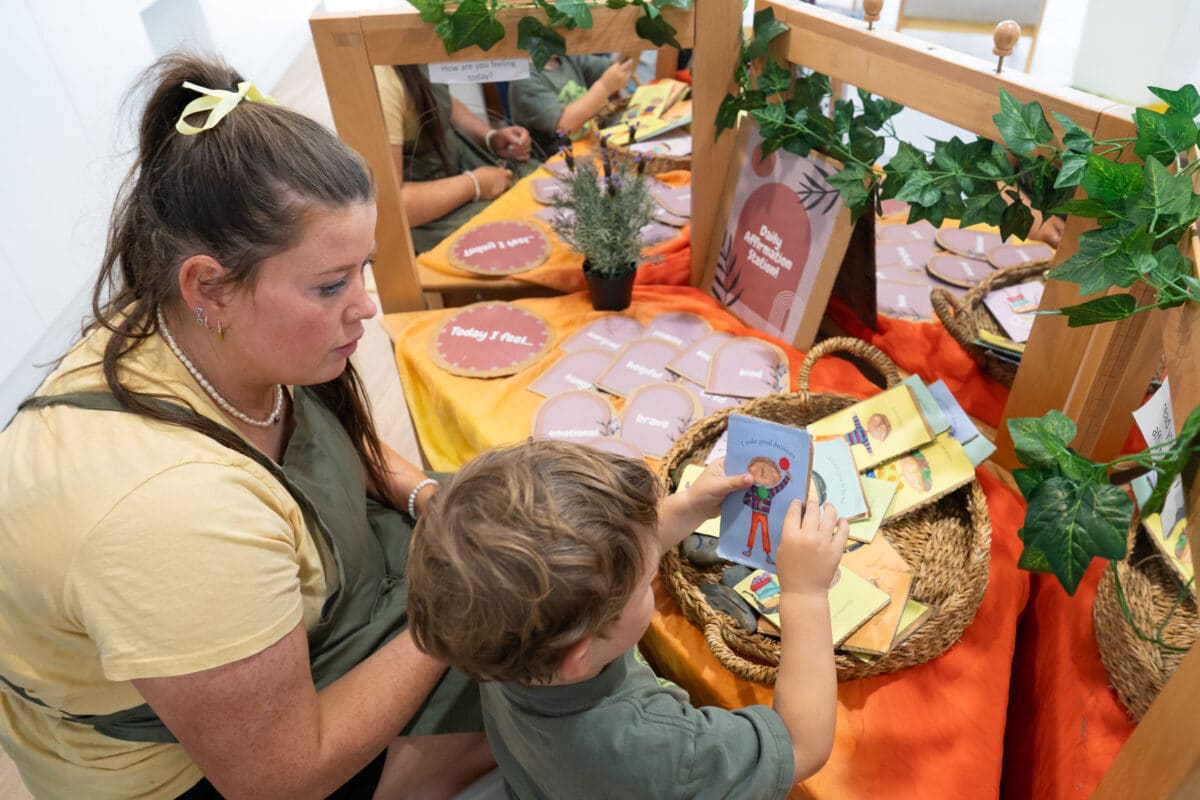
Social Skills and Independence
Is your child getting along with other children? Do they stand up for themselves or others? Sociability is a vital skill for children entering primary school, and one that experts suggest is improved with quality early childhood education. Social skills form the foundation of conversation, compromise, and relationship bonding.
Without established social skills, children may struggle to adapt to the primary school environment where children grow physically and psychologically with their peers. Some signs your child is displaying social skills leading into primary school include:
- Sharing toys
- Organising games and making friends on their own
- Role-playing as adults through games like ‘mummies and daddies’, ‘superman’, or ‘cooking’ in a dramatic play area
- Asserting themselves (even being a bit bossy!)
- Going to the toilet on their own (including using toilet paper properly and flushing the toilet)
Emotional Maturity
Can your child regulate their emotions with minimal adult intervention? Essentially, emotional maturity highlights a child’s ability to empathise and identify emotions in others, while also expressing their own in healthy ways – this doesn’t mean bottling everything up!
According to the Australian Early Development Consensus, children’s ‘ability to understand their emotions helps children to empathise with others.’ Therefore, children who display emotional maturity ‘can infer the feelings of others and respond in prosocial ways that demonstrate that they care for other people and value relationships.’
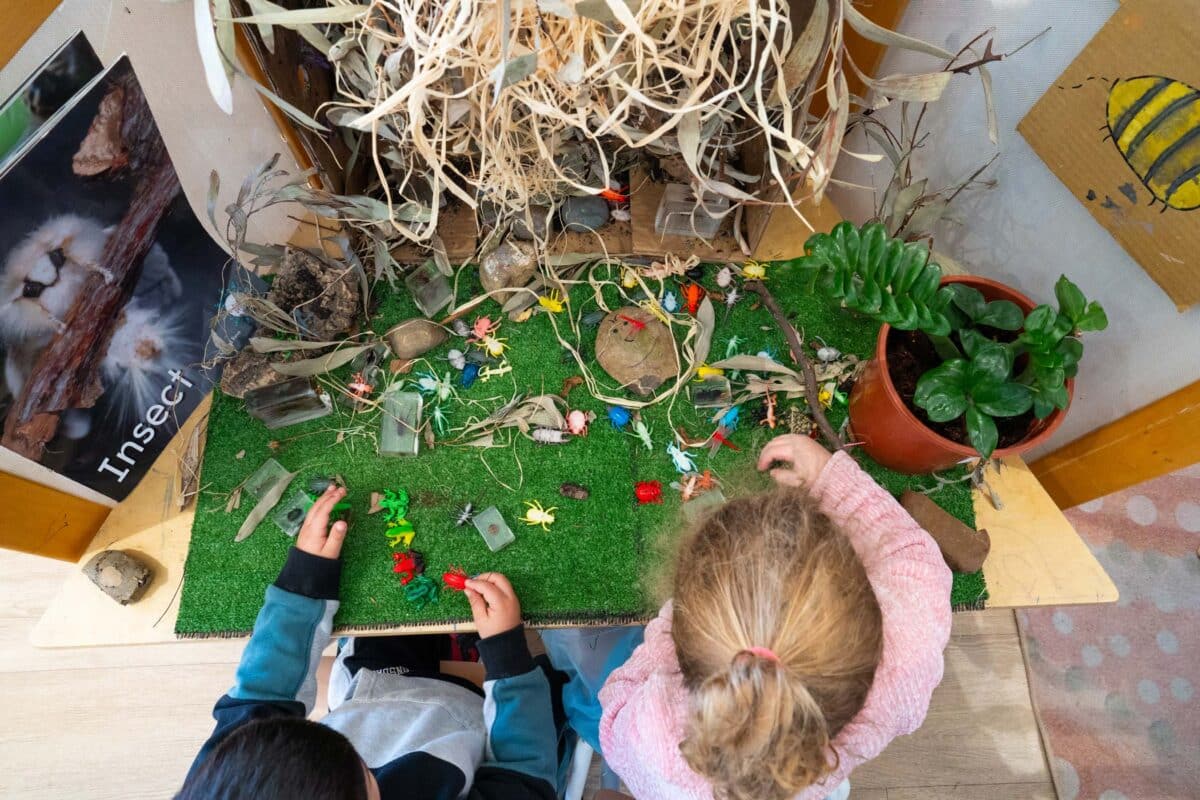
Language Skills
Language skills are so much more than a child’s ability to speak and enunciate their vowels. Rather, a vital component of language skills is children’s ability to listen and collaborate with others. These interpersonal skills equip children with the tools to:
- Express and understand complex emotions
- Think and learn for themselves
- Problem solve
- Develop and maintain long-lasting relationships
Cognitive Skills
Reading and writing are just two of the many cognitive skills expected in primary school. Cognitive skills strengthen children’s ability to absorb and critically analyse information, so it’s more than just remembering that two plus two equals four.
Rather, cognitive skills allow children to:
- Focus on mentally strenuous tasks
- Analyse information
- Compare and evaluate
- Problem solve
- Grasp cause and effect
However, it’s important to keep in mind that not all children learn at the same rate or in similar ways. Some children thrive with mathematical concepts, while others learn from artistic or abstract activities. Be sure to speak with your child’s Kinder teacher if you have any concerns.
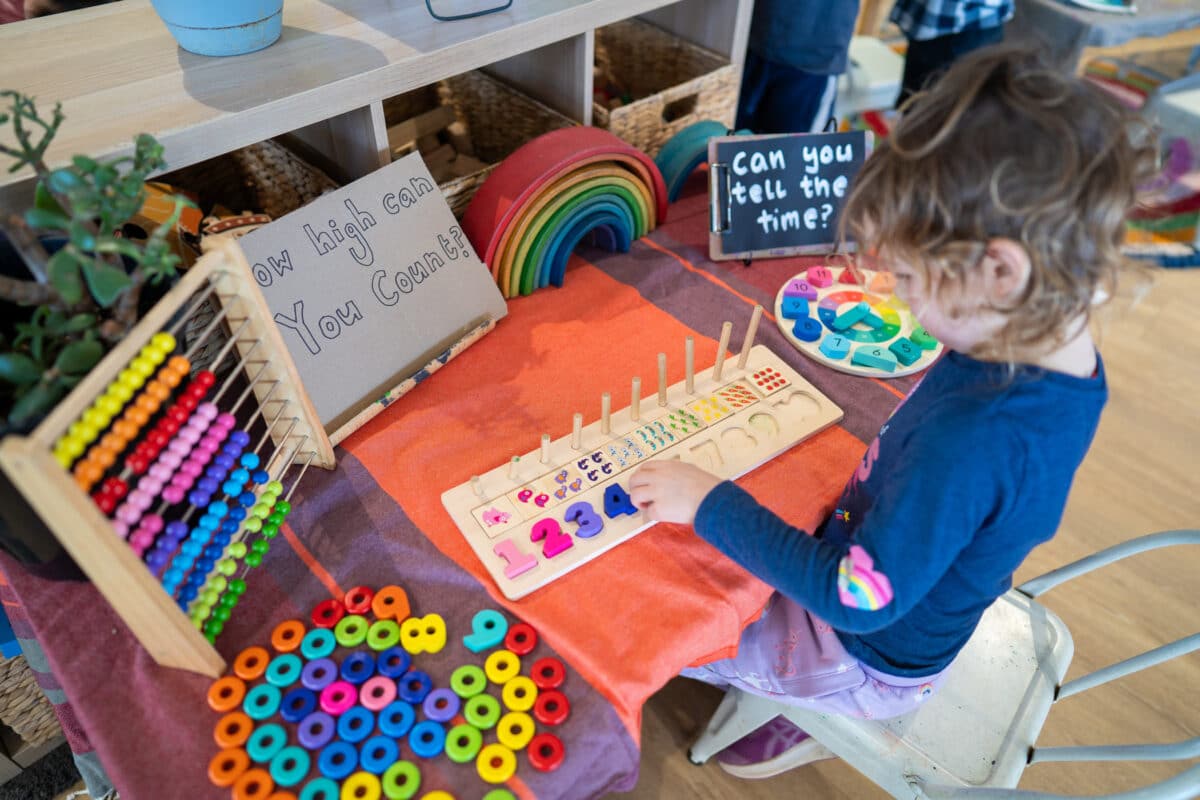
Fine and Gross Motor Skills
The ability to touch, feel, and manipulate objects is one of the most important skills for children. It’s an extension of their independence in a tangible, physical way. Therefore, children’s fine and gross motor skills are vital for success in academic and social development.
According to the Early Years Learning Framework, ‘Physical activity and attention to fine and gross motor skills provide children with the foundations for their growing independence and satisfaction in being able to do things for themselves.’
In other words, children need to interact with the world around them, whether that be through drawing, writing, moulding, solving puzzles, or playing with toys.
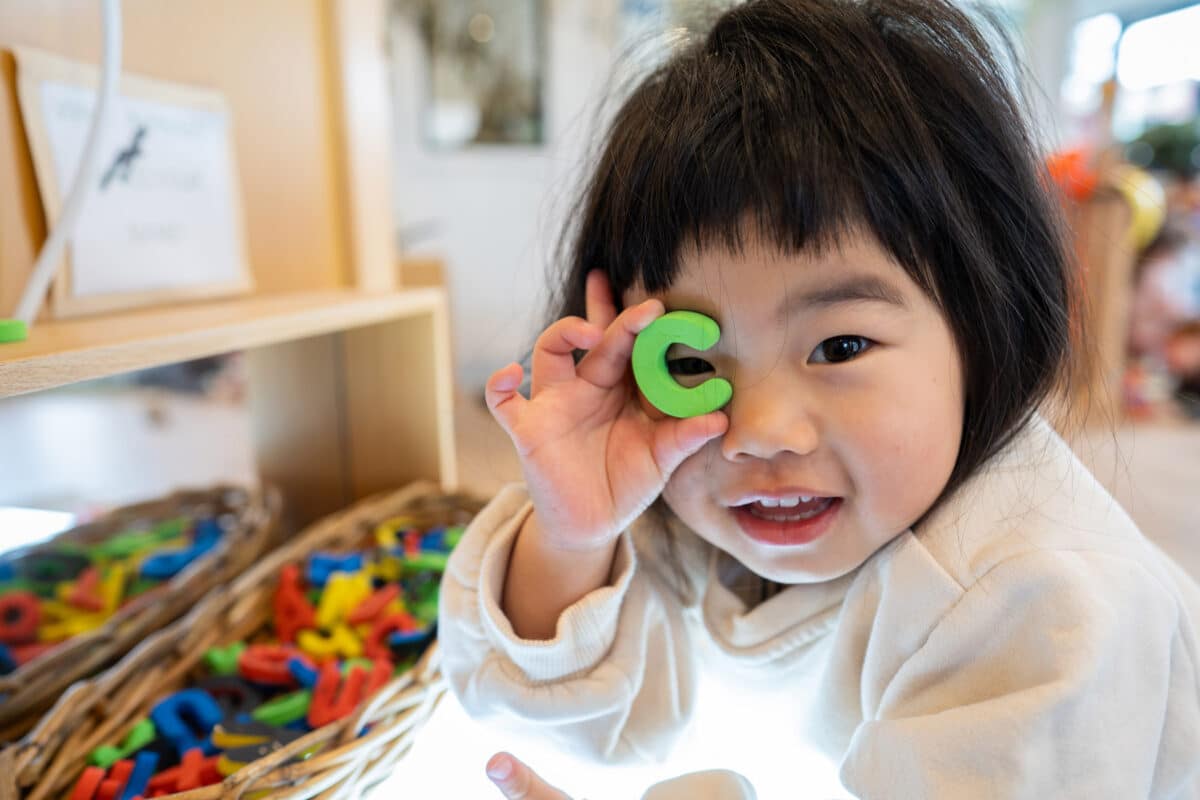
Ultimately, as your child embarks on the exciting transition from Kinder to primary school, it’s vital to consider readiness beyond academics. Social skills, emotional maturity, language proficiency, cognitive abilities, and motor skills all contribute to a well-rounded preparation that’ll ease those first day worries. Therefore, nurturing these aspects ensures a smoother transition and sets the stage for a fulfilling educational journey and a lifelong love of learning.
🍃 To tour one of our beautiful Centres, please click here. Otherwise, check out our website to register your interest at Explorers Early Learning today!
Why Nutrition is Everything for Toddlers
Is your toddler getting all the nutrients, vitamins, and minerals they need? And what do they need anyway? In this post, we break down why a well-balanced diet is everything for toddlers 👇
A balanced diet with all the necessary macronutrients (protein, carbohydrates, and fats) and micronutrients (vitamins and minerals) are the building blocks of a healthy body and mind. After all, there’s a reason you heard ‘if you don’t eat your veggies, you won’t grow up big and strong’ as a child on repeat.
Therefore, it’s vital to embed healthy eating habits and proper nutrition from an early age to ensure the best chance for success later in life.
In this post, we break down why nutrition is everything for toddlers. We’ll also provide some handy tips to get your toddler eating their fruit and veg!
How Much Protein Does my Toddler Need?
Toddlers need around 13g of protein daily, or roughly 15-25% of their diet. Protein is a vital macronutrient as it contains essential amino acids. While you’re probably familiar with its muscle building effects, protein is a part of every cell in the human body! It builds and repairs skin, nails, and even hair. Additionally, protein helps maintain a healthy weight, curb hunger, and repair injuries.
Some high-protein foods for toddlers include:
- Lean meats
- Dairy products
- Poultry
- Fish
- Eggs
- Beans
- Tofu
- Seeds
- Nuts
- Chickpeas
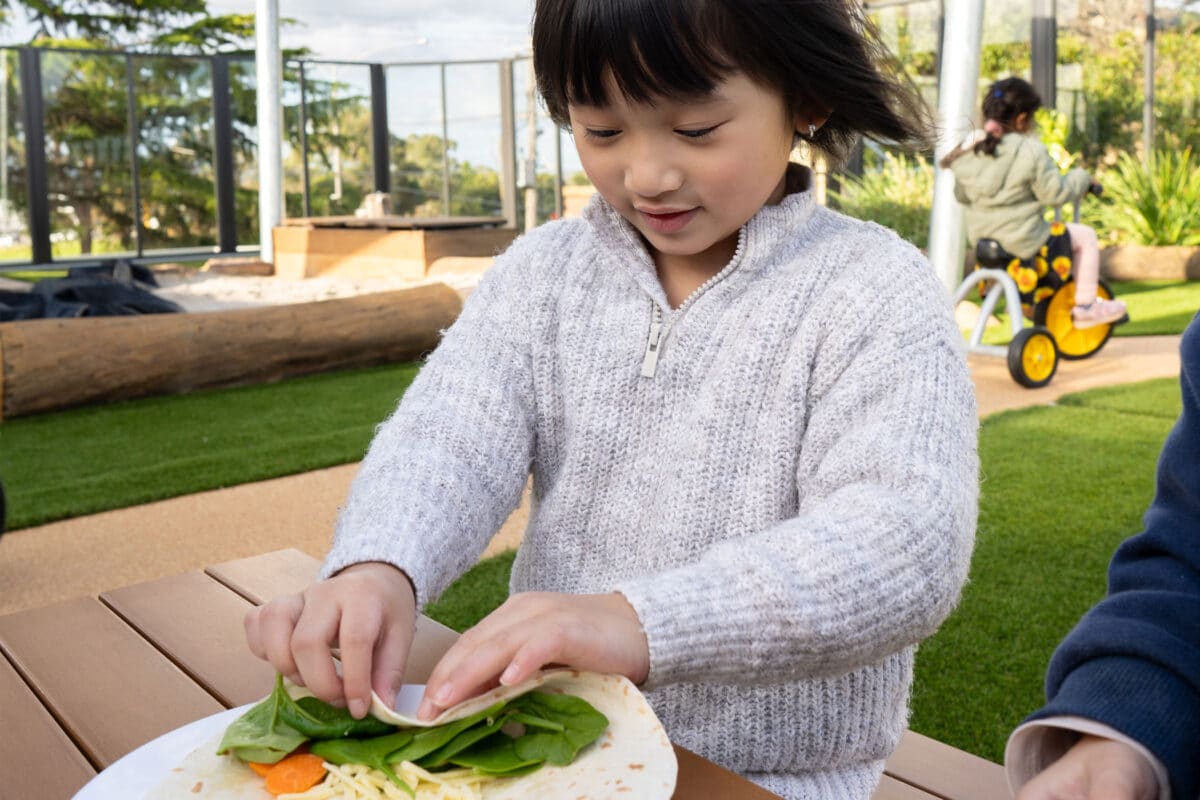
How Many Carbs Does my Toddler Need?
Paediatric experts recommend toddlers get around 45-65% of their diet from carbs. However, it’s essential to be mindful of the sources and quality of carbohydrates. Importantly, there are two types of carbs: simple and complex.
Simple carbs (or simple sugars) contain only one or two types of sugar, while complex have many. Sugary foods, fruit, and soft drinks contain simple carbohydrates which are quickly broken down into energy. This is why you might find your toddler bouncing off the walls on a sugar high.
Conversely, complex carbs, such as starches and fibre, break down slowly as they’re made up of many chains of carbs. Therefore, complex carbs release energy slowly and are less likely to spike blood sugar, hence avoiding those dreaded sugar crashes.
While some simple carbs are naturally occurring, experts recommend avoiding processed foods and drinks with added sugar entirely for children under 2, and preferably well into childhood and adolescence. Instead, reach for whole foods to boost your toddler’s energy.
Foods rich in complex carbohydrates include:
- Whole grains (whole wheat bread, whole grain pasta, brown rice)
- Pulses (lentils, chickpeas, pinto beans, kidney beans)
- Starchy vegetables (potatoes, corn, peas)
How Much Fat Does my Toddler Need?
According to recent studies, fats should make up around 30-40% of a toddler’s diet. However, there are different types of fat to keep in mind, both healthy and not so healthy.
Firstly, there are two kinds of healthy fats. These fats derive from natural sources and should be consumed on a regular basis for brain function, hormone balance, and energy:
- Monosaturated fats (nuts, avocado, canola oil, olive oil, sesame oil)
- Polyunsaturated fats (fish, sunflower seeds, flaxseed oils, soybean)
Additionally, while not necessarily healthy or unhealthy, saturated fats should be consumed in moderation:
- Saturated fats (beef, pork, poultry, full-fat dairy products, eggs)
Lastly, trans fats (or trans fatty-acids) should be avoided entirely. In fact, the World Health Organisation recommends limiting trans fats to less than 1% of total energy intake. In several cities around the world, such as New York City, trans fats have been severely limited or outright banned and there’s a growing movement in Australia to follow suit.
Trans fats can be naturally occurring but are most often industrially made. You’ll find trans fats in highly processed foods which offer little to no nutritional value to you or your child. Additionally, a diet high in trans fat has been regularly linked to an increased likelihood of heart disease, stroke, and type 2 diabetes.
- Deep fried foods
- Fast food
- Commercially baked goods (cakes, biscuits, pies, muffins, etc.)
- Frozen food (pizza, nuggets, ice cream, etc.)
- Potato chips
- Butter and margarine
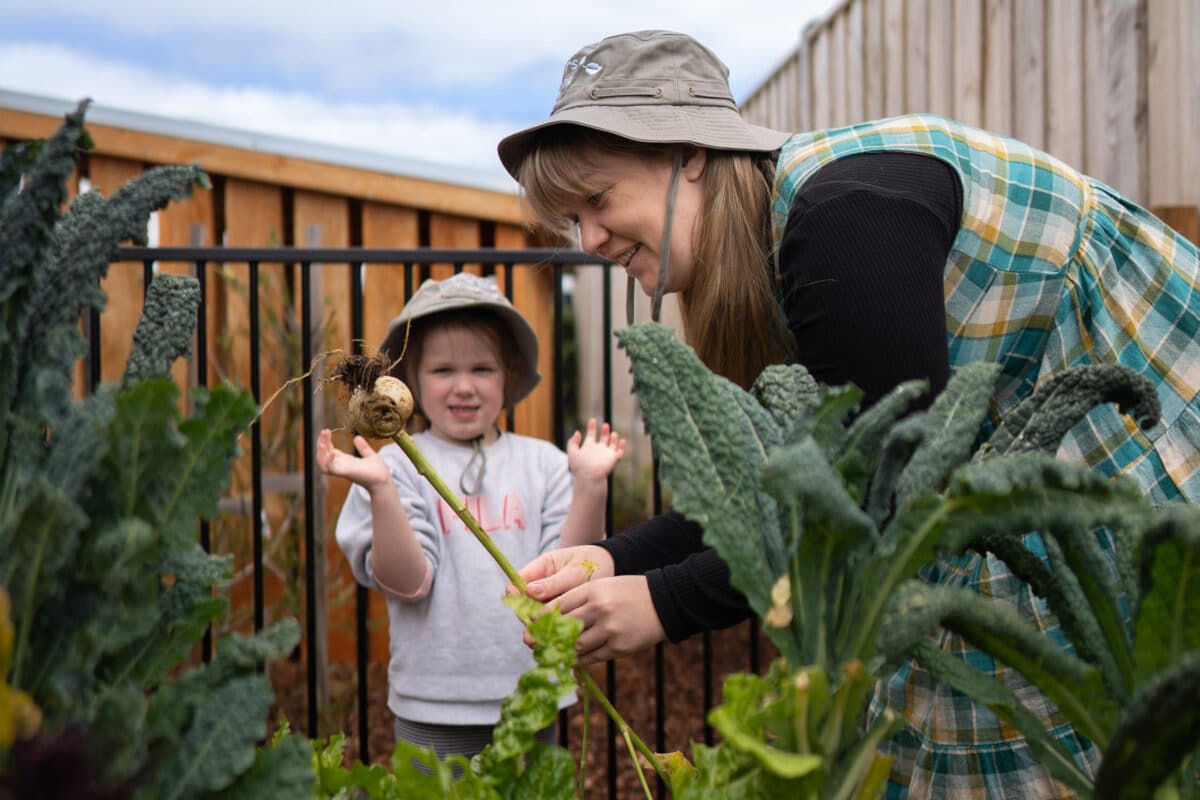
Micronutrients
What are the Essential Vitamins for My Toddler?
Vitamins are essential for toddlers to boost the immune system and strengthen cell function. Likewise, vitamin deficiency can lead to lower energy levels and may affect children’s development. Therefore, if you suspect your toddler may have a vitamin deficiency, consult your GP or a healthcare professional. Rest assured, these deficiencies are common and often easily treatable.
There are seven vitamins needed for healthy growth:
- Vitamin A (eggs, fish, sweet potatoes, spinach)
- Vitamin B (whole grains, poultry, fish)
- Vitamin C (citrus fruits, tomatoes, potatoes)
- Vitamin D (fortified milk and cereals, fatty fish, sunlight)
- Vitamin E (vegetable oils, leafy green veggies, nuts)
- Vitamin K (eggs, milk, broccoli)
- Folate (beans, fresh fruits, beans, sunflower seeds)
What are the Essential Minerals for my Toddler?
Minerals are key for building strong bones and teeth. While vitamins help the body’s functions, minerals help the body’s structure. Similarly, mineral deficiencies are also commonplace, especially with fussy eaters. So, be sure to contact a healthcare professional if you’re concerned and they can take the necessary steps.
Essential minerals include:
- Calcium (dairy products, fortified cereals, leafy greens)
- Iodine (dairy products, chicken, iodised table salt, seaweed)
- Iron (red meat, poultry, seafood, nuts, dried fruit, leafy greens)
- Zinc (beef, oysters, pumpkin seeds, rolled oats)
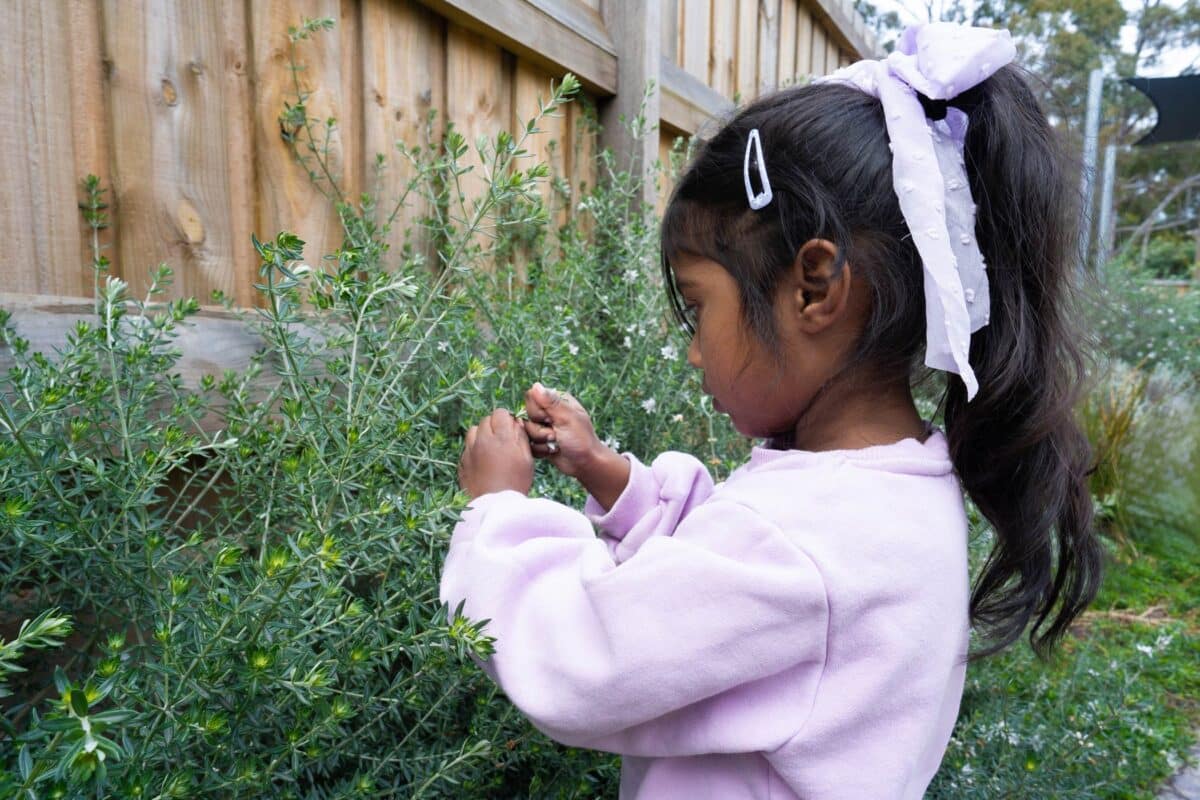
Tips to Get Your Toddler Eating Healthy
While it’s handy to know what your toddler needs to eat, for some the battle is just getting the food into their mouths in the first place. We’ve compiled a few handy tips to get your child eating more, and some ways you can incorporate healthy foods into healthy habits:
- Don’t serve too much – this one might sound obvious, but only serve what your toddler will eat. Forcing children to ‘clean their plate’ when they’re not hungry can impact their ability to read hunger cues, make healthy eating choices, and listen to their body. It also prevents food waste!
a) 1-2 year olds: let them decide how much they want to eat. Importantly, think about how much your child eats over the course of a week, rather than day-by-day. This is because toddlers appetite wanes often, which is okay!
b) 3-4 year olds: offer a wider variety of healthy foods. Likewise, give them the choice to eat or not, but be sure to include foods from the five food groups. - Offer variety – toddlers often refuse to eat as a way to express control. Therefore, food choices offer fussy toddlers a compromise. Something as small as choosing between mashed potatoes and mashed pumpkins can be a huge boost for a toddler’s sense of agency.
- Get creative with consistencies – dips, dips, dips! By using hummus, yogurt, or blended veg, you can make healthy eating a more fun and interactive experience for toddlers. Additionally, it’s an opportunity to strengthen fine and gross motor skills.
- Make a routine – children thrive off structure, so be sure to encourage family mealtimes at the same time every day (where possible) can ease stress and anxiety around mealtime.
Overall, getting enough macro and micronutrients is essential for babies and toddlers alike. Whether it’s for brain health, bone strength, the immune system, or making sure everything is working just right, a balanced diet is a must for growing bodies. With these facts and tips in mind, you can ensure your child is getting all the building blocks they need for a healthy and fulfilling life.
🍃 To tour one of our beautiful Centres, please click here. Otherwise, check out our website to register your interest at Explorers Early Learning today!
Free Kinder and Kindergarten Funding: What’s the Difference?
What exactly is Free Kinder? And what’s Kindergarten funding? In this post, we spilt the difference between these often confused early childhood initiatives 👇
Early childhood education is the first step in ensuring academic (and lifelong) success for your child. Therefore, Kindergarten should be at the front of mind if your child is three or four-years-old.
However, there’s some confusion in Victoria around the different kinds of Government subsidised Kindergarten programs. Particularly, between ‘Free Kinder’ and ‘Kindergarten funding’.
Despite sounding similar, there’s a big difference between the two so to support families and clear up any misconceptions, we’ve outlined the differences between the often conflated Free Kinder and Kindergarten funding.
What is Kindergarten?
Kindergarten is the two years of early learning before your child begins primary school and is more commonly known as three and four-year-old Kindergarten.
Kindergarten programs are play-based and run by qualified Kindergarten teachers who hold a graduate diploma, bachelors degree, or masters degree. While these programs incorporate play-based learning, they emphasise essentials such as literacy, numeracy, social skills and emotional development.
In Victoria, these programs are guided by the Victorian Early Years Learning and Development Framework (VEYLF).
Kindergarten can be integrated into a long day care program at an early learning centre, or run as sessional programs at a church, community centre, or standalone Kindergarten service (this could include three-to-five hour blocks over a few days a week).
For a full breakdown of the difference between long day care and sessional Kindergarten, check out our blog post here.
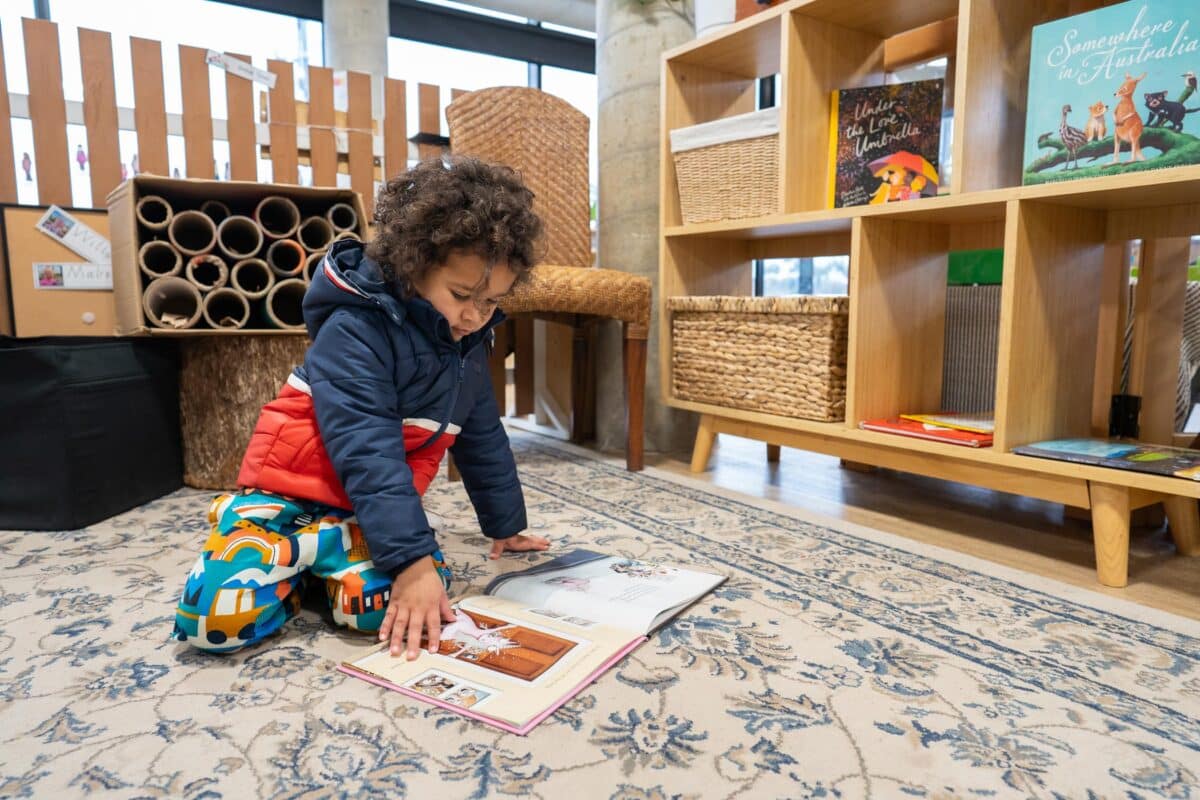
What is Kindergarten Funding?
Firstly, Kindergarten funding is not the same as Free Kinder. Rather, Kindergarten funding takes the form of subsidies provided directly from the Government to the childcare service you’ve nominated.
Therefore, when you enrol your child into Kindergarten, you are required to ‘claim funding’ with only one Kindergarten service. The Government will then allocate funds directly to that service.
These funds are used to directly benefit and enhance the service’s Kindergarten program. This can be done in several ways, such as:
- Employing staff members to directly deliver the funded Kindergarten program
- Kindergarten staff professional development
- Resources and equipment used for the funded Kindergarten program
- Excursions and incursions related to the funded Kindergarten program
- Extra support for educationally disadvantaged children
- Parental engagement
- Transition in and out of Kindergarten
- Specialist programs (e.g. music, science, languages)
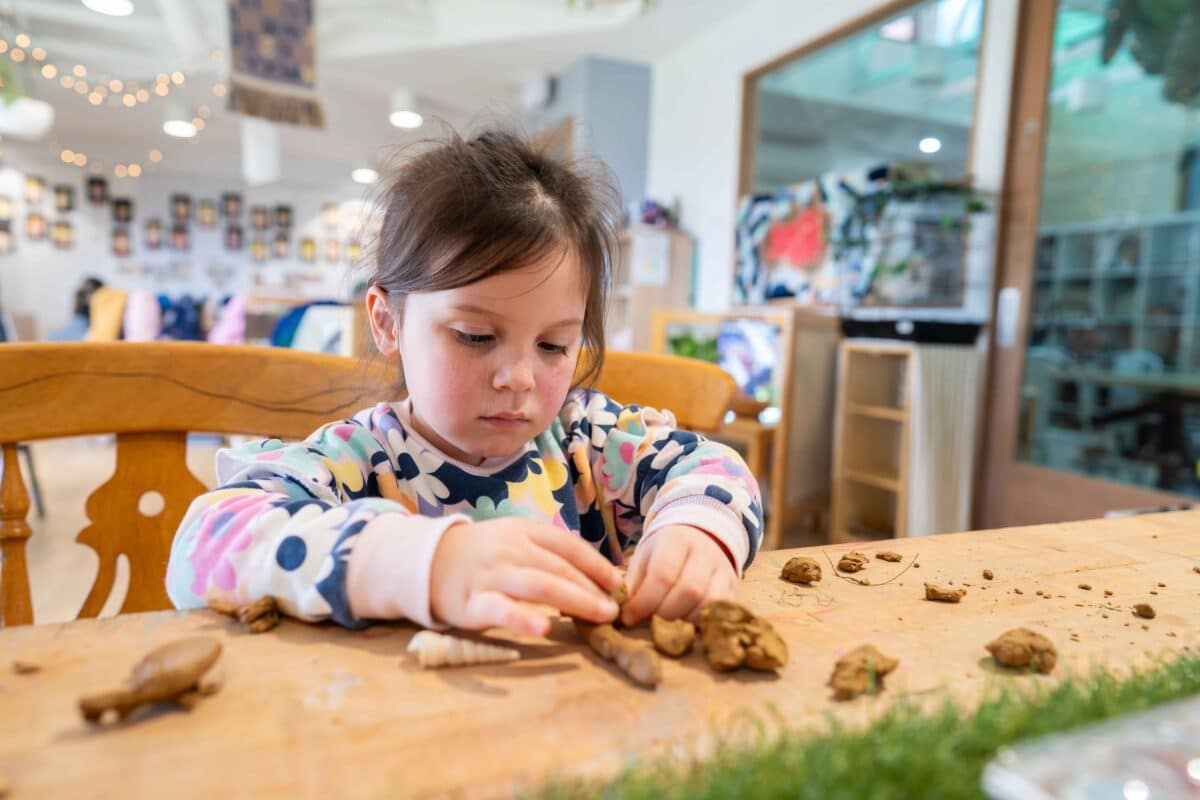
What is Free Kinder?
There’s a lot of confusion around what exactly is meant by ‘free’ Kinder.
In simple terms, ‘Free Kinder’ supports families to access a funded Kindergarten program by providing a discount of up to $2,500 per year to offset the out-of-pocket cost of your fees.
So, if your child attends less than $2,500 worth of Kindergarten in a calendar year, it is technically free Kindergarten.
Free Kinder at Explorers
If your child attends a long day care centre, such as Explorers, Kindergarten is integrated into the long day care program (if your child is three or four-years-old). You will receive the Free Kinder discount in the form of Free Kinder Credits.
These Credits act as a discount on your childcare fees, alongside any Child Care Subsidy (CCS) entitlements. Ultimately, this will reduce your out-of-pocket Kindergarten expenses.
As with all Free Kinder subsidies, Credits rely on the hours your child spends in the Kindergarten program.
In 2024, the State Government boosted the Kindergarten funding figures:
- Four-year-old Kindergarten children must be enrolled for at least two days per week and the funding covers 15 hours, totalling up to a maximum $2,050 for the year.
- Three-year-old Kindergarten children can access 7.5 hours (maximum $1,025) or 15 hours (maximum $2,050) depending on days of attendance and Kindergarten teacher placement.
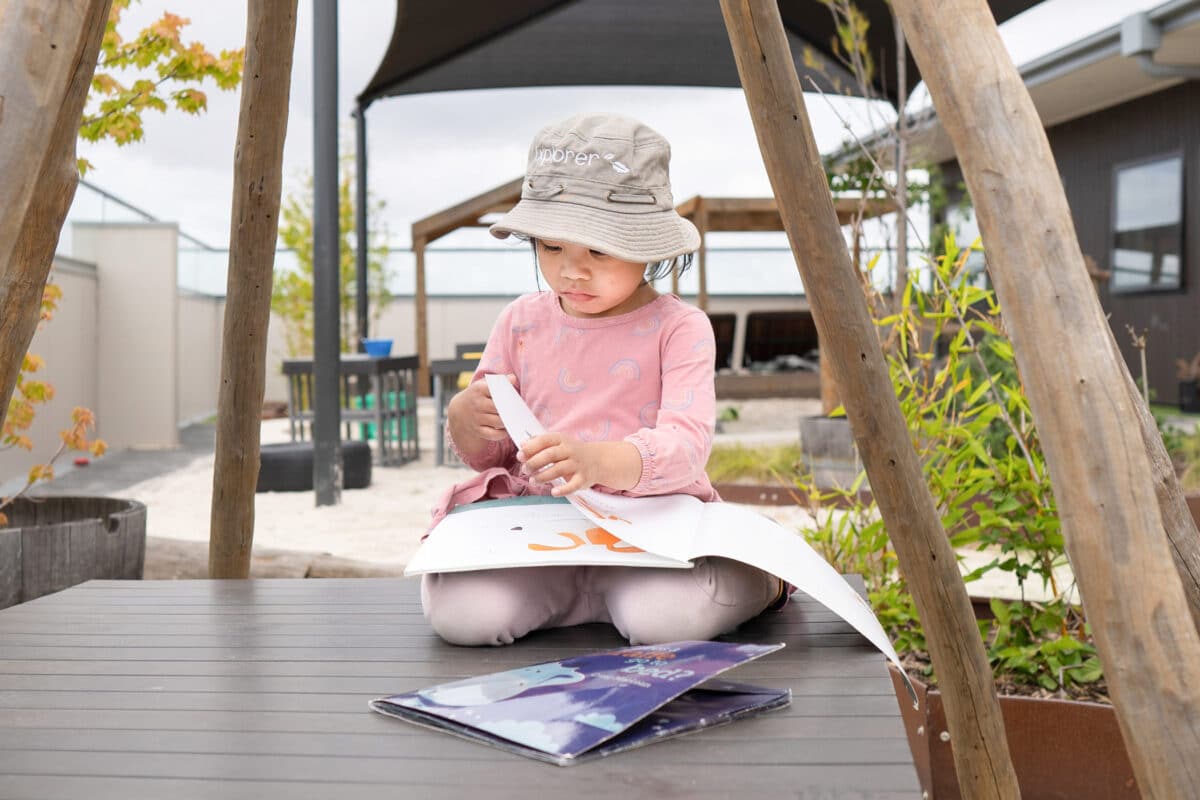
Free Kinder and Kindergarten funding are two incredible Government subsidised programs which are designed to enhance the quality and accessibility of Kindergarten. Over the next decade, the scale of Free Kinder and Kindergarten funding is planned to vastly expand.
By 2032, the State Government has proposed for regional areas to be better represented, accessibility for all families to be increased, and the hourly caps and Free Kinder discounts to be raised.
Furthermore, the Australian Government will be rolling out some major changes to the Child Care Subsidy (CCS) throughout 2025 and 2026, including the introduction of a new ‘3 Day Guarantee’ scheme.
Eager to know more about these CCS updates? Check out the our Explorers blog post here that breaks down everything you need to know.
🍃 To tour one of our beautiful Centres, please click here. Otherwise, check out our website to register your interest at Explorers Early Learning today!
25 STEAM-Themed World Space Week Books for Toddlers
Paper mâché planets and homemade star maps can only mean one thing – it’s Space Week! To celebrate this astronomical event, we’ve compiled our list of must-read STEAM books to get your toddler thinking big 🚀
World Space Week is the largest space event in the world with more than 11,221 events in 87 nations. Celebrated annually between October 4 – 10, Space Week is the perfect opportunity to ignite your child’s curiosity.
While experiments and trips to the museum are fun ways to get into the Space Week spirit, the first step is to get your toddler thinking big. And what better way than to dive into the wide world of books?
In this post, we’ve listed our top Space Week books which are fun and educational. Whether your child is a budding inventor or the next H.G. Wells, there’s something on this STEAM (science, technology, engineering, arts, maths) list for everyone!
Science
Children love science. From dazzling chemical reactions to mind-boggling facts about the Milky Way, it’s no wonder that children get lost for hours in these captivating reads. Additionally, a keen interest in science boosts children’s curiosity and imagination, so it’s always worth encouraging.
Whether it’s exploring the solar system, physics, or ecosystems, there’s so many science books to choose from:
- 8 Little Planets by Chris Ferrie, illustrated by Lizzy Doyle
- The Solar System: A Lift-the-Flap Book by Steven Wood
- Big Ideas for Little Environmentalists: Ecosystems with Rachel Carson by Maureen McQuerry, illustrated by Robin Rosenthal
- ABCs of Physics by Chris Ferrie
- Priddy Explorers: Space by Roger Priddy
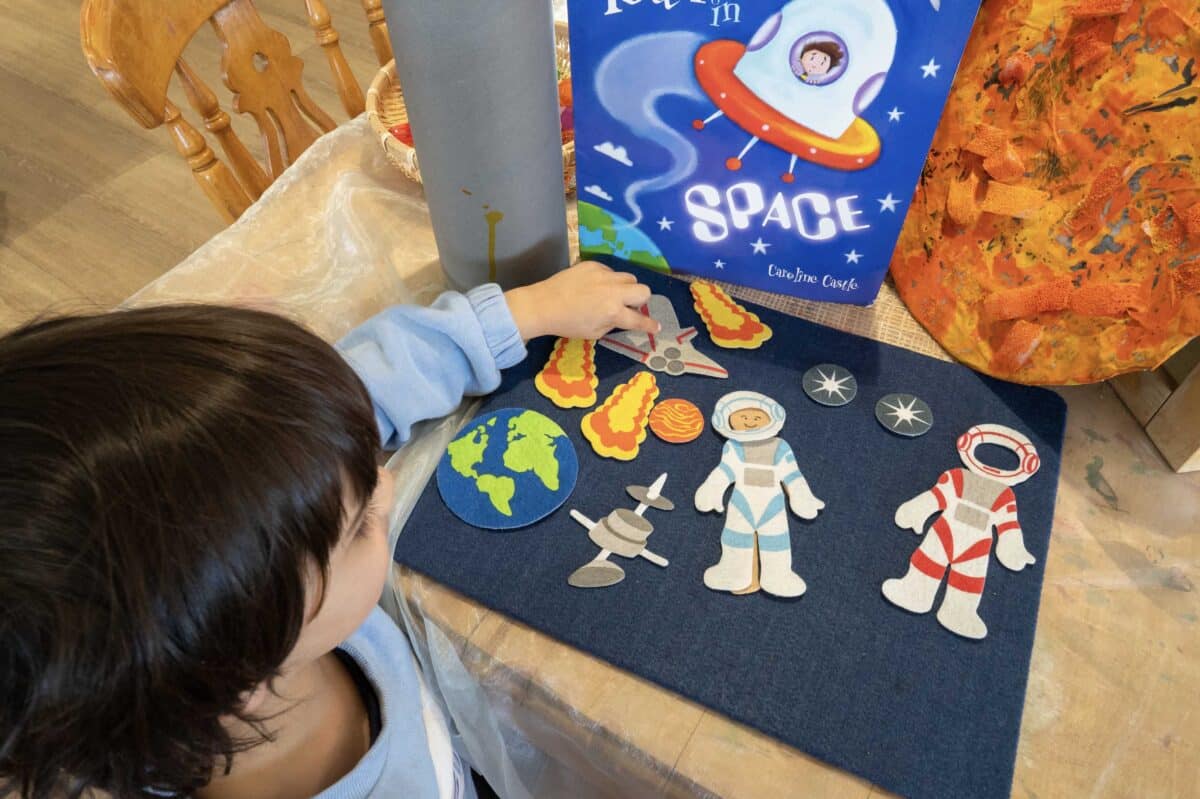
Technology
In today’s digital age, technology is everywhere. It shapes the way we live and interact with the world. Therefore, introducing your toddler to technology at an early age can set the foundation for success in school and the workplace.
From exploring the inner workings of robots to understanding coding; technology books open a world of possibilities for toddlers:
- Robots, Robots, Everywhere! by Sue Fliess and Bob Staake
- What Do Machines Do All Day? by Jo Nelson, illustrated by Aleksander Savic
- Peekaboo Car by Ingela P Arrhenius and Camilla Reid
- Help! My Robots are Lost in the City! by Webber Books
- Twinkle, Twinkle, Robot Beep by Jeffery Burton, illustrated by Zoe Waring
Engineering
Engineering is all about creativity and problem-solving. It’s the art of designing, building, and making things work. Therefore, introducing engineering concepts to toddlers fosters creativity, curiosity, and critical thinking skills.
Whether it’s building with blocks or learning about simple machines, engineering books spark ingenuity and inspires little builders and inventors:
- Baby Loves Structural Engineering! by Ruth Spiro, illustrated by Irene Chan
- Rocket Science for Babies by Chris Ferrie
- Things that Go by Becky Davies, illustrated by Mei Stoyva
- ABCs of Engineering by Chris Ferrie
- Baby Loves Coding! by Ruth Spiro
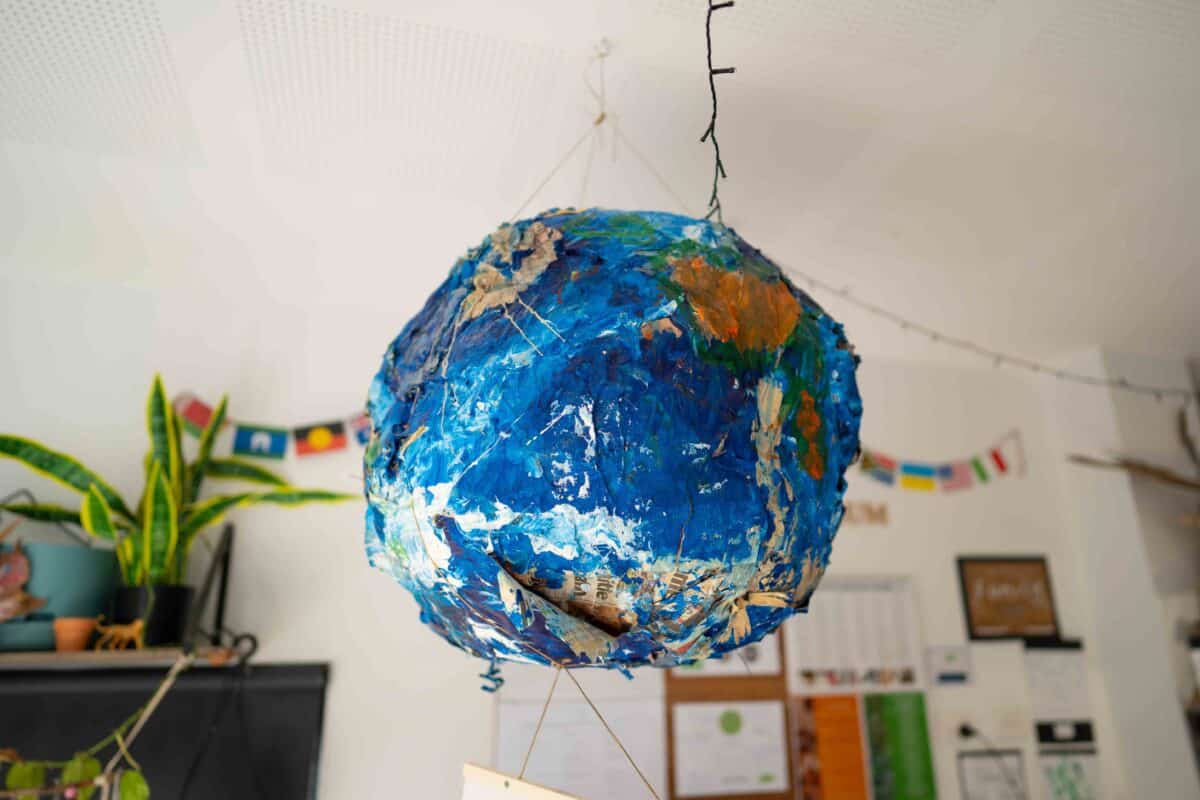
Arts
The world of arts is a boundless realm of imagination and self-expression. Encouraging your toddler to explore their artistic side is a journey of discovery. Additionally, arts encompass a wide range of activities from painting and drawing to music and dance.
These books explore space in their own unique ways with differing art styles, storytelling techniques, and points-of-view. Therefore, your child will gain a deeper appreciation for the beauty of artistic expression and how books – just one artform – can tell a deeper story:
- Life on Mars by Jon Agee
- Curious George and the Rocket by Margret Rey, illustrated by H. A. Rey
- Meanwhile Back on Earth by Oliver Jeffers
- Pop-up Peekaboo! Space by DK
- Bizzy Bear: Space Rocket by Benji Davies
Maths
Maths is the language of the universe, and it’s never too early to introduce your toddler to its wonders. Likewise, maths isn’t just about numbers. It’s about patterns, shapes, and problem-solving.
Importantly, these maths books make understanding the foundations of academic success fun! Before long, you might even find your child looking forward to solving equations and counting all on their own:
- Peck Peck Peck by Lucy Cousins
- ABCs of Mathematics by Chris Ferrie
- How Many Legs? by Kes Grey, illustrated by Jim Field
- Space Baby: Blast Off! by Pat-a-Cake, illustrated by Kat Uno
- One is a Snail, Ten is a Crab by April Pulley Sayre and Randy Cecil
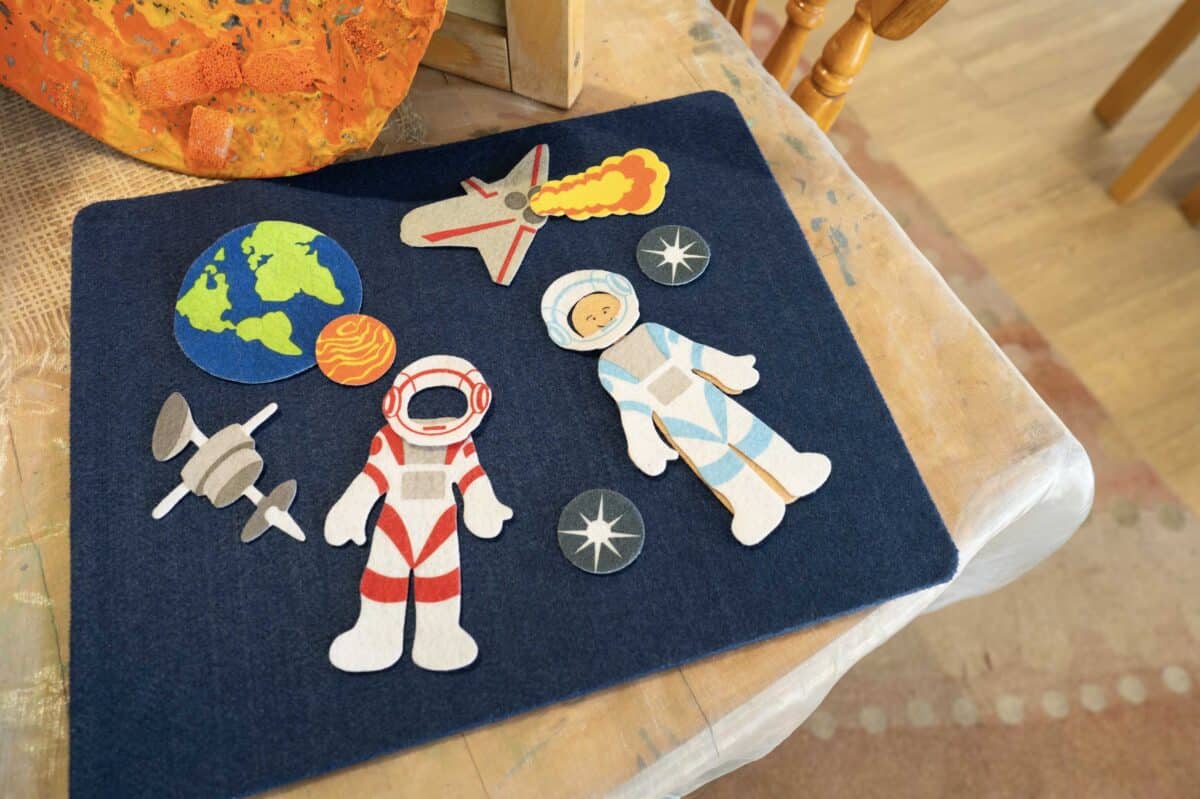
Overall, exploring these spacey, STEAM-themed books is a fantastic way to nurture your toddler’s curiosity and a life-long love for learning. Science, technology, engineering, arts, and maths are all integral parts of the rich tapestry of knowledge which shape your child’s understanding of the world. As you embark on this literary adventure, remember to encourage questions and engage in discussion with your child.
So why not dive into these captivating books together and watch your child’s imagination light the darkest corners of the great unknown?
🍃 To tour one of our beautiful Centres, please click here. Otherwise, check out our website to register your interest at Explorers Early Learning today!
Returning to Work After Parental Leave: What to Expect
Are you dreading that first day back in the office? If so, read on for our full breakdown of how different kinds of leave, medical resources, and simple tips can help you navigate your return to work!
When you’re cosied up on the couch with your new bundle of joy, returning to work is probably the last thing on your mind. Likewise, the period following childbirth or adoption is a mix of emotions, milestones, and precious memories you’ll carry for life.
However, if you’ve made the decision to return to work, the first day will come around before you know it! While you might think you’ll settle back into the rhythm right away, parents often struggle to ease back into the work-life balance.
To make sure you’re ready for that first day back on the job, we’ve broken down parental leave, your entitlements, and some handy tips to keep in mind!
What is Parental Leave?
Unpaid Parental Leave
In Australia, all employees are eligible for unpaid parental leave if they have completed at least 12 months of continuous service with their employer.
This entitlement applies to an employee that gives birth, an employee whose de-facto partner gives birth, or an employee who adopts a child aged under 16.
Eligible employees are entitled to 12 months of unpaid parental leave, with the option to request an extension for a further 12 months.
For information on other types of leave (such as pre-adoption leave), click here.
Australian Government Paid Parental Leave
As of July 1 2023, the Australian Government Paid Parental Leave scheme provides the following additional support to eligible employees:
- A combined 20 weeks government-funded paid leave that is paid at the national minimum wage and shared between you and your de-facto partner. In summary, government funded paid parental leave:
i) can only be claimed at a workplace where you or your partner have worked for at least 12 months.
ii) must be shared, i.e., one partner can’t use more than 90% (18) of the 20 weeks (unless a single parent).
iii) must be used within 12 months of birth by the primary caregiver, while the secondary caregiver can use the leave within 24 months.
iv) doesn’t have to be taken all at once. For example, you could take one day off a week over several months.
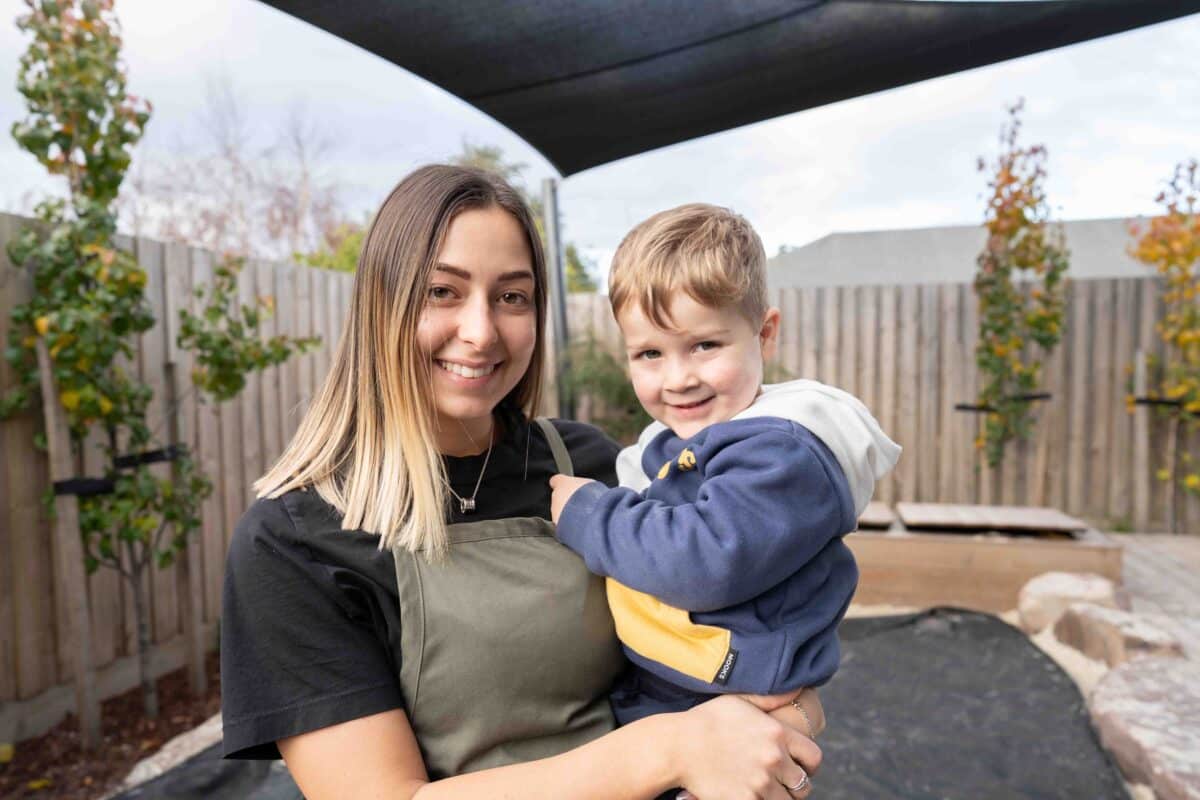
Employer Funded Paid Parental Leave
Some employers offer additional paid parental leave to new parents. The amount of leave and pay entitlements are at the discretion of each employer and will be detailed in enterprise agreements or contracts of employment.
Moreover, employer funded parental leave doesn’t affect an employer’s eligibility for the government funded paid parental leave scheme.
Your Rights When Returning to Work
An employee returning from unpaid parental leave is entitled to:
- Return to their old role or one of equal pay and responsibilities upon their return.
- Request flexible working arrangements such as working reduced hours or adjusting start and finish times.
- Support if they’re breastfeeding. For example, your workplace must make reasonable efforts for those expressing breastmilk at work. These include providing a clean and private area (not a toilet), access to a fridge to store the milk, an area to store your manual or electric pump (if you use one), a hand washing station, and regular breaks.
For more information, click here.
Return to Work Tips
To help you mentally prepare for the coming transition, we’ve listed some everyday steps you can take to reduce the dread of that fast-approaching first day back!
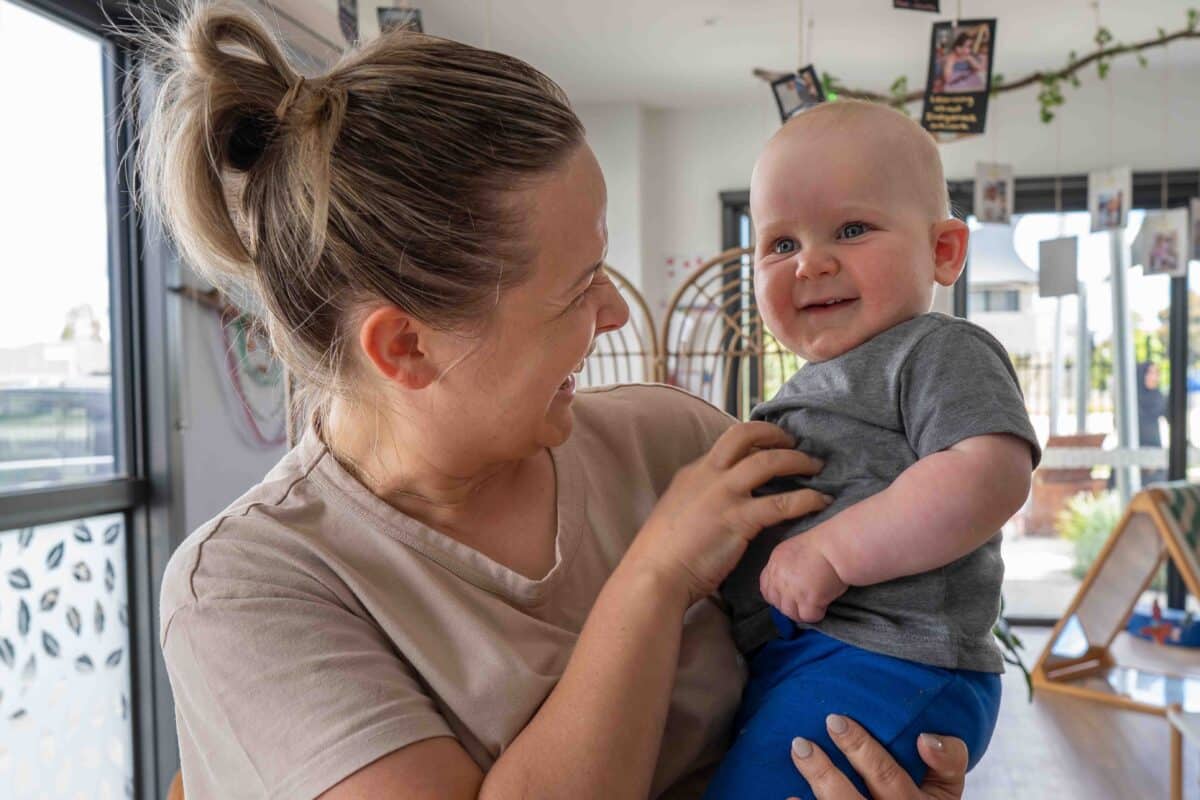
1. Keep an Open Mind
If you were working full-time before going on parental leave, don’t assume you’ll slide right back into your old routine like nothing happened. If you feel you need an extra year to care for your child, you can request this with your employer. Likewise, if you have family support or childcare organised and you want to jump back into your career earlier, that’s also okay!
Every child is unique, and their development and dependency differ greatly. Be sure to discuss any questions or concerns with a healthcare professional, and work with them to develop your return-to-work pathway. This may involve returning on a part-time or casual basis or taking on less responsibilities.
2. Organise Childcare in Advance
If you’re enrolling your child into childcare, don’t leave it until the last minute. Most early learning providers have waitlists, as well as orientation and induction processes. Also, you’ll want to give yourself as much time as possible to acclimatise your child into care and find the best fit.
If you’re looking for Reggio Emilia inspired early childhood education to give your child the best start, why not take a tour of one of our Explorers Centres? Explorers offers premium quality early childhood education and care from six weeks to school age!
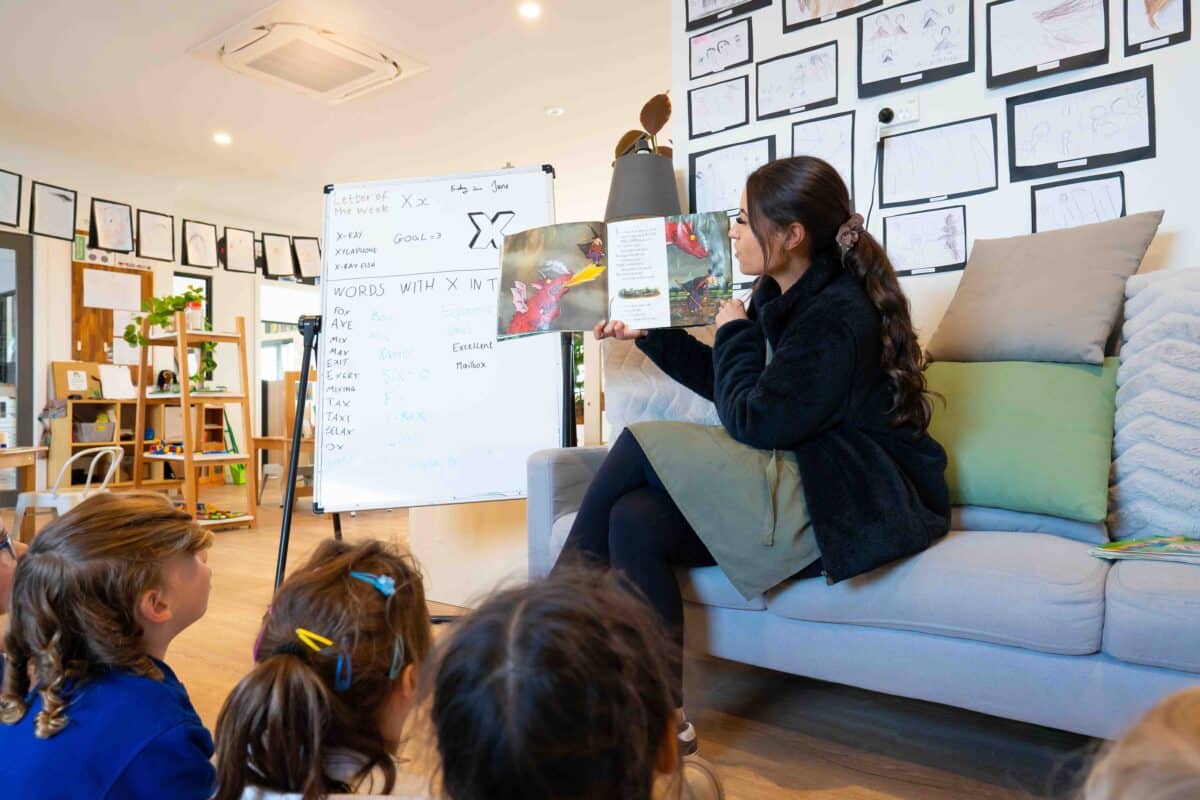
3. Stay in the Loop!
It’s tempting to shelve any thought of work during parental leave. After all, it’s time off right? However, it’s important to keep tabs on your workplace and stay in touch with colleagues and old work friends, particularly as you near your return date. This doesn’t have to be formal – something as simple as a catchup over coffee goes a long way!
This will help you avoid the culture shock of returning to work and seeing all the new faces or a new direction of the business. Moreover, it will give you valuable information and insights to inform your decision of when, and in what capacity, you’ll return to work.
Additionally, you can request to work up to 10 days while on parental leave through keeping in touch days. These could be for a conference, training days, or just to keep involved in the business. They don’t have to be taken all at once and can be for part of a day. The payment for these days is your normal wage and you accumulate your usual leave entitlements too!
4. Consider Working from Home
A common contributor to the returning to work nerves are feelings of guilt and anxiety when leaving your child on their own for the first time.
While this is a completely normal and natural reaction, it can be eased by working from home if this an option with your employer. Flexible work arrangements remove commute time, allow you to tend to appointments and checkups, so long as you have in-home care of a family support network.
5. Don’t Be Too Hard on Yourself
Don’t forget to prioritise self-care during the transition back to work. The demands of parenthood and work can be overwhelming, so it’s essential to carve out time for yourself.
Whether it’s taking short breaks, practicing mindfulness, leaning on family and friends, or engaging in physical activities, self-care will help you maintain your well-being and perform better both at home and in the workplace.
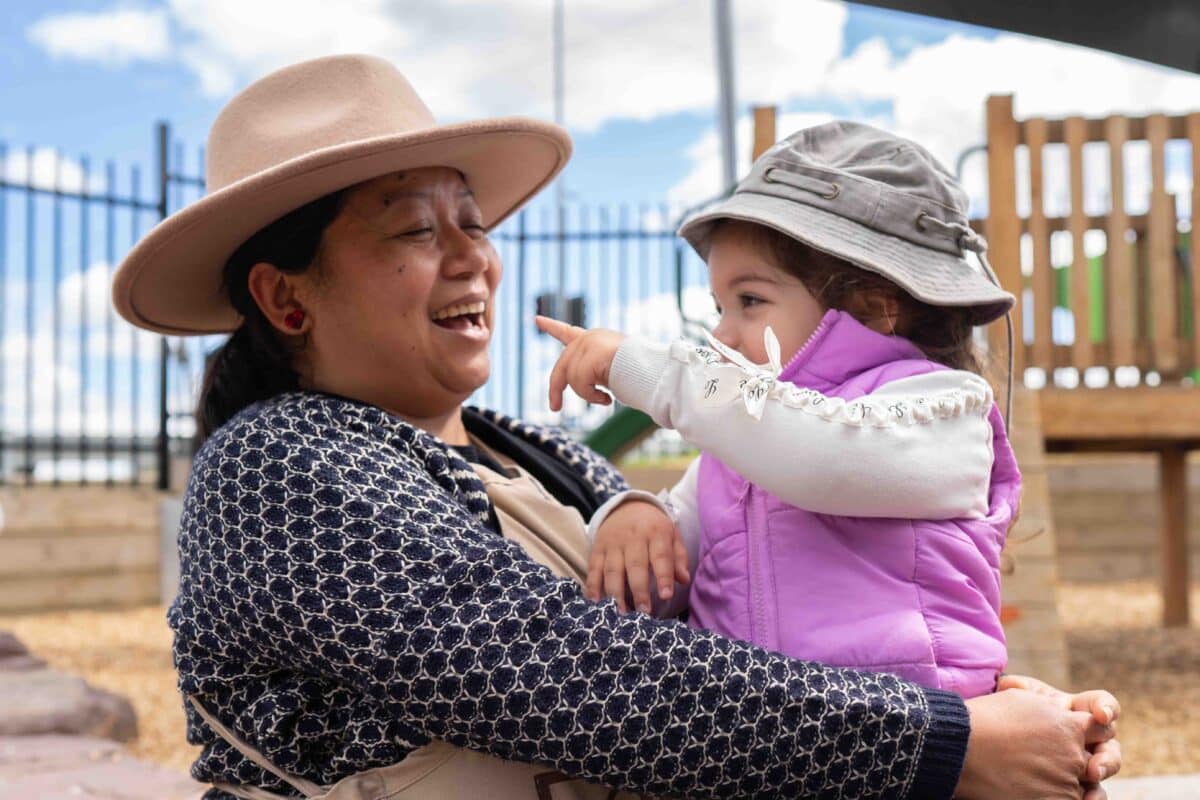
6. Sit Down with Your Boss
Open and honest communication with your employer is vital before, during, and after parental leave. Discuss your expectations, responsibilities, and any potential adjustments to your workload.
Many employers are willing to accommodate new parents, offering flexible hours or remote work options. Importantly, it’s a chance to be express any points of worry or anxiety so they can be ironed out before your return to work. If you don’t feel comfortable speaking with your boss, try your human resources department or union representative.
Be sure to understand your rights and entitlements under the Paid Parental Leave Act (2010) or any other applicable laws.
7. Reach Out if You’re Struggling
Building a strong support network is essential for working parents. Reach out to family, friends, colleagues, medical professionals, and other parents who can offer advice, assistance, or simply a listening ear when you need it. Consider joining local parenting groups or online communities to connect with others facing similar challenges.
Returning to work after parental leave is a significant life transition, and it’s entirely natural to feel a mixture of excitement and worry. By following these tips, you can ease the process, maintain your well-being, and ensure a smooth transition both at home and in the workplace.
Just remember that you’re not alone. With the right support and mindset, you can focus on what matters most – building memories with your newest addition to the family!
🍃 To tour one of our beautiful Centres, please click here. Otherwise, check out our website to register your interest at Explorers Early Learning today!
13 Must-Read Books for Book Week 2023
Read, Grow, Inspire. This year’s Book Week theme is all about fostering future creatives. To give your child the best start in their creative journey, check out our list of 13 must-read books for Book Week 2023 👇
Book Week has exploded in popularity in recent years with school and library events, activities, and dress-up parades taking centre stage. However, it’s important to remember the true purpose of Book Week which is, of course, reading!
This year’s Book Week theme – Read, Grow, Inspire – perfectly illustrates the importance of reading and engaging with stories from an early age. In fact, experts suggest that reading with toddlers promotes bonding and builds lasting relationships.
To celebrate Book Week 2023, we’ve compiled a list of 13 books that every child should read. The stories vary from rhyming cats to wombat stew, while also planning a costume or two!
1. How the Birds Got Their Colours by Mary Albert and Pamela Lofts
This Dreaming story is a wonderful introduction for children into the incredible world of Indigenous Australian culture. Mary Albert, a woman of the Bardi people, beautifully combines retellings of Dreamtime stories and children’s paintings to form a mosaic of Indigenous heritage.
If you have a passion for the more extravagant costumes, honour this important story by dressing your child as their favourite bird – just make sure to use plenty of colour!
2. The Very Hungry Caterpillar by Eric Carle
At just 224 words long, Eric Carle’s The Very Hungry Caterpillar has endured as a bestseller for over 50 years. Carle’s story cleverly teaches children the days of the week, counting, patterns, and healthy eating while also being a captivating read for adults.
The best part of this costume is its simplicity. All you need is a stripy green shirt and a few materials to make the crown. Alternatively, there’s plenty of The Very Hungry Caterpillar costumes in stores or online.
3. The Rainbow Fish by Marcus Pfister
One look at The Rainbow Fish proves it’s a book like no other. Pfister’s ingenious use of holographic foil for the shimmering scales meant this book was destined for greatness. But like the Rainbow Fish himself, it’s about what’s beneath the surface. Take a journey of self-discovery with your child and delve into The Rainbow Fish to learn all about sharing and the power of friendship.
Dress your child as the glittering Rainbow Fish complete with shiny scales, and use the opportunity to discuss the importance of kindness and generosity.
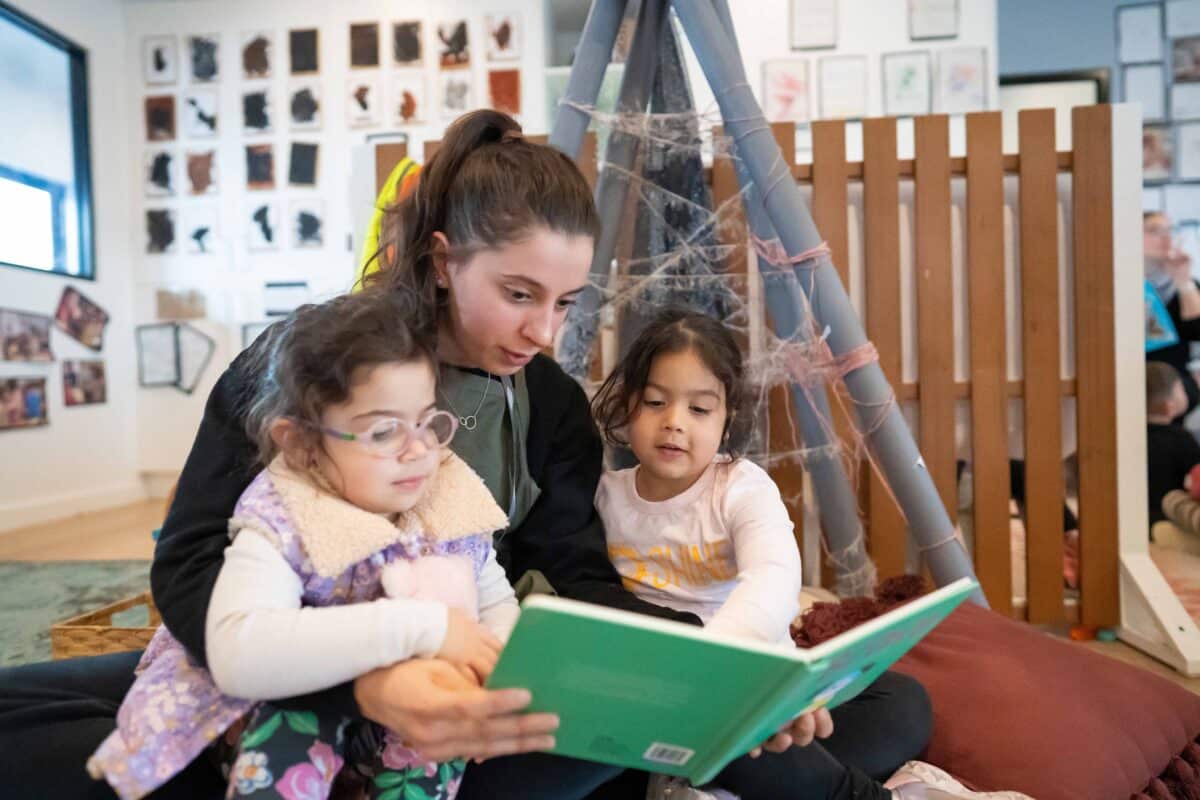
4. Wombat Stew by Marcia K. Vaughan and Pamela Lofts
Marcia K. Vaughan’s Wombat Stew seamlessly intertwines Australian wildlife into a story of teamwork, cunning, and whimsy. This is one to read aloud with its captivating illustrations and unique rhymes!
Grab a onesie and encourage your child to dress up as a mischievous wombat, a cheeky dingo, a friendly platypus, or any of the other Australian animals featured in Wombat Stew. The best part about this is it also reduces waste as they’ll get plenty of use out of a cosy onesie in the colder months.
5. Possum Magic by Mem Fox and Julie Vivas
Mem Fox’s enchanting tale of an invisible possum is an unforgettable celebration of Australia’s native wildlife and the need to preserve them. Even better, both Mem Fox and illustrator Julie Vivas are Australian, so you’re supporting local authors while enjoying this timeless Aussie classic.
Invite your child to dress up as Hush, the invisible possum, or her friend Grandma Poss. This is an opportunity to get creative with stars, face paint, and props!
6. Neil, the Boring Amazing Sea Cucumber by Amelia McInerney and Lucinda Gifford
Did you ever think you’d reach for a story starring a sea cucumber? This hilarious aquatic story is one for children and parents alike. Through deadpan delivery, plenty of puns, and smooth illustrations, this is one your child won’t soon forget.
The beauty of this costume is its simplicity – all you need is some glasses and plenty of green!
7. The Gruffalo by Julia Donaldson and Axel Scheffler
Take a stroll with a mouse in a deep dark wood. The Gruffalo endures to this day as a regular on children’s bookshelves, thanks to its clever turn of phrase, striking illustrations, and clever storytelling.
As for costumes, there’s so many animals to choose from in The Gruffalo! While a costume of the Gruffalo himself may be a bit too crafty for some, there’s plenty to work with for the mouse, snake, owl, or the silly old fox!
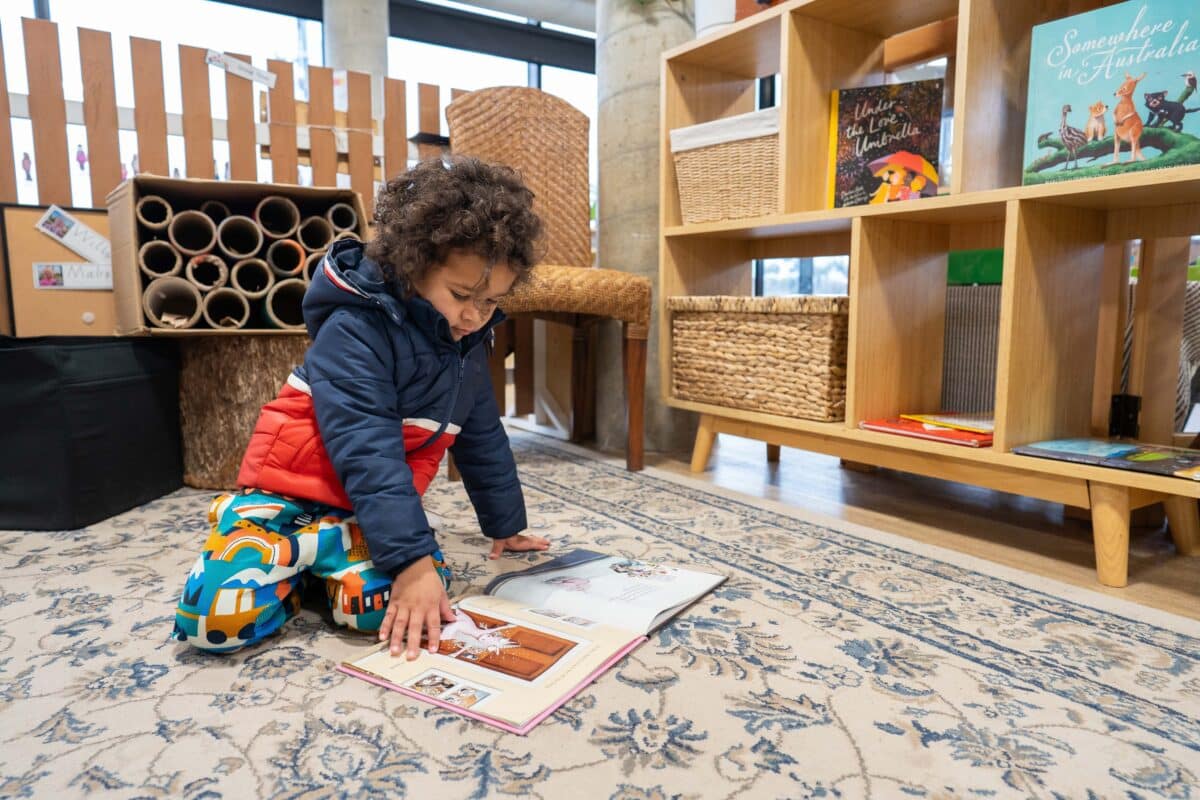
8. Diary of a Wombat by Jackie French and Bruce Whatley
Jackie French’s Diary of a Wombat took home the Young Australian Readers’ Award, Kids Own Australian Literature Award: Best Picture Book, and so many more. Like The Very Hungry Caterpillar, Diary of a Wombat cleverly teaches children the days of the week and even the times of the day.
Dress your child as Mothball the sleepy wombat – just be sure to bring plenty of carrots for props.
9. The Rainbow Serpent by Dick Roughsey and Percy Trezise
This Dreamtime classic is a must-read for children to broaden their understanding and appreciation of Indigenous heritage. The Rainbow Serpent is a cornerstone of Aboriginal traditions, with land rock art depicting the brilliant serpent more than 6,000 years ago!
To spread the word of this important cultural story, dress your child as the titular rainbow serpent! Just remember to be mindful and respectful of cultural traditions when dressing your child as this iconic figure.
10. Respect by Fay Stewart-Muir and Sue Lawson
This important book teaches children about the oldest living civilisation, the importance of respecting others, and the unending beauty of nature from the flickering stars to the red earth.
Dressing to convey the natural beauty of Australia fits for this wonderful story. From the scarlet robin on the cover to a cunning crow, there’s plenty to chose from in this moving tale.
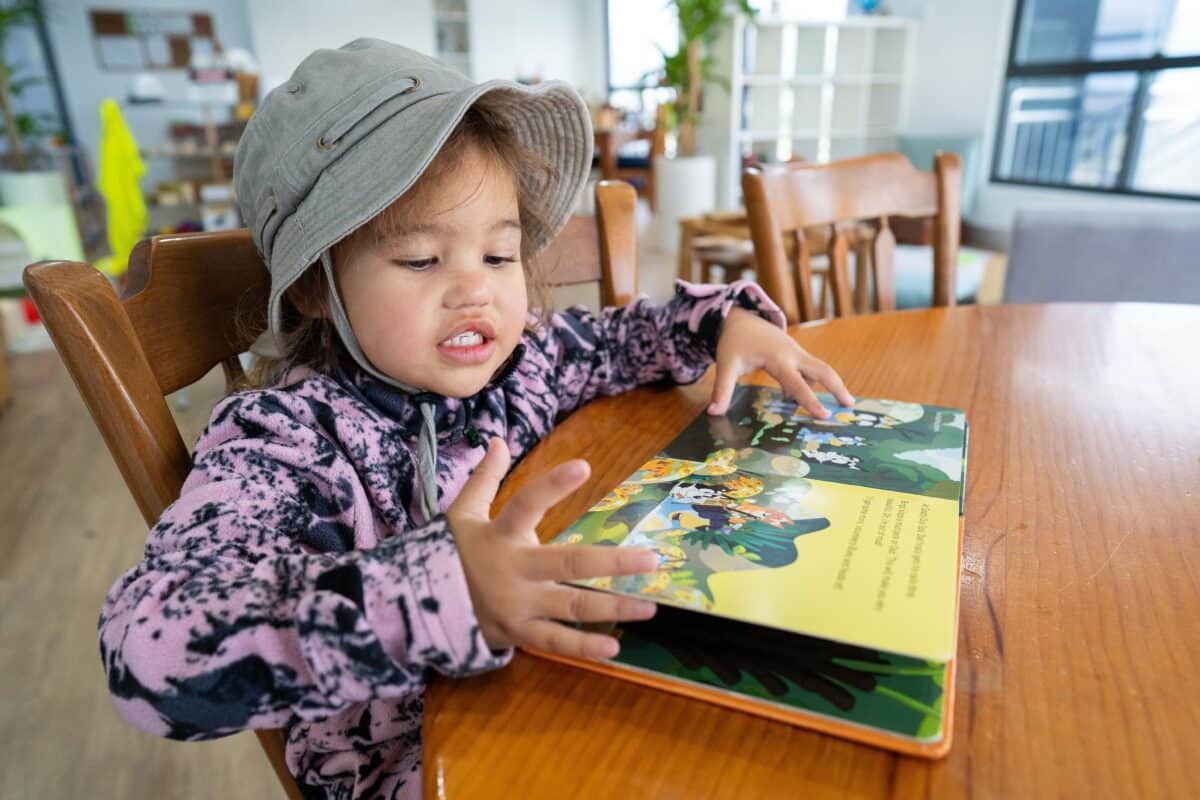
11. Where the Wild Things Are by Maurice Sendak
Despite being written in the 60s, Maurice Dendak’s Where the Wild Things Are has endured as a must-read children’s classic to this day. With a short film, an opera, a video game, and a feature length film based on the book, there’s a reason this story has remained in the public consciousness for decades (and showing no signs of slowing).
Encourage your child to don Max’s crowned wolf suit or go all out and make a Wild Things costume complete with horns, fur, and bulging yellow eyes. This one will make for some unforgettable snaps for the photo album.
12. The Cat in the Hat by Dr. Seuss
Today you are you, that is true. There is no one alive who is youer than you. We could have chosen from dozens of iconic Dr. Seuss quotes and tales, which really need no introduction. However, it’s hard to pass the iconic classic of The Cat in the Hat. This colourful masterpiece teaches children about counting, rhyme, and the virtue of honesty.
Get out the whiskers and grab a stripy red hat to dress your child as the mischievous Cat in the Hat and enjoy the rhymes together. Conversely, dress them up as any character in the Seuss books – just don’t forget the green eggs and ham!
13. The Tale of Peter Rabbit by Beatrix Potter
Beatrix Potter’s The Tale of Peter Rabbit regularly features in top children’s book lists, despite being written over 100 years ago! And this enduring legacy is for good reason. Few books have illustrated the dangers of adult life and the consequences of our actions quite like Peter Rabbit’s venture into McGregor’s woods.
Peter Rabbit, Mrs. Rabbit, Farmer McGregor; there’s so many costume choices from this wonderful book – just don’t be surprised if your little one wants a pet rabbit after this Book Week!
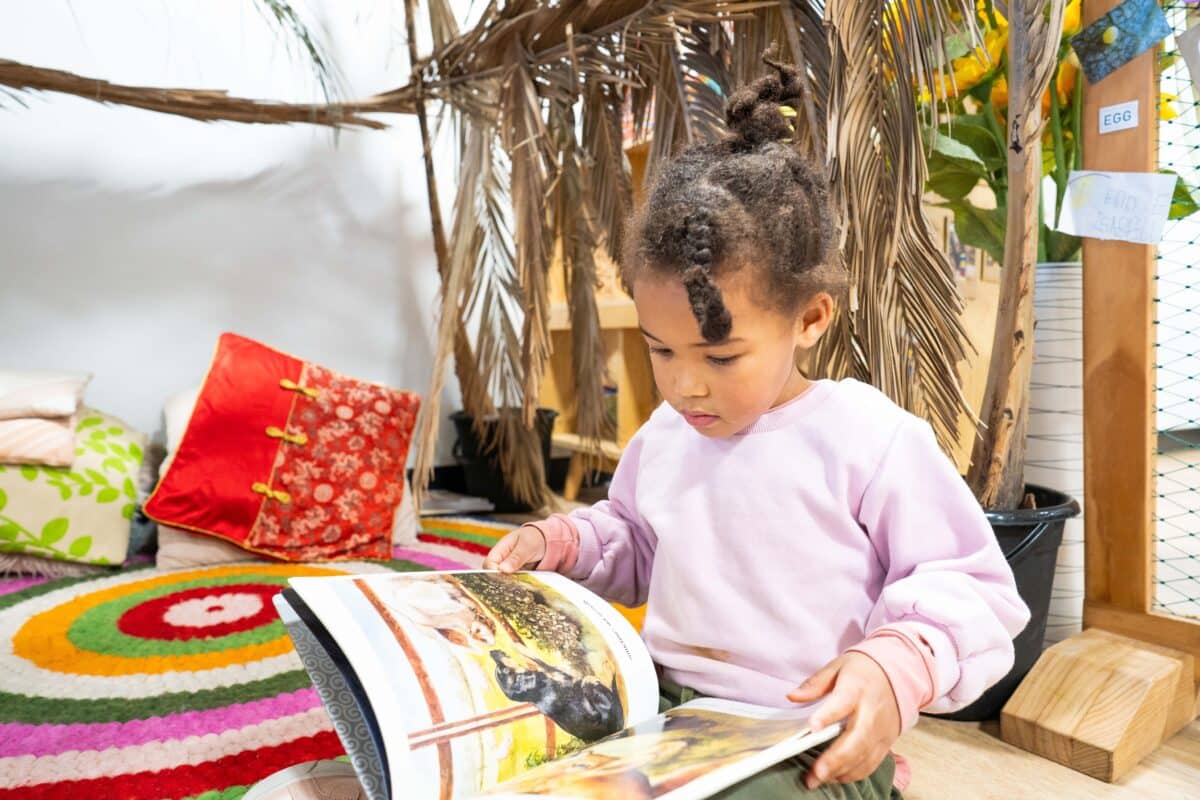
Why Is Reading Important for Children?
Whether your child is into the fantastical, the everyday, or a story about a sea cucumber, reading is essential for growing minds. In fact, the Children’s Bureau of Southern California outlines 7 key benefits for reading:
- Supported cognitive development
- Improved language skills
- Preparation for academic success
- Developing a special bond with your child
- Increased concentration and discipline
- Improved imagination and creativity
- Cultivating a lifelong love of reading
So, be sure to encourage your child’s reading and writing habits, no matter what the genre or style. Read widely and nurture their interests as they to progress from picture books to middle grade and young adult. And most of all, try not to stress over the Book Week festivities! The costumes and events are all in service of the real meaning of Book Week – to read, grow, and inspire.
🍃 To tour one of our beautiful Centres, please click here. Otherwise, check out our website to register your interest at Explorers Early Learning today!
How Much Screen Time is Too Much for Children?
Worried about your child’s screen time? Should they be on screens at all? Read on for our deep dive into the science of screen time, along with some handy tips to get your child experiencing the world 👇
Like it or not, computers, tablets, and smartphones are a normal part of growing up in 2023. While technology provides a world of possibilities for additional learning, too much screen time is regularly topping lists as the number one health concern among parents.
But how much screen time is too much? Should children use screens at all? In this post, we dive into the science behind screen time and provide our top tips to help your family in this increasingly techy world.
What Do the Experts Say About Screen Time?
According to AIFS (Australian Institute of Family Studies), screens should be introduced carefully to children:
- 0-2 years: no screen time – in the early years, screens provide too much stimulation for children’s rapidly developing brains. Therefore, health experts recommend avoiding screens entirely and to instead engage in sensory play, talking out loud, and reading.
- 2-5 years: one hour per day – at this age, children learn by imitating adults and exploring their environments. In other words, they need to experience the world around them. As screens limit children’s sensory experiences, they may develop ‘tunnel vision’.
- 5-17 years: no more than two hours per day – this will change as children enter high school and incorporate devices into their studies. However, during the primary school years, experts recommend two hours as the maximum for daily recreational screen time.
What Should Children Watch?
Although excessive screen time can be harmful, it can be beneficial in moderation. Just ensure that you’re always supervising your child during screen time and engaging in high-quality, educational content. This could be through interactive shows, animated stories, or apps.
Some of our top picks are:
- Sesame Street
- Bluey
- Ask the StoryBots
- Octonauts
- Alphablocks
- Numberblocks
- Vooks
- ABC Mose Early Learning Academy

How Can You Limit Screen Time for Children?
We recommend taking steps as early as possible to limit screen time. This will reduce the number of tantrums as children gradually develop screen-free habits. It doesn’t always have to be a strict rule, but everyday steps play a significant role in changing your child’s screen time habits.
1. Turn off the TV in the Background
Have you ever come home and turned on the television without even realising? Nobody’s watching it, so what’s the problem? Well, this background noise can be an unnecessary distraction for children which may lead to poor focus and shortened attention spans.
Additionally, televisions encourage passive viewing. In the early years, children need to be active. Whether it’s through physical activity or exploration, active play stimulates cognitive development, along with a range of other health benefits.
Try using soothing music or an age-appropriate podcast instead. Or, better yet, play nothing at all! Learning to sit with silence is an important skill for children to learn as they progress through life, particularly school, where there won’t always be a television or speaker to entertain them.
2. Set Rules for Screen Time
Children thrive on structure and routine. Therefore, establishing a screen time schedule reduces tantrums as children have a clear and defined timeframe for when screen time is allowed.
If you have older children, get them involved in the process. Hold a family meeting to decide which times work best for screen time. Once the whole family agrees, have them all sign a family contract. This will reduce future disagreements, while also introducing children to the importance of promises and sticking to your word.
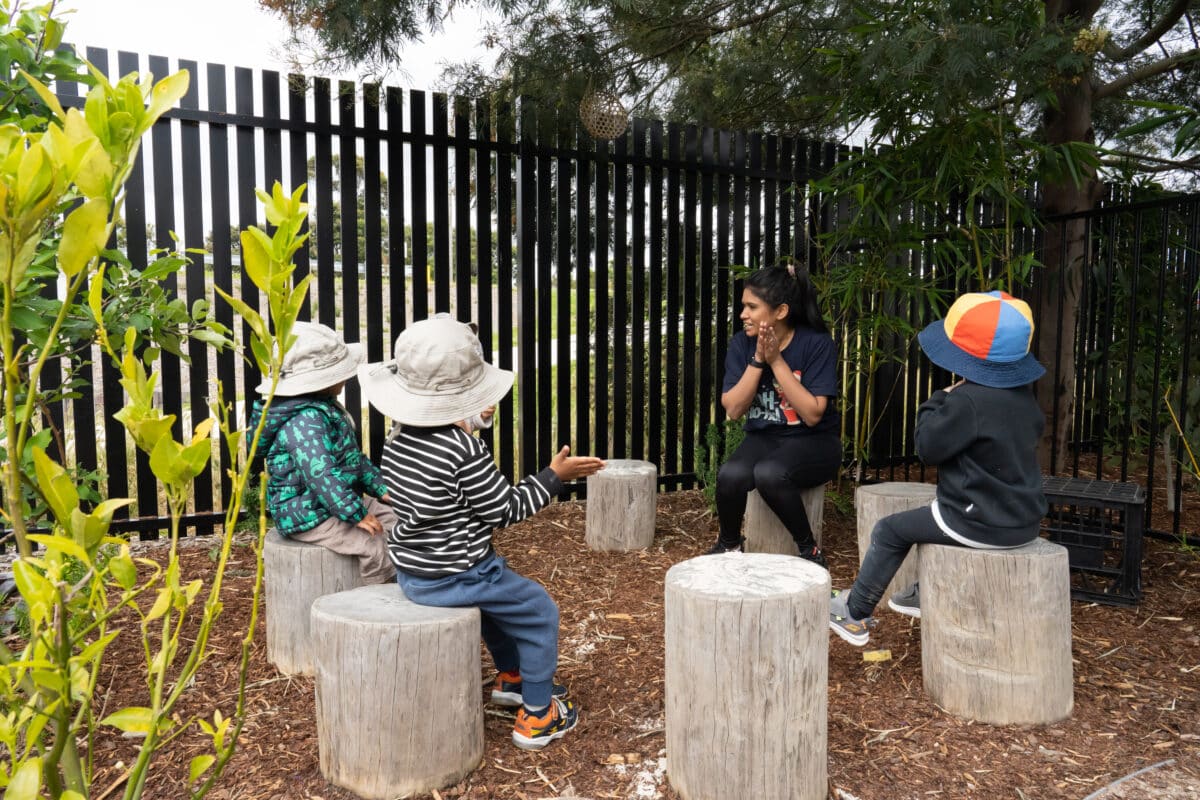
3. Introduce Screen-Free Days
You’ve heard of meat-free Fridays, but what about screen-free Fridays? Frequent screen time can overstimulate children, literally rewiring their brains and potentially leading to increased risk of developing attention deficit hyperactivity disorder (ADHD) and oppositional defiant disorder (ODD).
Therefore, try allocating days of the week, or entire weekends, to screen-free activities. You can then use these screen-free days to engage in family bonding.
4. Engage in Screen-Free Activities
Screen-free activities range from a trip to the museum to reading a book with your child. Anything to get them experiencing the world is a positive step in their development:
- Take a trip to the library or museum
- Engage in sensory play
- Go on a nature walk
- Read a book together
- Solve puzzles
- Play board/card games
- Engage in arts and crafts
- Get out into the garden
- Cook or bake a meal together
5. Set a Good Example
Children love playing grown-up. Whether it’s dressing up or making pretend dinner, children love acting like Mum and Dad.
Therefore, if your child sees you watching television, scrolling through your phone, or spending hours on your laptop in your spare time, they’re going to do the same. So, if you want your child to reduce their screen time, the tough fact is you’re going to have to as well!
Additionally, be mindful when using screens. Do you really need to scroll through your phone or are you just doing it out of habit? Likewise, you can also use this as an opportunity to educate your child about the purpose of screens and devices. If you work from home, have a discussion with your child about how you use your laptop for work or study.
Try to prioritise face-to-face interactions with your child. You might be surprised how much your child learns from something as simple as watching your facial expressions.
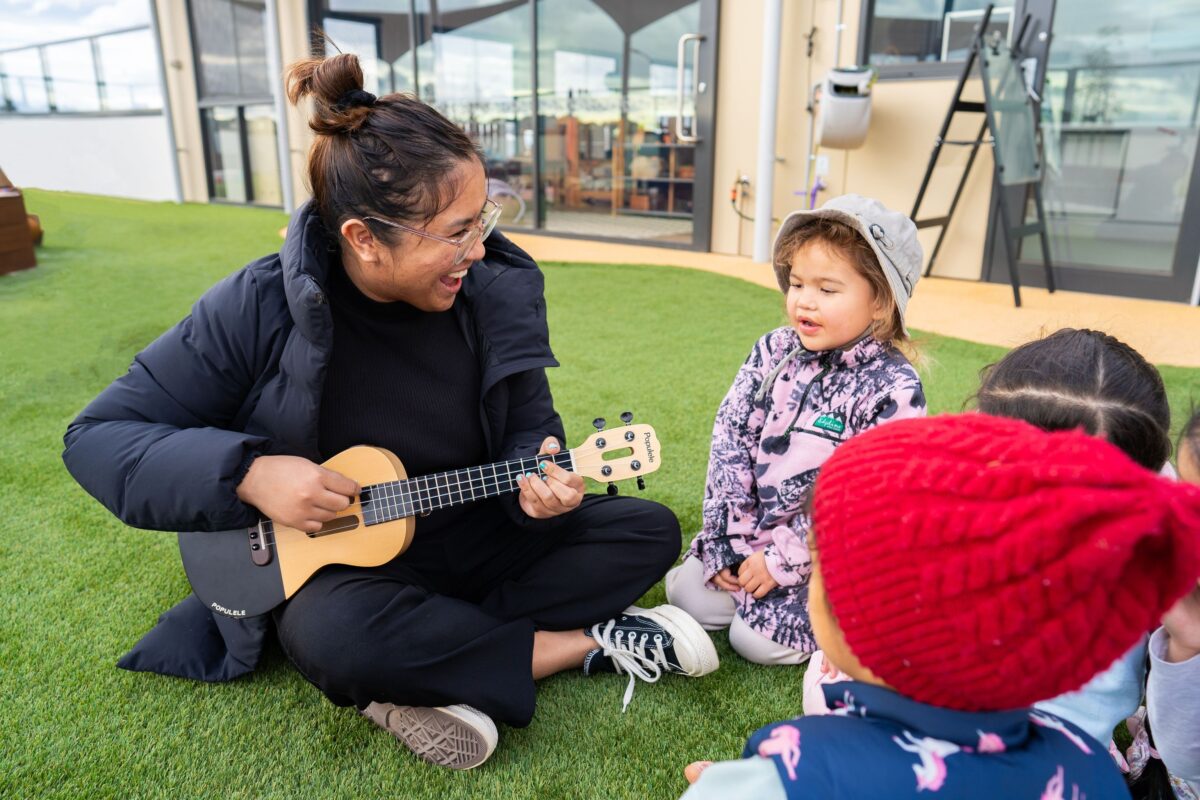
Overall, screens are an inevitable part of living in the modern world. Whether it’s at work, out in public, lounging at home, or at school, your child will be exposed to technology. However, you don’t have to be constrained to overstimulation and the tantrums that follow.
By engaging in face-to-face activities, setting clear boundaries, and leading by example, you can limit your child’s screen time with just a few simple steps. Even better, you can take control of your child’s development, so they’ll get the best possible start for primary school, secondary school, and beyond.
🍃 To tour one of our beautiful Centres, please click here. Otherwise, check out our website to register your interest at Explorers Early Learning today!
The Benefits of Messy and Sensory Play: Why Children Need to Make a Mess
What is messy and sensory play, and is it worth the clean-up? Read on for our full breakdown of messy play, along with some suggestions to get your child’s brain buzzing 👇
Messy and sensory play is incredibly beneficial for children as young as six months old. From finger painting to exploring sensory materials, messy play offers a world of opportunities for learning and physical development, even if the clean-up can be a hassle!
In this post, we break down the physical and cognitive benefits of messy play and explore why your child should embrace the mess.
Sensory Development
Messy play engages (almost) all the senses. When children squish their fingers into mud or clay, they feel the sensation, hear the sounds, and smell the material. Therefore, sensory activities provide valuable cognitive input, helping children refine their tactile perception and develop a greater understanding of different textures.
And there’s so many sustainable options to choose from:
- Water
- Sand
- Dirt
- Mud
- Homemade playdough
- Clay
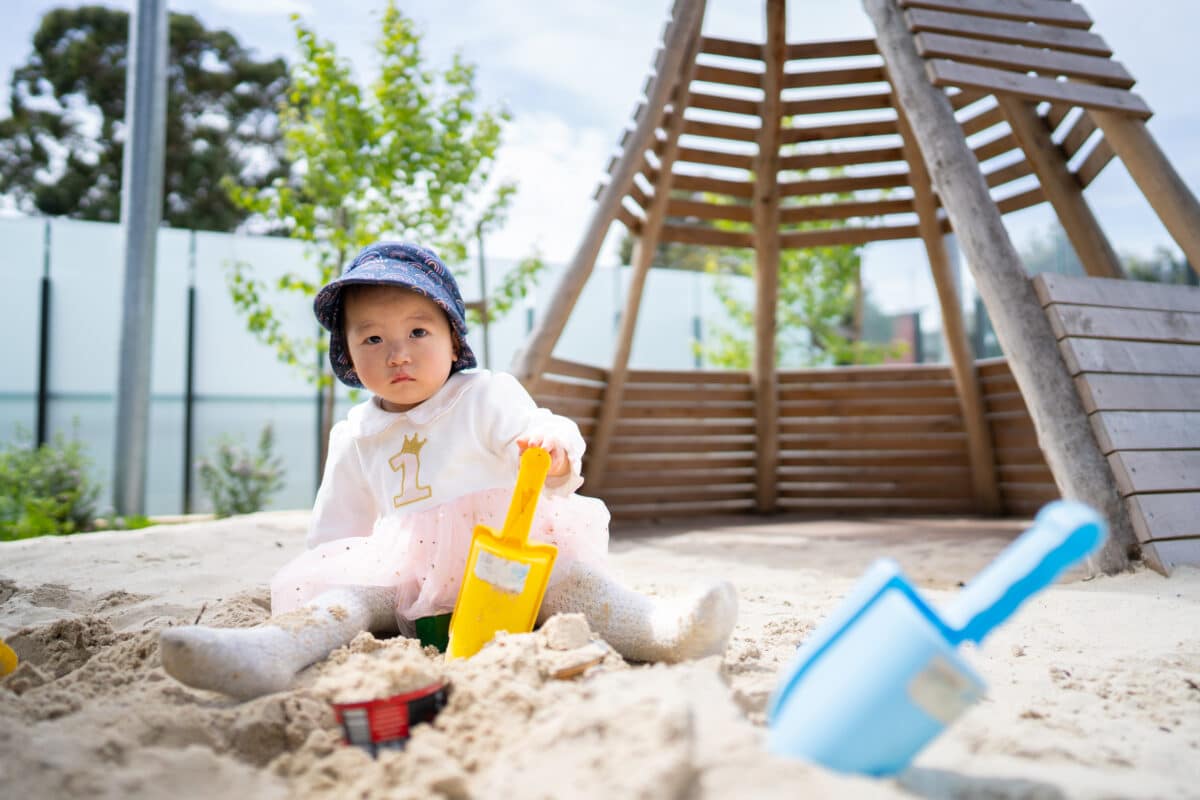
Messy Play Activities
6-12 months
Although they’re mostly babbling at the 6-12 month mark, babies love messy play and sensory exploration! Just be sure to supervise and only use gentle materials:
- Cotton
- Fabric
- Crinkly paper
- Fleece
- Satin
- Water
12-24 months
By age two, children are as curious as ever. Their brains develop rapidly as they near the end of the first 1000 days of life. Therefore, they want to touch, smell, and experience the world around them. This is perfect for messy play:
- Sensory bins
- Sand/clay
- Homemade playdough exploration
- Finger painting
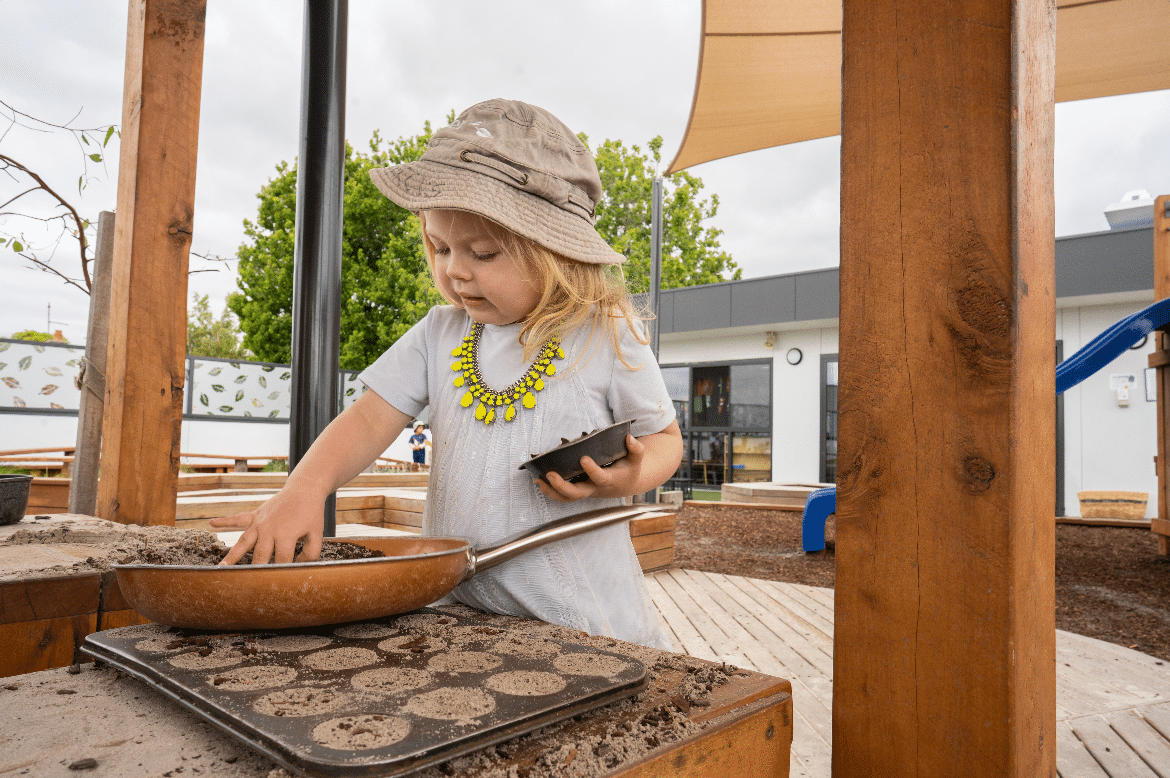
2-3 Years
Children between ages 2 and 3 are typically walking, talking, and full of attitude! This is where you can really start to inspire their artistic side by adding more elements to their messy play experience.
- Water-based paints
- Sensory ice play
- Clay time
3-5 Years
By the time your child is in Kinder, you’ll probably be looking for ways to give them the best start for primary school. Therefore, this is the perfect time broaden their messy play experience to prep them for their next big steps:
- Nature exploration
- Sensory storytelling
- Painting and drawing
Cognitive Skills
Messy play goes beyond engaging the senses. Rather, it aims to nurture children’s emerging cognitive skills.
When children engage in messy play, they’re presented with open-ended materials and situations which encourage problem-solving, critical thinking, and decision-making. For instance, when building sandcastles or clay sculptures, children think creatively and strategically to achieve their desired outcomes.
In addition, messy play provides opportunities for experimentation and exploration. Children mix colours, observe cause-and-effect relationships, and question what happens next when different materials are combined. This hands-on approach fosters curiosity and a love for discovery, promoting a growth mindset in children.
Fine Motor Skills
Messy play activities often involve actions such as squeezing, pouring, and scooping. These activities promote the development of fine motor skills and hand-eye coordination in children. Whether they’re using a paintbrush, pouring water, or moulding clay, children flex their dexterity and refine their ability to control and coordinate their movements.
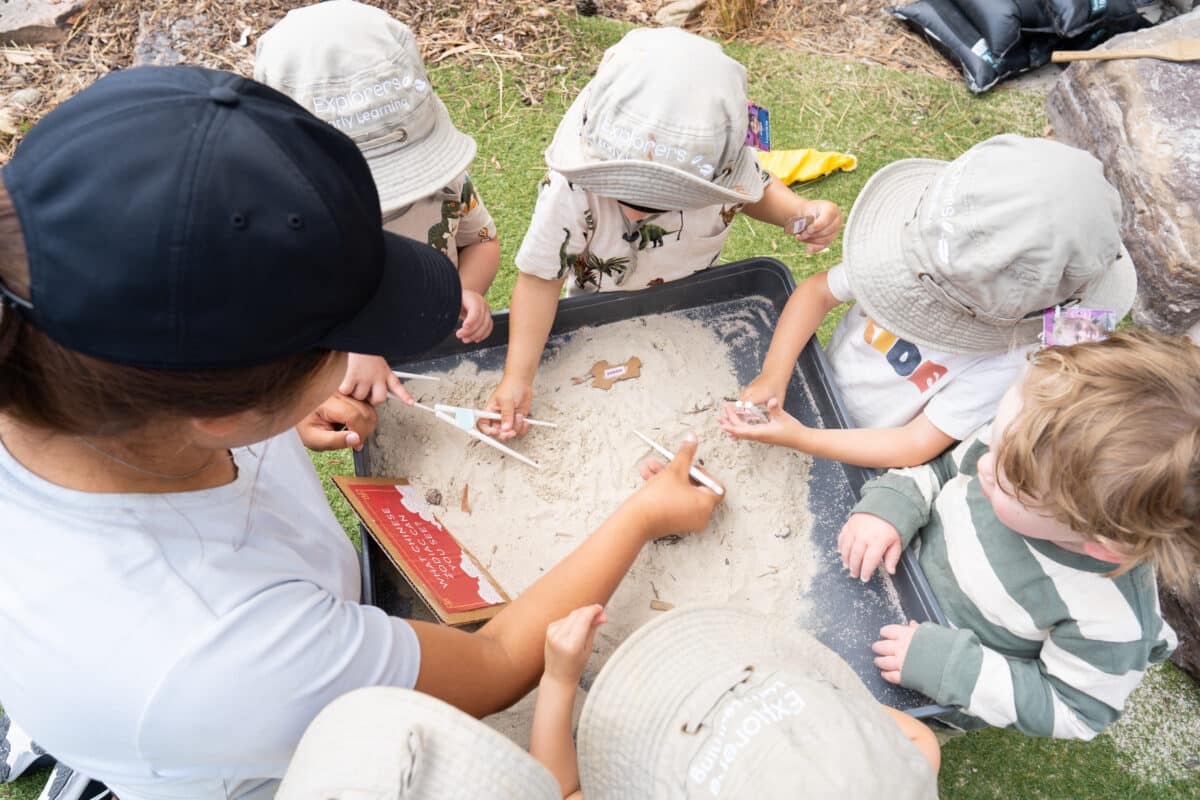
Language Development
Messy play also plays a vital role in language development. During messy play, children inevitably engage in conversation and storytelling. They describe the sensory experience, use descriptive language to express how the colours make them feel, and share their observations. This rich linguistic environment expands vocabulary, improves communication skills, and nurtures creative expression.
Emotional and Social Development
Embracing messy play allows children to express themselves freely and build independence. When children are given the freedom to explore materials and engage in unstructured play, they develop a sense of ownership and pride in their creations.
Messy play also offers opportunities for collaboration and sharing as children work together on projects and exchange ideas.
Moreover, messy play provides a safe space for children to experience a range of emotions. Whether it’s the joy of squishing paint or the frustration of a sandcastle collapsing, children navigate and express their feelings through these immersive experiences. As they explore and experiment, they develop emotional resilience and adapt to different situations.
Creativity and Imagination
Messy play and creativity go hand-in-hand. When given open-ended materials and the freedom to explore, children create, transform, and invent things most adults couldn’t dream of.
Whether they’re sculpting clay, mixing colours, or creating sand masterpieces, messy play encourages divergent thinking and fosters innovation.
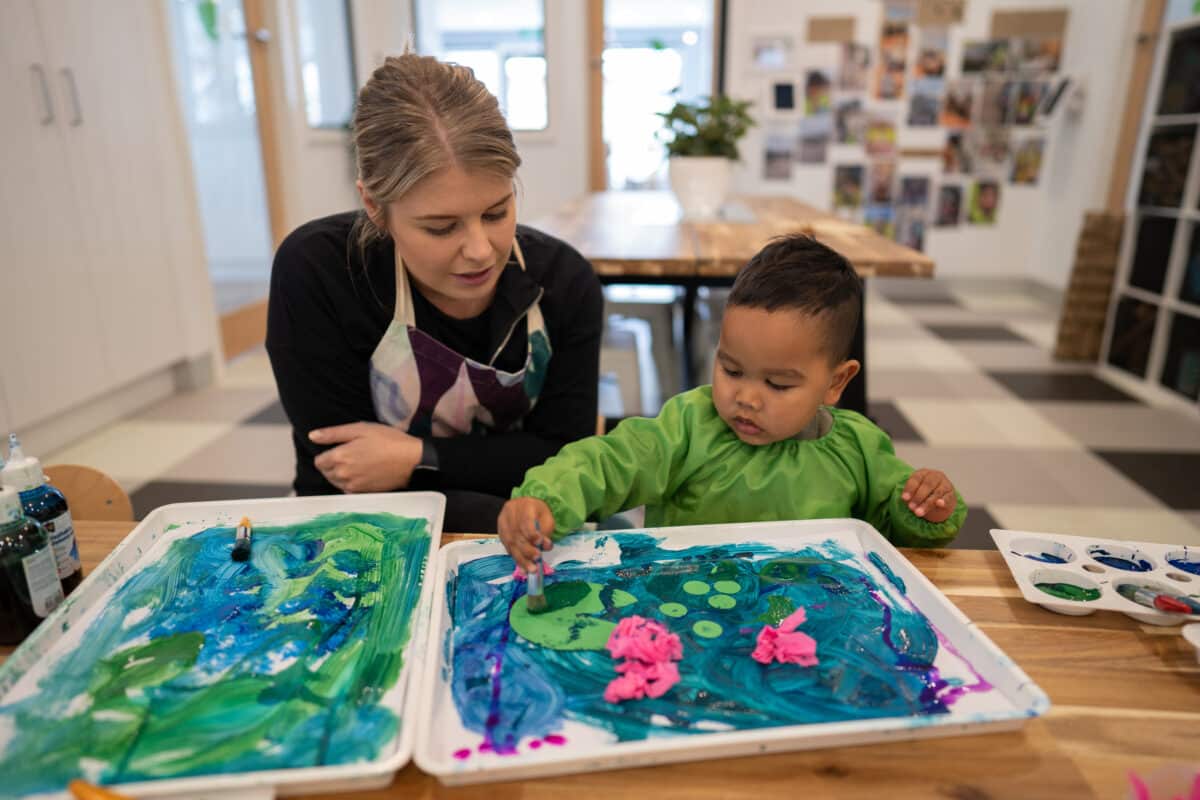
Why is Messy Play Important?
The focus of messy play is on process rather than the end result. Children learn that there’s no one rule to express yourself, allowing them to embrace their creativity without fear of judgment. This freedom nurtures self-discovery and fuels a lifelong love for art and curiosity.
Ultimately, messy play provides children with invaluable opportunities for growth, development, and self-expression. By embracing the mess, they unlock a world of creativity and sensory exploration. Additionally, the benefits of messy play extend beyond the temporary chaos and strengthen cognitive, emotional, and social skills in children well into primary school.
Just remember to provide a safe and supervised environment for messy play, use child-friendly (and sustainable) materials, and try to involve your child in the clean-up process. After all, the mess is temporary, but the skills they gain last a lifetime.
🍃 To tour one of our beautiful Centres, please click here. Otherwise, check out our website to register your interest at Explorers Early Learning today!
The First 1000 Days of Life: Why They’re So Important
What are the first 1000 days of human life? And how can you best prepare your child through those exciting early years? Read on for our full breakdown of this precious early childhood journey 👇
The first 1000 days of life, from conception until their second birthday, sets the foundation for your child’s emotional, physical, and academic development. As you can imagine, getting them right is essential. It’s a time full of developmental milestones, precious memories and yes – lots of nappy changes.
In this article, we outline what to expect during your child’s first 1000 days to help you prepare for this incredible early childhood journey.
Prenatal Care and Development
Prenatal care is everything, and we’re lucky in Australia to have free public healthcare and a range of comprehensive private health insurance options. It goes without saying that it’s vital to receive regular medical check-ups, eat a balanced diet, take prenatal vitamins (particularly calcium, vitamin D and folic acid), and check a list of DO’s and DON’Ts to best support your baby’s growth.
In the first months after conception, your baby’s organs develop rapidly and you’ll feel their first flutters of movement sometime between week 16 and 24!
Additionally, studies have suggested that playing soothing music may aid in cognitive development even in the womb. Just make sure the volume is below 50 decibels, which his roughly the same volume as a washing machine.
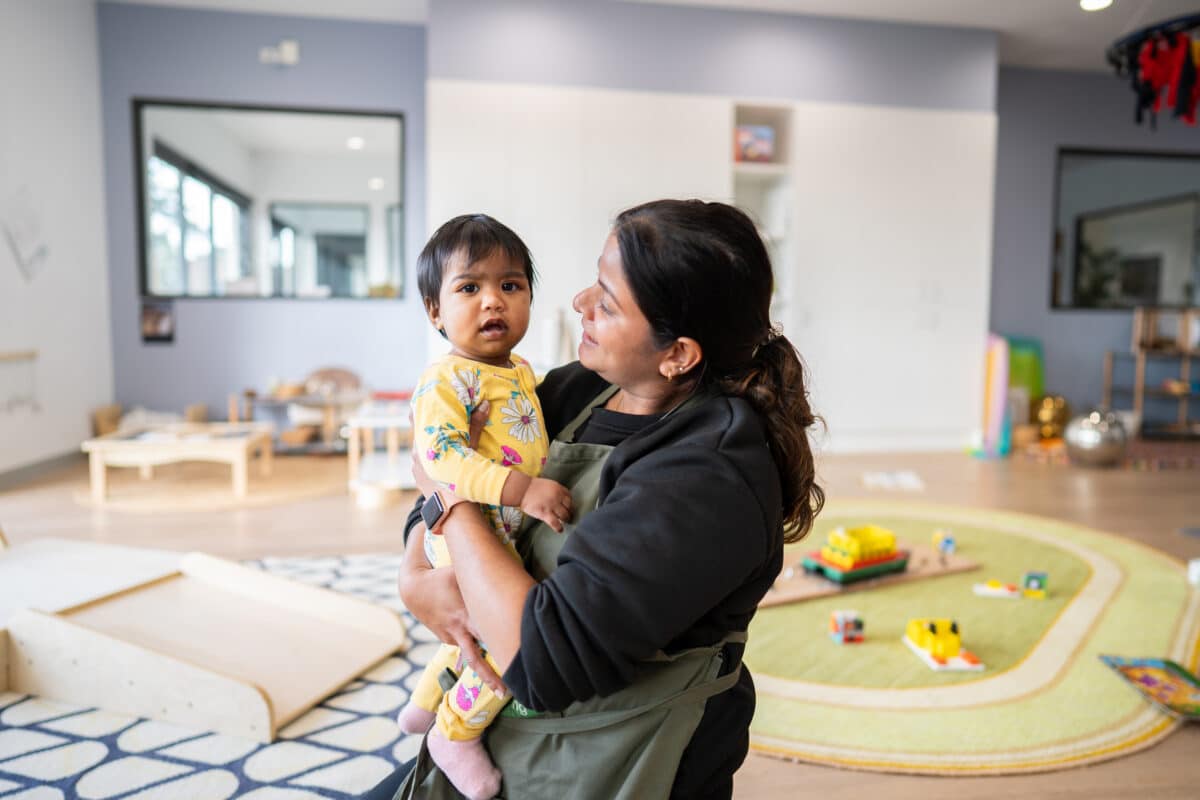
Birth and the Newborn Phase
The moment your baby arrives is a rush of emotion and relief. In the early days, you and your baby will mostly be getting to know each other. Expect round-the-clock feeding, checking, nappy changes, and lots of cuddles!
Moreover, regular postnatal checks with your GP are a must. Better Health Victoria recommends a check-up at around the six to eight week mark. This is also a great time to raise any questions or concerns.
Additionally, the Victorian Maternal and Child Health (MCH) Service is a free universal primary health service for all Victorian families with children that offers regular check-ups from birth all the way up to school age. This includes:
- Maternal and child health service resources
- Advice for sleep and settling
- Early Parenting Centres
- Aboriginal Maternal and Child Health Aboriginal-led MCH services
- Baby Bundle
While it can be easy to be overwhelmed at this early stage of development, try and enjoy these precious moments of bonding. Importantly, remember to reach out for support and guidance from loved ones or healthcare professionals if needed.
Infant Milestones
As your child passes through the first 1000 days, it’ll feel like they surpass milestones every other week. From their first smile to rolling over, sitting up, and eventually crawling, each accomplishment marks their progression physically and psychologically.
Some milestones to anticipate include:
- Birth to 3 months – lifting their head when lying on your stomach
- 4 to 6 months – rolling over, clapping, babbling
- 7 to 9 months – sitting without support
- 10 to 18 months – taking their first steps
- 13 to 18 months – engaging in pretend play, first words
- 19 to 24 months – sorting shapes and colours, identifying objects, passing things
Keep in mind that these aren’t strict timeframes. Each child develops at their own pace and may surpass these milestones well before or after these windows. During this time, you can encourage their development through tummy time, talking to them, and introducing age-appropriate toys and activities.
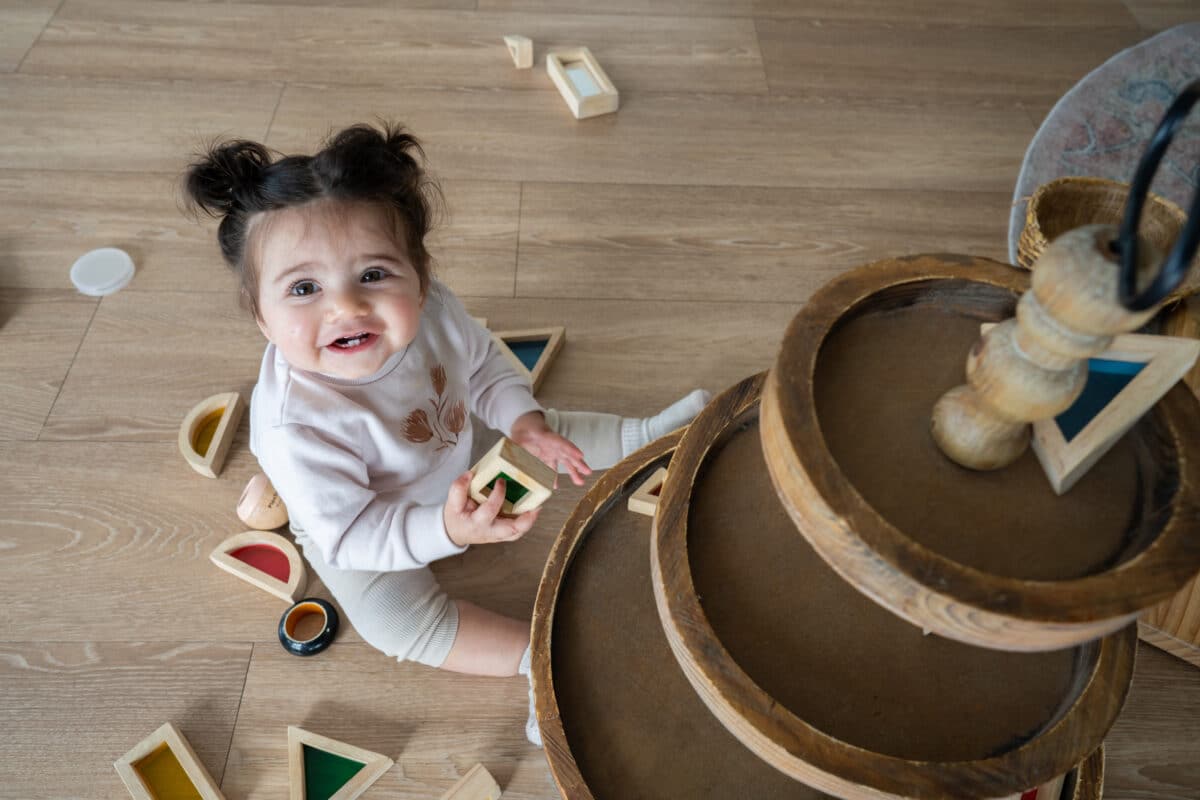
Nutrition and Weaning
Nutrition plays a vital role in your child’s growth and development during the first 1000 days. Breast milk, or an appropriate infant formula, is essential for the first six months. Thereafter, you can gradually transition to age-appropriate foods while continuing to breastfeed or offer formula for 2 years or beyond.
Solid foods can be introduced from around six months, which opens a whole new world of tastes, textures, and smells.
Just remember to be patient as your baby explores different foods and adapts to a varied diet. If you have any concerns, be sure to consult your GP or paediatrician regarding specific dietary needs, allergens, or intolerances.
Language and Cognitive Development
During the first 1000 days, your baby’s brain is rapidly developing, laying the foundation for future learning and communication. Some activities to help your child from around the one year mark include:
- Lots of talking and singing
- Reading books together
- Messy play
- Puzzles
- Art
And it doesn’t always have to be so structured. Something as simple as responding to your child’s babbles and engaging verbally promotes their understanding of the world around them (and makes for a great time!). Try to enjoy these moments of discovery together.
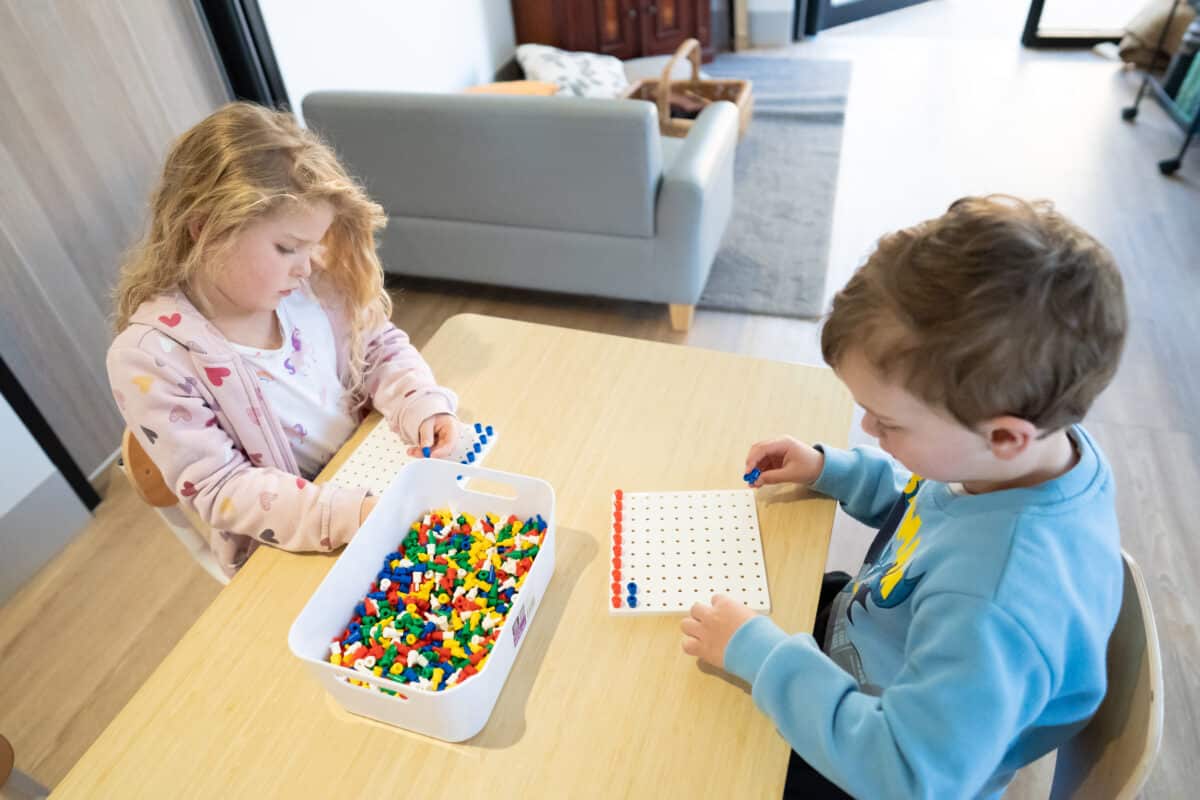
Social and Emotional Development
As your baby grows physically between the one and two year mark, so do their social and emotional skills. Responding to their cues, providing a secure and loving environment, and fostering social interactions with other children nurtures their emotional well-being.
Likewise, be sure to celebrate their achievements verbally and enthusiastically. This not only provides comfort during times of frustration or distress, but rewards children’s curiosity and insatiable hunger to discover and explore.
For parents that are returning to work during the first 1000 days, be assured that Explorers Early Learning offers opportunities for further social and cognitive development.
Overall, the first 1000 days of a child’s life is a time of immense growth and development. From prenatal care to their second birthday, this period shapes their future health, well-being, and development from the cot all the way to adulthood.
Embrace each milestone, enjoy the precious moments, and seek support when needed. Remember, every child is unique, so follow your instincts and trust your best judgement – no one knows your child better than you!
🍃 To tour one of our beautiful Centres, please click here. Otherwise, check out our website to register your interest at Explorers Early Learning today!
Long Day Care and Sessional Kindergarten: What’s the Difference?
Are you tossing up between long day care and sessional Kindergarten? What if we told you that you can get the best of both worlds through integrated Kindergarten? Read on for our breakdown of these two early learning journeys 👇
The Victorian Government’s Best Start, Best Life program, which has pledged billions into the early learning sector, is generating plenty of buzz around long day care (LDC) centres and sessional Kindergartens.
The choice between LDC and sessional Kindergarten is ultimately up to you. While some prefer the traditional style of sessional Kindergarten, more and more families are taking advantage of LDC with integrated Kindergarten Programs.
With extended operating hours and holistic learning opportunities for children, LDC is a reliable choice that combines care and education, while also accommodating families with even the busiest of schedules!
But what exactly is the difference between these two forms of early education, and how do they impact your child’s transition into primary school?
In this post, we break down the key differences between sessional Kindergarten and long day care,
Long Day Care (LDC)
LDC, often called ‘childcare’ or ‘day care’, are centre-based early learning services provided by childcare professionals (educators) for children as young as six weeks old to school age (six years old in Victoria).
These centres develop their own curriculums guided by the Early Years Leaning Framework (EYLF). Additionally, LDC services provide meals and offer a range of extracurricular activities such as languages, sports, gardening, and multi-sensory workshops.
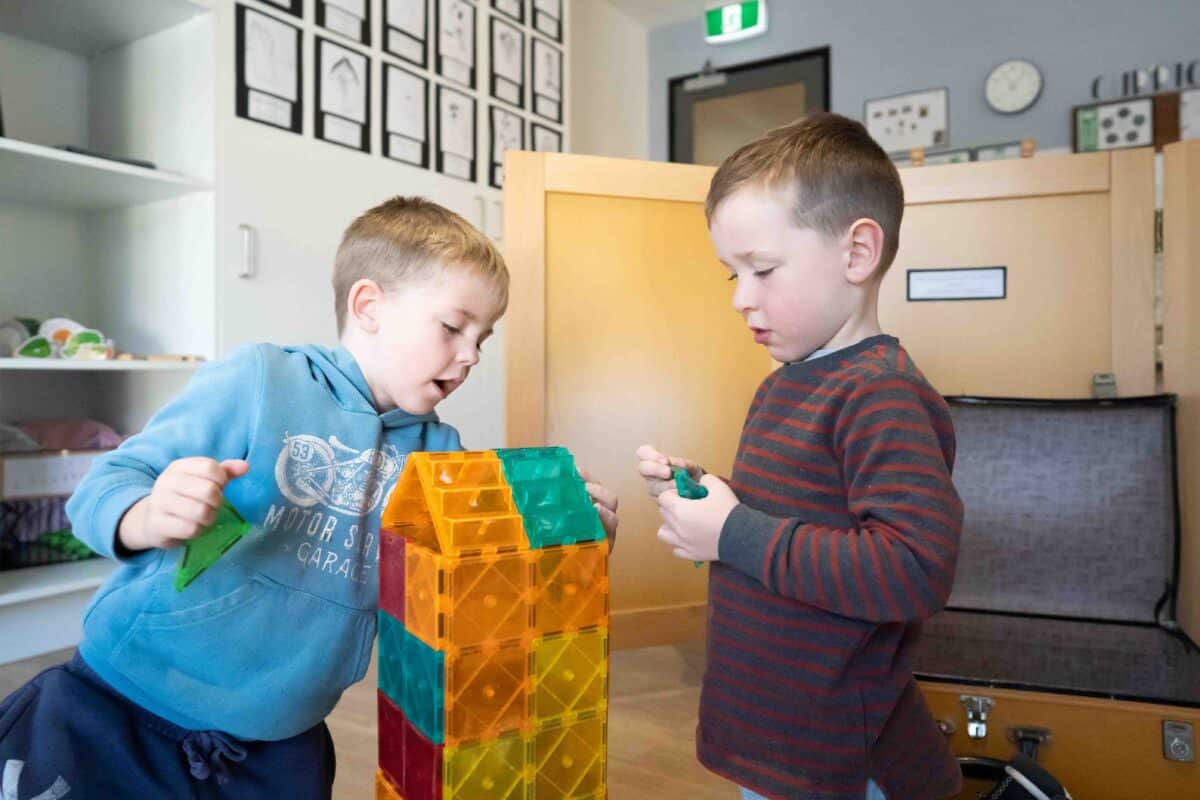
LDC centres can be privately or government owned, family-run, or operated by local community groups. However, all must meet the National Quality Standard (NQS) and are assessed and rated accordingly.
Importantly, all LDC educators are required by the Department of Education to have completed, or be actively working towards, a recognised ACECQA (Australian’s Children Education and Care Quality Authority) qualification:
- Certificate III in Early Childhood Education
- Diploma of Early Childhood Education
- Bachelor of Education (Early Childhood) or equivalent
Educators are also required to have:
- A Valid Working with Children Check
- First Aid Training
- CPR Training
- Asthma and Anaphylaxis Training
- Child Protection Training
Additionally, LDC centres operate longer hours than sessional Kindergartens, opening as early as 6am and closing as late as 7pm. Ultimately, this accommodates working and/or studying parents and guardians.
In short, the flexibility of LDC allows parents to enrol their child into care depending on their specific needs, rather than their provider’s schedule.
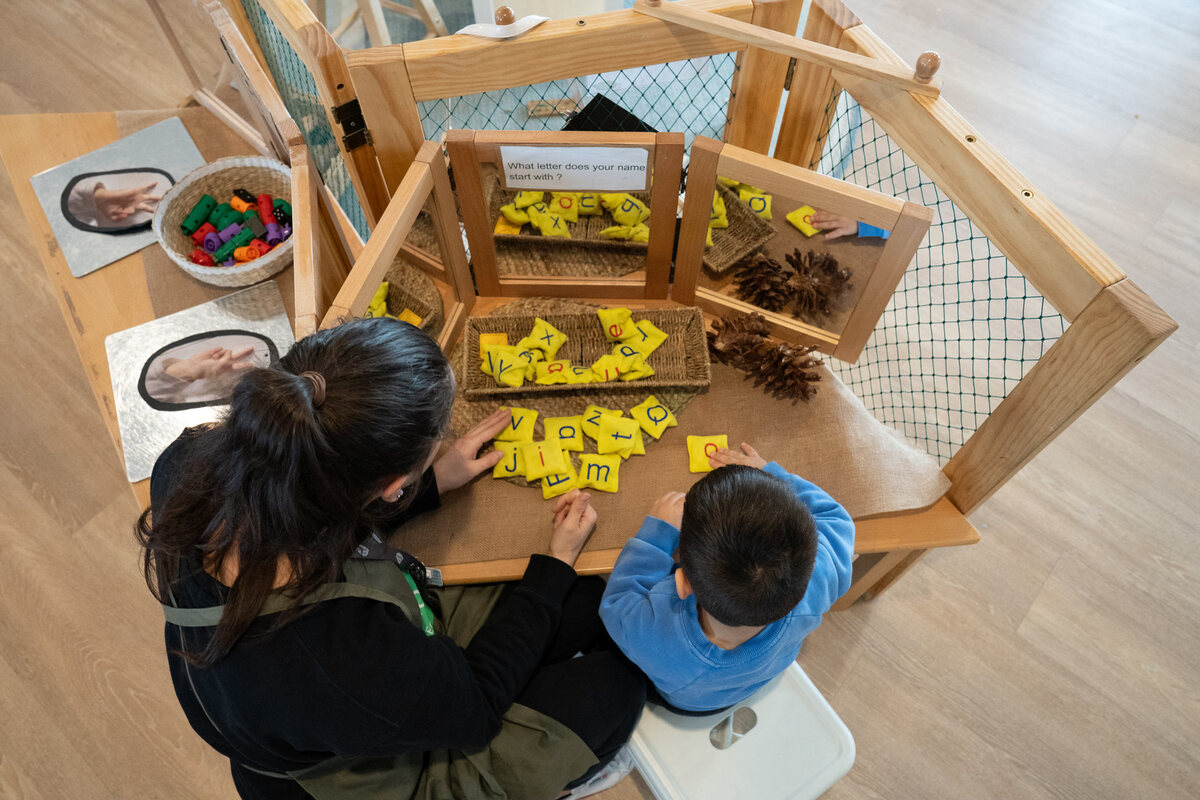
Sessional Kindergarten
Sessional Kindergarten, or ‘preschool’, is a one-to-two-year program for three and four-year old children. Notably, sessional Kindergarten differs from LDC as they operate on specified session times. Often, these are in three to five-hour blocks over two-to-three days per week.
Moreover, sessional Kindergarten can be run by local governments, churches, private companies, or independent schools and vary in fees and funding. They’re typically more formal than LDC as children often have to bring their own food, learning materials, and even wear uniforms in some services.
Kindergarten Teachers at sessional Kindergarten must hold a tertiary qualification:
- Graduate Diploma of Early Childhood Education
- Bachelor of Education (Early Childhood)
- Master of Teaching (Early Childhood)
In Victoria, Kindergarten for three and four year old children is not compulsory. Nevertheless, many parents enrol their child into sessional Kindergarten or LDC with integrated Kindergarten programs before beginning primary school.
Integrated Kindergarten at Explorers
At Explorers, we offer an integrated Kindergarten Program within our long daycare Centres which is guided by Bachelor qualified teachers across the week for our three and four-year-old children. This program gives children first-hand knowledge and confidence to begin their school journey.
Our Reggio Emilia-inspired program is carefully designed to ease children into the rhythm of primary school, rather than forcing them into a strict routine that can be overwhelming and even traumatic for some children.
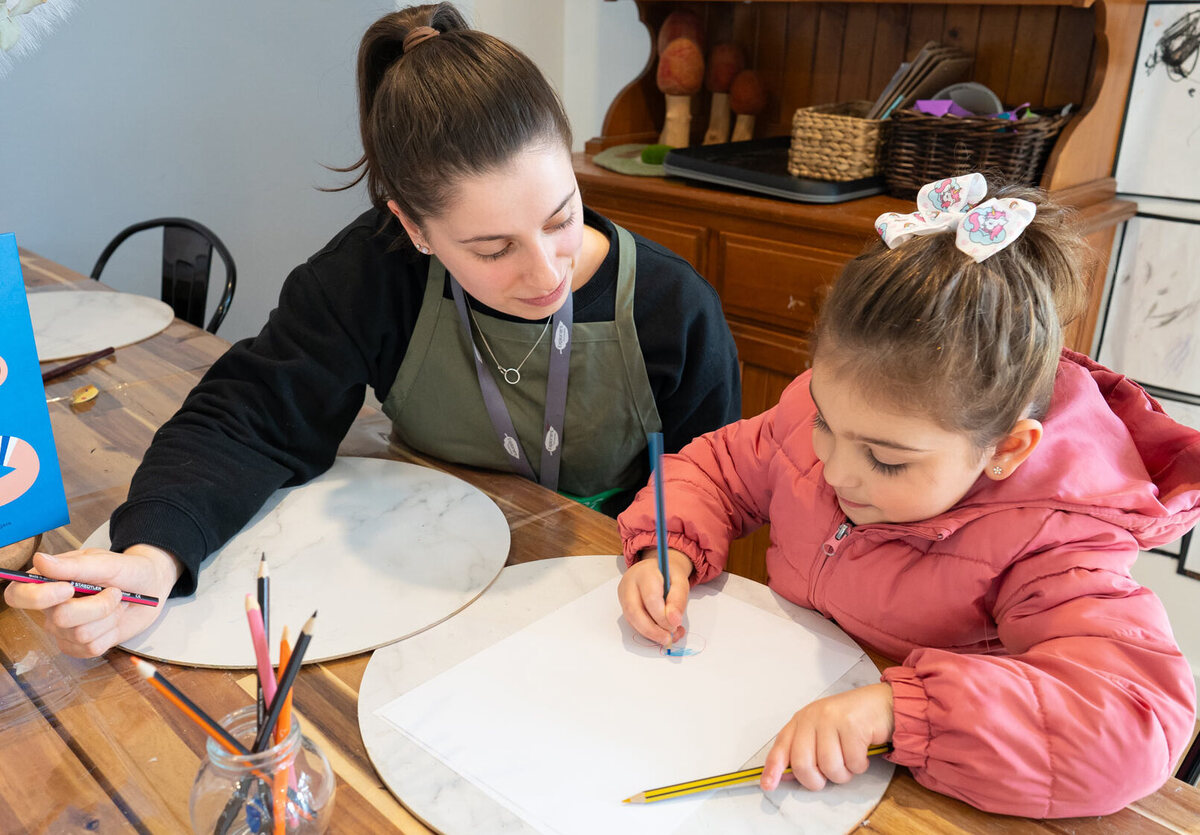
We focus on key areas of your child’s development to best prepare them for their transition to primary school:
- Wellbeing
- Self Regulation
- Cognitive Skills
- Communication
- Positive Attitudes towards Learning
- Respect for Diversity
- Autonomy
Overall, integrated Kindergarten gives you the best of both worlds. Children receive Kindergarten quality education and parents benefit from the flexibility of LDC. Learn more about Explorers Kindergarten Program.
🍃 To tour one of our beautiful Centres, please click here. Otherwise, check out our website to register your interest at Explorers Early Learning today!
Children and the Dinosaur Phase: The Benefits of Fascination
What is it with children and dinosaurs? No matter the generation, there’s no escaping the dinosaur phase! But have you ever wondered what’s behind it? It may be more important for early childhood development than you think 🦖
Is your child watching The Land Before Time on repeat? If so, they’re probably in the famous ‘dinosaur phase’ – a time when children become obsessed with all things prehistoric.
The dinosaur phase usually begins around age two or three and can last well into primary school. While it might seem like a passing fad that’ll make for some great additions to the photo album, it may also contribute to your child’s creativity and cognitive development.
In this article, we explore all the benefits of the dinosaur phase, even if your living room does become a temporary velociraptor enclosure.
Promotes Curiosity and Exploration
Children in the dinosaur phase are naturally curious about the world around them. They ask the big questions, seek answers, and investigate new ideas. Naturally, this leads to stimulating learning experiences as they read and discover how dinosaurs lived, what they ate, and how they evolved over their 165 million year reign on Earth.
Better yet, it’s a great opportunity for activities and continued learning:
- A trip to the museum
- Digging for fossils in the backyard
- Taking a nature walk
- Imaginative play in a sandpit
This curiosity and exploration can help children develop a lifelong love of learning and an appreciation for science and research.
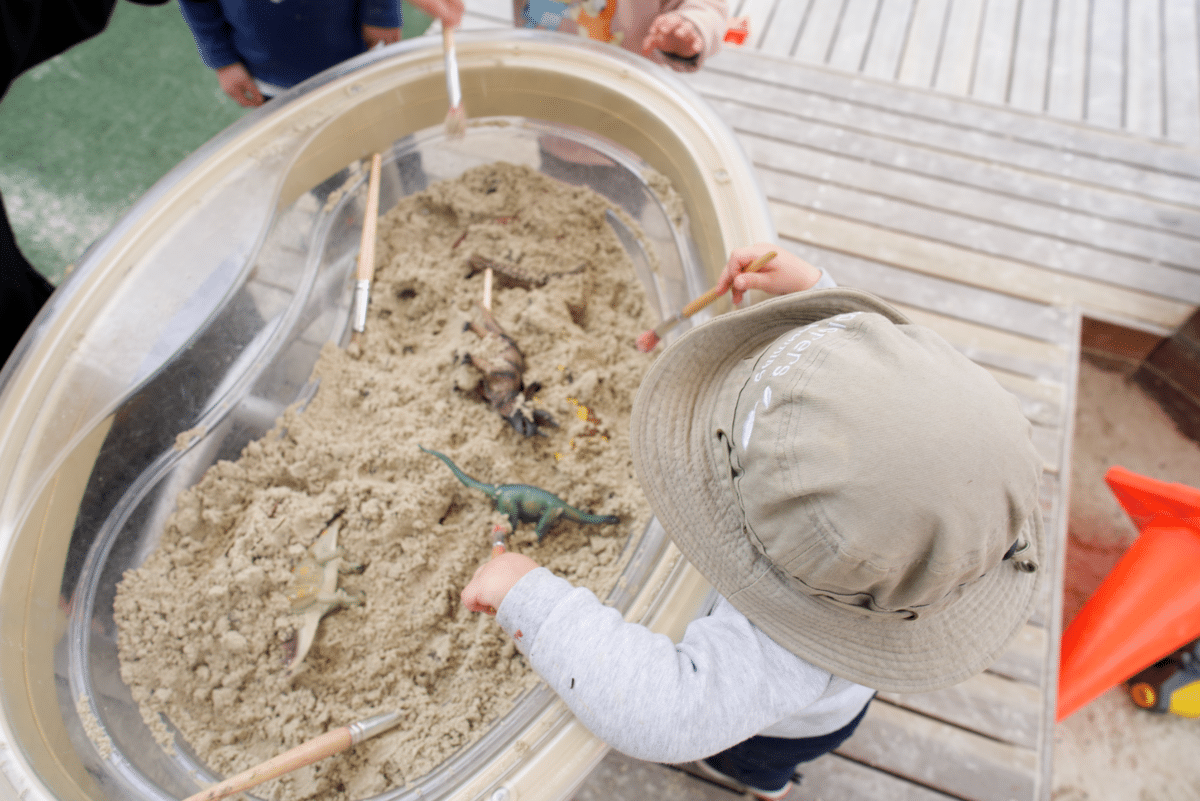
Enhanced Language Development
As children learn about dinosaurs, they’re exposed to an extensive vocabulary related to science, history, and palaeontology. Although they may not understand all of these phrases, just pronouncing them is a phonetic exercise that may lead to a better understanding of written and spoken words.
Learning to pronounce terms like ‘tyrannosaurus rex,’ ‘herbivore’ and ‘fossilisation’ create new neural pathways and stimulate cognition. This exposure to new words and concepts can help them develop language skills, improve communication, and expand vocabulary.
Make New Friends
If your toddler is going through the dinosaur phase, chances are there are many others in their childcare room, kinder, or family friends on the same journey. You can use this shared fascination to organise playdates for your child to make new friends!
In fact, according to the American Academy of Paediatrics, peer play and games are essential to their early development:
Pretend play encourages self-regulation because children must collaborate on the imaginary environment and agree about pretending and conforming to roles, which improves their ability to reason about hypothetical events.

Sparks Creativity and Imagination
By its very nature, the dinosaur phase requires imaginative play. As dinosaurs no longer exist, they naturally encourage creativity and fascination for children. This is likely because of their likeness to fictional creatures such as dragons.
You can use this fascination to encourage all kinds of creative dinosaur activities. They might draw pictures, build models, or flex their dinosaur muscles by pretending to be a humble brontosaurus or a terrifying t-rex. Likewise, this imaginative play develops creativity and encourages abstract thinking.
Puts Time and History into Perspective
At around age 4-5, children begin to understand that the world existed long before they did. Additionally, they learn that our history is fascinating and complex. Therefore, the dinosaur phase perfectly introduces children to this concept in a fun and accessible way.
Children learn about an entirely different world with its own creatures and ecosystem over 66 million years ago – the number itself enough to spark wonder and awe.
It’s sometimes said that palaeontologists are grownups that never grew out of the dinosaur phase. An early fascination with science can lead to careers in archaeology, geology, meteorology, and environmental sciences!
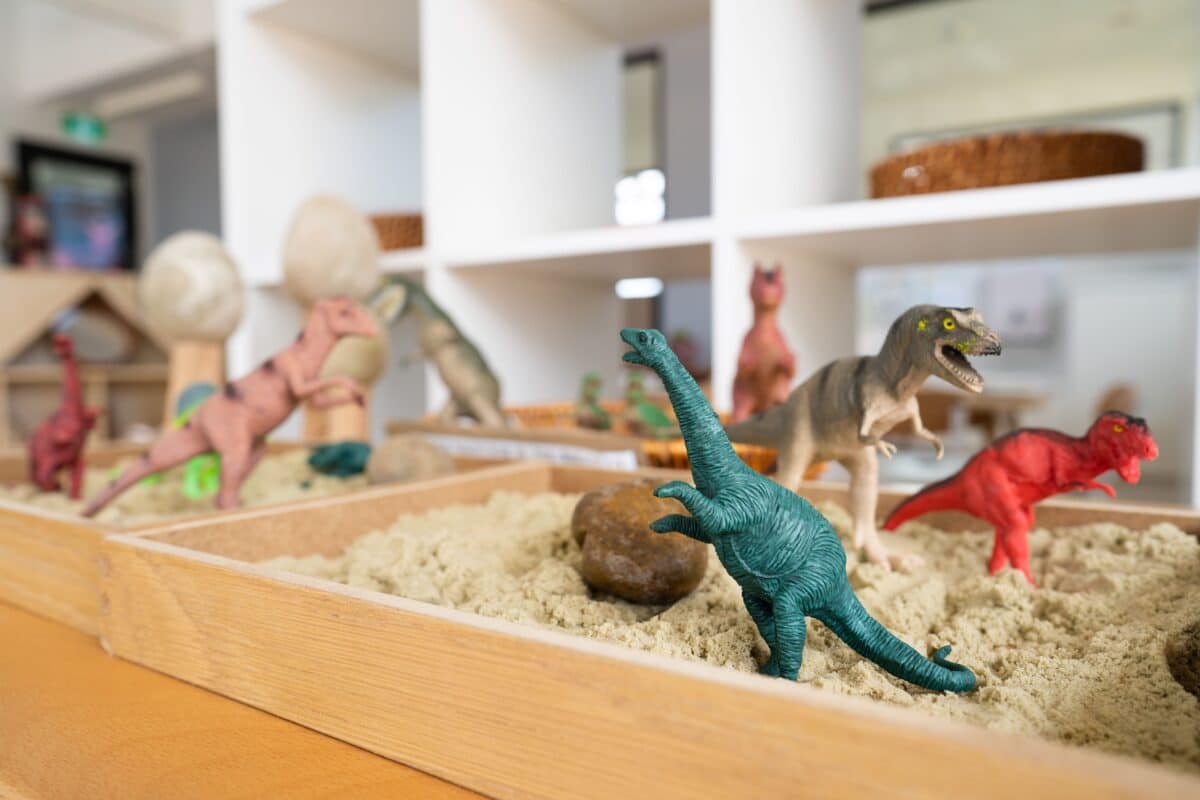
Promotes a Love of Nature and the Environment
As children learn about dinosaurs, they also learn about the environment they lived in and the impact that humans have on the planet today. This can help them develop a sense of responsibility for the natural world and a desire to preserve it.
Overall, the dinosaur phase is so much more than just a passing fad. It’s an opportunity for your child to express their creativity, independence, and foster a lifelong love of science and the natural world. So be sure to encourage their interest in dinosaurs by reading books, visiting museums, and engaging in imaginative play. Who knows, your child might grow up to discover the next dinosaur species.
🍃 To tour one of our beautiful Centres, please click here. Otherwise, check out our website to register your interest at Explorers Early Learning today!
Unlocking Inner Calm: Mindfulness Activities for Children
Looking for ways for your child to stay grounded in the here and now? Look no further than our list of mindfulness activities for children and adults alike 👇
Mindfulness for children is more important than ever in the digital age. With so much for children to do and see, it’s vital to teach them how to slow down and tap into their inner calm. After all, childhood goes so fast – you don’t want them to miss it!
In this post, we’ve curated some fun and engaging activities to help your child develop lifelong mindfulness skills.
What is Mindfulness?
Mindfulness is awareness of one’s internal state and surroundings. In other words, it’s being grounded in the here and now. While this may sound obvious, it’s easy to get overwhelmed with so many forms of entertainment and technology. And children are no exception.
Therefore, it’s important to teach children how to be grounded in the present to reduce stress, anxiety, and boost overall happiness.
In fact, experts at the CDC (Centre for Disease Control and Prevention) suggest that mindfulness and ‘connectedness to school and home is the #1 most protective factor for youth well-being and resiliency.’
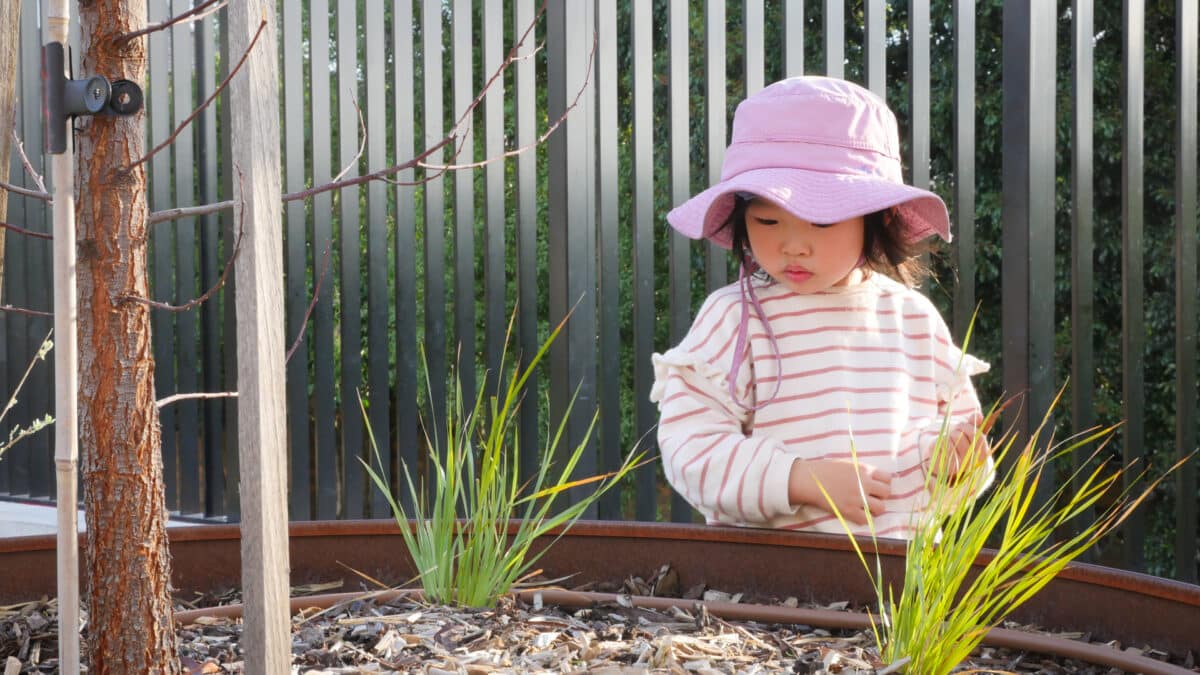
Explore the Five Senses
We use them every day, but how often do you stop to really think about your senses? Something as simple as closing your eyes and focusing on your breath can do wonders to ground yourself in the present. So, find a cosy spot, get comfy and invite your child to engage with their senses:
- Sight: Look at around you. What colours do you see? What shapes? Where is light coming from?
- Sound: What can you hear? Are there any background noises? Where are the sounds coming from?
For smell and touch, consider a sensory board filled with natural materials like sand or pebbles. For taste, you can lay out foods of differing consistencies to broaden your child’s palette:
- Smell: What does this space smell like? Is it a nice smell?
- Touch: What do they feel like? Are they soft? Hard? Scratchy?
- Taste: Describe the taste. Is it sweet? Sour? What foods also taste like that?
Sensory Nature Walk
Step into the great outdoors and embark on a nature walk together. Take your child to a nearby park, beach, or nature trail and encourage them to connect with all their senses.
Listen to the chirping of birds, feel the grass under their feet, inhale the sweet scent of flowers. This is a wonderful opportunity to get children out of the house and into nature. With each step, guide them to be fully present. What kind of animals do you see? What sounds do they make? What do they eat?
Additionally, it’s an important reminder of the beauty of our natural spaces and the need to preserve them for generations to come.
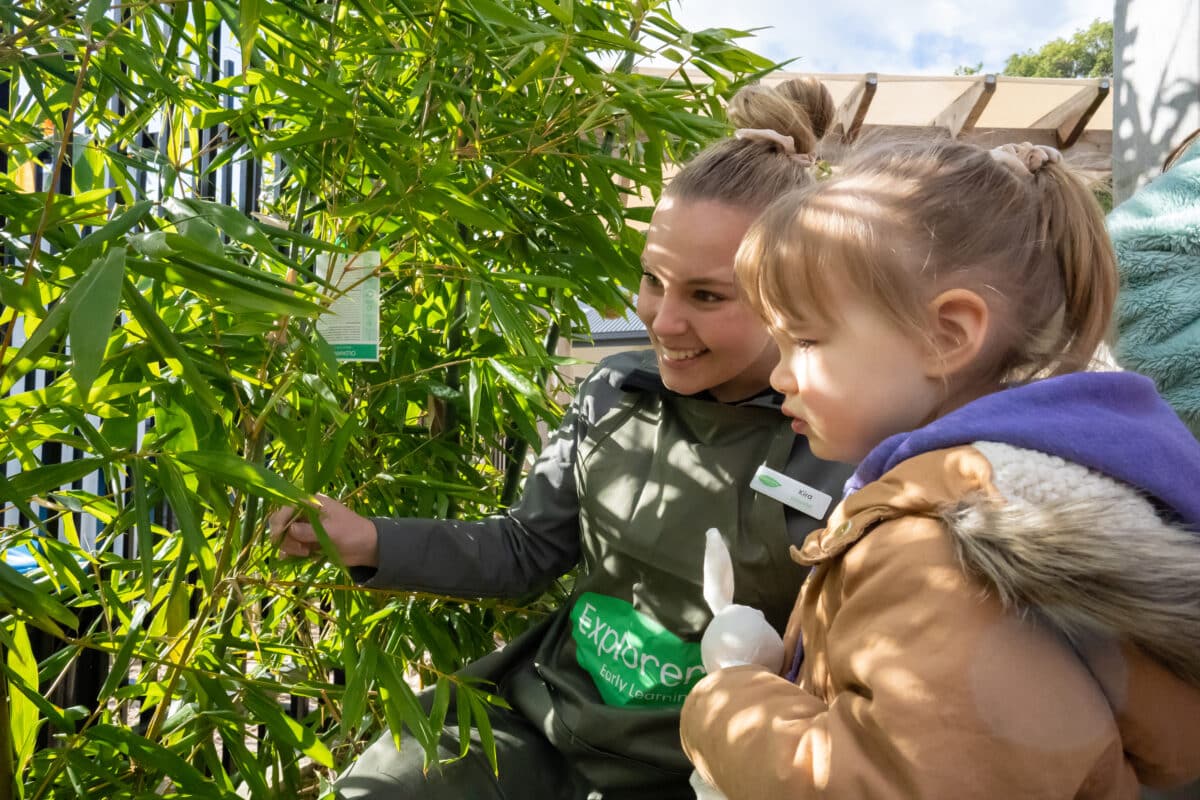
Yoga Time
Yoga is the perfect time to stretch, breathe, and relax. Clear some space and invite your child to join in a sensory yoga session. Pretend to be wild animals, mimicking their movements, and encourage them to focus on their breath.
If your child is more a visual learner, there are plenty of YouTube guides on how to strike the perfect pose – just make sure you do it together!
As they flow through various poses, highlight the importance of being present and tuning into their bodies. Wind down the adventure with a soothing relaxation exercise, allowing them to relax and find inner calm.
Mindful Art
Unleash your children’s creative spirits with mindful art! Set up an art station with natural, colourful materials and let their imagination run free. Encourage them to paint or draw with mindful awareness, feeling the brush strokes and textures of the materials.
Remind them to stay present in the moment, letting go of distractions. Remember, the aim is to let their inner artists shine while also experiencing a sense of peace and relaxation through creative expression.
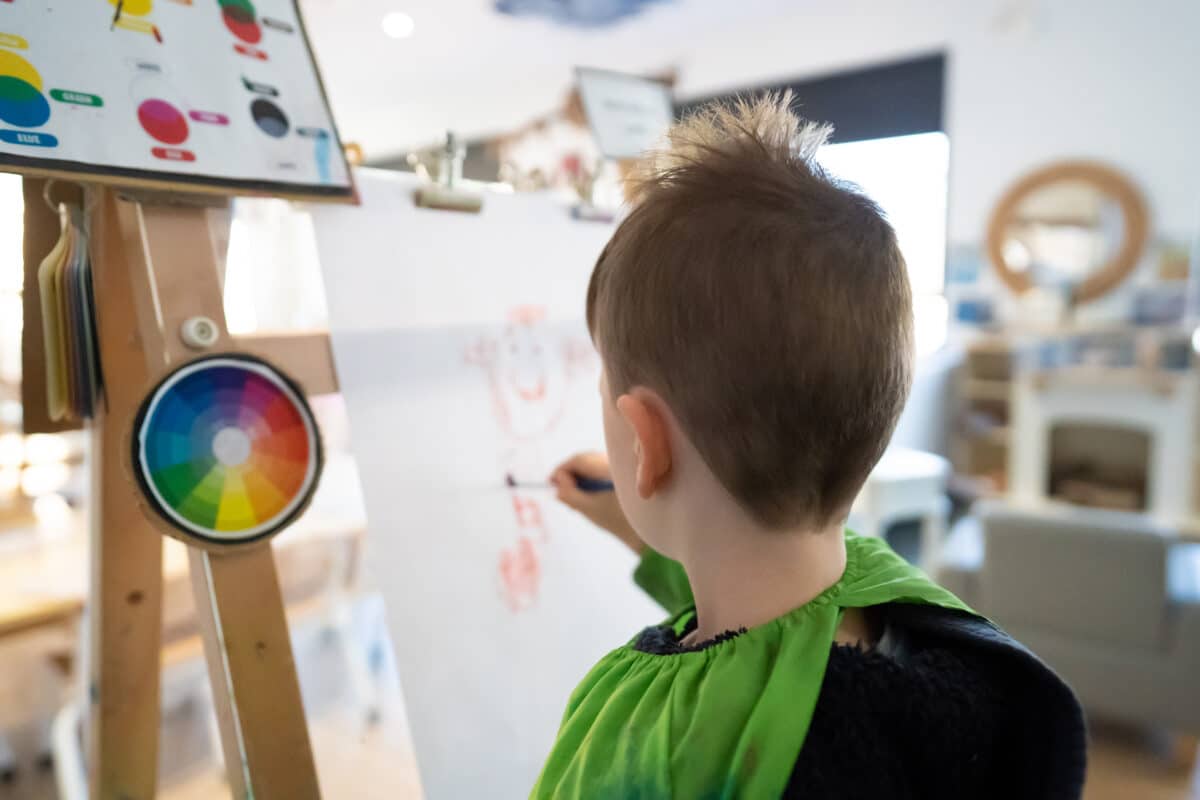
Muscle Memory
There are over 600 muscles in the human body, but when was the last time you stopped to think about them?
Invite your child to close their eyes and to consciously relax their muscles. Start slow and simple by asking them to gently squeeze their feet, and then their hands. As they progress, move to larger muscle groups like the calves, biceps, and abdomen.
This is also a great opportunity for continued learning. Explore the different kinds of muscles and bones in the body through research and discussion. You can even take a trip to Scienceworks or the Melbourne Museum!
Why is Mindfulness Important?
More and more studies are showing the profound benefits of mindfulness for children and adults alike. It’s easy to get lost in the rush of modern life but taking as little as 10-15 minutes a day to reflect and recharge can do wonders for overall joy. Likewise, teaching these skills to children at an early age is vital for long-term happiness and success.
With these engaging activities, you can introduce your child to the wonders of mindfulness while also having some fun along the way. So why not invite your child to take a breath, look around, and smell the roses?
🍃 To tour one of our beautiful Centres, please click here. Otherwise, check out our website to register your interest at Explorers Early Learning today!
Reggio Emilia and Montessori: What’s the Difference?
Reggio Emilia or Montessori? What do they mean and which is right for your child? Read on for our breakdown of these two popular early education philosophies 👇
Does this sound familiar: you’re researching childcare services and two phrases keep appearing – Reggio Emilia and Montessori. It’s easy to get lost in the wording as they both talk about child-centred curriculums and non-traditional learning.
But what if we told you these early learning approaches differ in some really important ways?
In this post, we break down the Reggio Emilia and Montessori approaches to early childhood education to help you decide which is the perfect fit for your child.
What is the Reggio Emilia Approach?
The Reggio Emilia approach, named after the Italian town where it was founded by Loris Malaguzzi, emphasises project-based learning, creativity, and community involvement.
Reggio Emilia classrooms, often connected by a central piazza for collaboration and discussion, are filled with natural materials, light, and open spaces. Children are seen as active participants in their own learning journey. They co-construct knowledge and spark curiosity alongside their peers and Educators.
The Reggio Emilia approach identifies three teachers in children’s learning:
- The teacher – responsible for constructing and guiding learning experiences. Educators provoke discussion, ask open-ended questions, and explore emerging interests with the children. In other words, they’re co-learners.
- The parent – the home environment is key to building on meaningful learning experiences. Therefore, parents are encouraged to take an active role in emerging interests, projects, and hands-on learning.
- The environment – learning spaces are designed to be aesthetically pleasing, stimulating, and interactive. Artwork, natural materials, and plenty of colour are commonplace in Reggio Emilia classrooms to inspire creativity and imagination.
What is the Montessori Approach?
Developed by Dr. Maria Montessori in the early 1900s, this approach values children’s need to explore, discover, and learn at their own pace.
The Montessori classroom is a carefully prepared environment where children can choose their own activities from a range of self-correcting materials such as puzzles and loose parts. These materials encourage children to problem-solve instinctively and without the need for strict instructions.
Additionally, the Montessori approach features hands-on learning through workshops. These aim to build independence, self-discipline, and practical life skills. Through interactive learning experiences, the Montessori approach encourages self-directed learning, rather than in large groups.
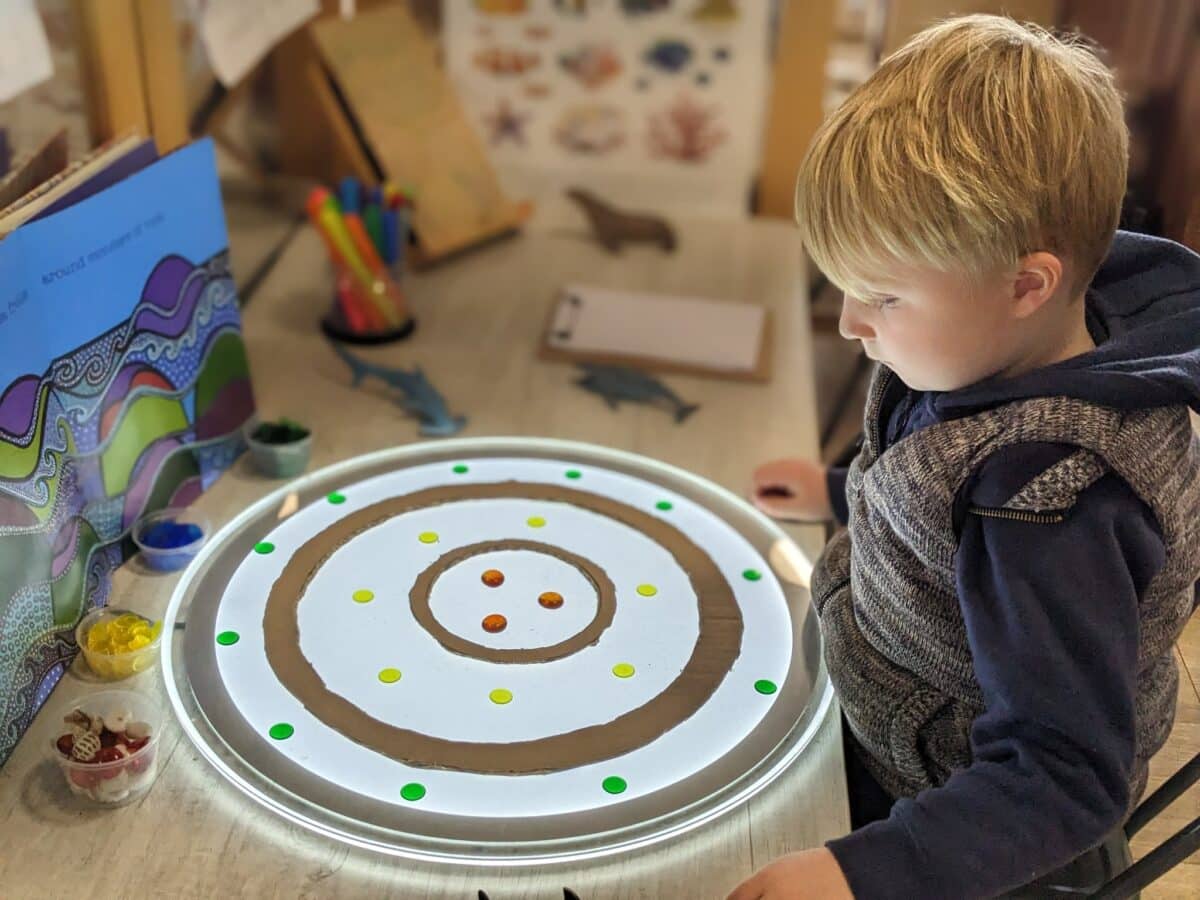
How do Reggio Emilia and Montessori Differ?
While both Montessori and Reggio Emilia value child-centred learning, they’re also different in their approach to curriculum.
Reggio Emilia embraces an emergent curriculum which evolves based on the interests and inquiries of the children. Educators encourage these interests with intentional provocations.
For example, if a child takes an interest in space, and Educator may provide them with different materials to create a star chart. This intentional experience introduces the child to different sensations – the feel of the materials and the sounds they make – while also acting as the foundation for continued learning.
How big is space? What is the Milky Way? How many planets are there in the solar system?
Montessori on the other hand follows a pre-determined curriculum, with specific materials and activities designed to support children’s development across different areas and outcomes.
Moreover, the Montessori curriculum favours observation by teachers, whereas Reggio Educators favour documentation of observations to share with parents and signpost learning milestones.
The Reggio Emilia approach emphasises community and group-based learning, while Montessori values independent and small group learning.
For a full breakdown of the differences, see the table below!
| Montessori | Reggio Emilia | |
| Learning style | Child-centric, non-traditional. | Child-centric, non-traditional |
| Role of the Educator/Teacher | Observer and facilitator of knowledge. | Collaborator and co-learner. Educators guide learning experiences and ask open-ended questions. |
| Method | Learning through play and self-correcting materials alone or in small groups. Strict development stages. | Children work in small groups in project-based learning. Community and parental involvement encouraged. |
| Curriculum | Pre-determined and can be adapted to primary and secondary education. | Fluid curriculum which is adapted to emerging interests and unique learning styles. |
| Focus | Independence. | Independence and collaboration. |
| Evidence collection | Observation. | Observe and document. |
| Goal | To form independent and curious learners. | To nurture children to become lifelong learners and citizens of the world. |
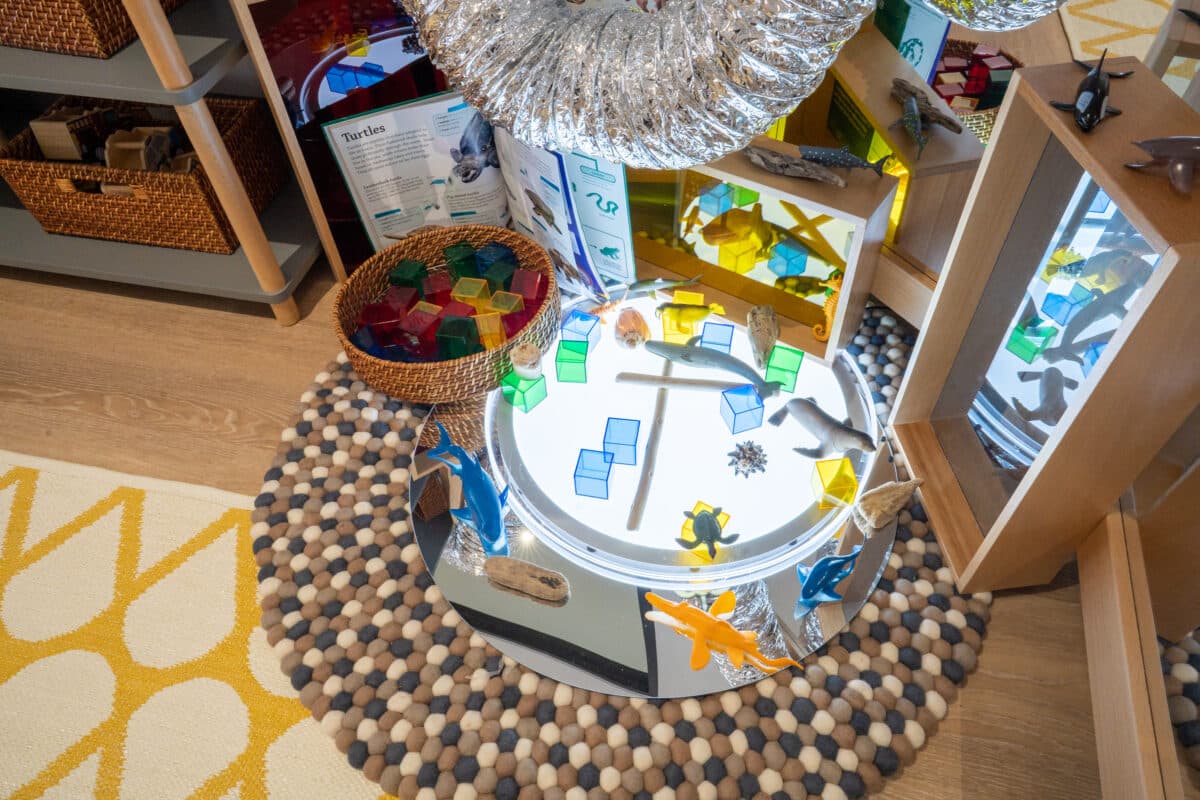
Which Approach is Right for Your Child?
Overall, it’s important to remember that there’s no one-size-fits-all approach to early childhood education. Each child is unique, with their own set of interests, learning styles, and needs. The Montessori approach and the Reggio Emilia approach each offer distinct educational experiences.
While some children may thrive in the Montessori system, others blossom in the collaborative environment of Reggio Emilia. The best way to decide is to visit centres, talk with educators, research widely, and consider all approaches. In other words, trust your intuition to decide which approach resonates with your child’s unique personality and stage of development.
🍃 To tour one of our beautiful Centres, please click here. Otherwise, check out our website to register your interest at Explorers Early Learning today!
What is the Early Years Learning Framework (EYLF)?
Belonging, Being, Becoming – these three words form the foundation of the Early Years Learning Framework (EYLF). Read on for our breakdown of this vital early education resource.
It’s easy to get lost in the sea of early education terminology from government subsidies to the countless regulatory bodies and quality advisors. However, one term you should know about is the Early Learning Years Framework (EYLF).
This comprehensive early education framework extends and enriches early education for children aged from birth to five years.
But as a 70 page Government document, it’s not exactly a quick read. To save you the time, we’ve broken down the EYLF to provide an insight into how it guides our Explorers curriculum from the nursery all the way up to those embarking on their primary school journey.
Creating the EYLF
In 2009, the Department of Education published Belonging, Being & Becoming: The Early Years Learning Framework for Australia (EYLF). While a historic moment as it was Australia’s first national Early Years Learning Framework, it was redeveloped and expanded into a V2.0 in 2022.
This national framework was developed by the Council of Australian Governments to provide a shared understanding of the foundational principles, practices, and outcomes for early childhood education and care in Australia. The EYLF is based on scientific research and empirical evidence to support all children’s education from birth to age five.
Three key principles form the foundation of the EYLF:
- Being: the importance of children’s experiences in the present moment. Children learn through play, exploration, and communication. These experiences are essential to their overall development and can’t be overlooked.
- Belonging: the need for children to feel connected to their family, community, and culture. When children feel a sense of belonging, they’re more likely to feel safe and supported in their educational environment. This principle recognises children as deeply influenced by their social and cultural context.
- Becoming: children are constantly growing and changing. Children aren’t passive recipients of knowledge, but rather active participants in their own learning and development. This principle recognises that children are competent and independent learners – a fundamental concept to the Reggio Emilia approach to early education.

Victorian Early Years Learning Framework (VEYLF)
While the EYLF is a national framework for early childhood education and care, the VEYLF caters for Victorian children specifically. However, it’s still based on the EYLF and its core principles. The VEYLF also includes additional information and guidance on the learning and development of children from birth to eight years of age.
Although both frameworks share similar goals and outcomes, the VEYLF places a greater emphasis on the development of children from birth to three years of age and focuses on cultural diversity, inclusion, and community engagement. Also, the VEYLF provides more specific guidance on how early childhood educators can support children’s learning and development in Victoria’s cultural and social context.
Five Learning Outcomes of the EYLF
The EYLF identifies five learning outcomes for children. These outcomes support children’s development and learning holistically:
- Children have a strong sense of identity.
- Children are connected with and contribute to their world.
- Children have a strong sense of wellbeing.
- Children are confident and involved learners.
- Children are effective communicators.

Explorers and the EYLF
The EYLF outlines a range of experiences and activities designed to support children’s education and growth across the five key outcomes. These experiences and activities are varied and may include music, art, outdoor play, and social interaction.
At Explorers, we embrace the power of experiences and actively embed them into our curriculum through our Enrichment Program. This Program focuses on five key areas:
- Little Impressionists – Art
- Little Linguists – Language
- Active Explorers – Physical Activity
- Prep for Prep – School Readiness
- One World, One Planet – Sustainability
Moreover, we encourage project-based learning as part of our Reggio Emilia inspired curriculum. These projects often take the form of science and the arts to form a comprehensive STEAM (science, technology, engineering, arts and mathematics) learning experience.
Music, for example, helps children expand their language and communication skills, as well as their coordination and rhythm. Likewise, science and numeracy prepare children for their academic journey in primary school, secondary school and beyond.

EYLF and the Importance of Community
Importantly, these activities build meaningful relationships between children, providing valuable lessons they transition into social situations and the household. Likewise, Educators strive to build strong relationships with children and their families. These relationships ensure our Centres remain a safe, secure, and supportive environment in which children thrive.
As outlined in the EYLF, children feel comfortable and confident when valued, respected and exposed to appropriate learning challenges. Educators, therefore, stimulate discovery by identifying and tailoring learning experiences for children’s emerging interests.
Overall, the EYLF provides a comprehensive approach to early childhood education and care. The Framework emphasises the importance of exploration and communication in children’s learning and development. Most of all, it identifies the power of play which is essential to the development of healthy and happy children!
🍃 To tour one of our beautiful Centres, please click here. Otherwise, check out our website to register your interest at Explorers Early Learning today!